|
Meinem Lehrer und Freund Prof. Dr. Heinrich von Stietencron ist die gesamte Amarakośa-Übersetzung in Dankbarkeit gewidmet. |
Zitierweise | cite as: Amarasiṃha <6./8. Jhdt. n. Chr.>: Nāmaliṅgānuśāsana (Amarakośa) / übersetzt von Alois Payer <1944 - >. -- 2. Dvitīyaṃ kāṇḍam. -- 15. vaiśyavargaḥ (Über Vaiśyas). -- 12. Vers 90c - 99: Handel III: Handelsgüter I: Besitz, Juwelen, Metalle. -- Fassung vom 2011-09-29. -- URL: http://www.payer.de/amarakosa7/amara215l.htm
Erstmals hier publiziert: 2011-09-28
Überarbeitungen: 2011-09-29 [Ergänzungen]
©opyright: Creative Commons Lizenz (Namensnennung, keine kommerzielle Nutzung, share alike)
Dieser Text ist Teil der Abteilung Sanskrit von Tüpfli's Global Village Library
|
Meinem Lehrer und Freund Prof. Dr. Heinrich von Stietencron ist die gesamte Amarakośa-Übersetzung in Dankbarkeit gewidmet. |
Falls Sie die diakritischen Zeichen nicht dargestellt bekommen, installieren Sie eine Schrift mit Diakritika wie z.B. Tahoma.
Die Devanāgarī-Zeichen sind in Unicode kodiert. Sie benötigen also eine Unicode-Devanāgarī-Schrift.
 WARNUNG: dies
ist der Versuch einer Übersetzung und Interpretation eines altindischen
Textes. Es ist keine medizinische Anleitung. Vor dem Gebrauch aller hier
genannten Heilmittel wird darum ausdrücklich gewarnt. Nur ein erfahrener,
gut ausgebildeter ayurvedischer Arzt kann Verschreibungen und Behandlungen
machen! Die Bestimmung der Pflanzennamen beruht weitgehend auf Vermutungen
kompetenter Āyurvedaspezialisten.
WARNUNG: dies
ist der Versuch einer Übersetzung und Interpretation eines altindischen
Textes. Es ist keine medizinische Anleitung. Vor dem Gebrauch aller hier
genannten Heilmittel wird darum ausdrücklich gewarnt. Nur ein erfahrener,
gut ausgebildeter ayurvedischer Arzt kann Verschreibungen und Behandlungen
machen! Die Bestimmung der Pflanzennamen beruht weitgehend auf Vermutungen
kompetenter Āyurvedaspezialisten.
| 90c./d. dravyaṃ vittaṃ svāpateyaṃ riktham ṛkthaṃ dhanaṃ vasu द्रव्यं वित्तं स्वापतेयं रिक्थम् ऋक्थं धनं वसु ।९० ख। [Bezeichnungen für Habe:]
|
Colebrooke (1807): "Substance, thing, or wealth."
द्रव्य - dravya n.: Gegenstand, Ding, Habe, Besitz
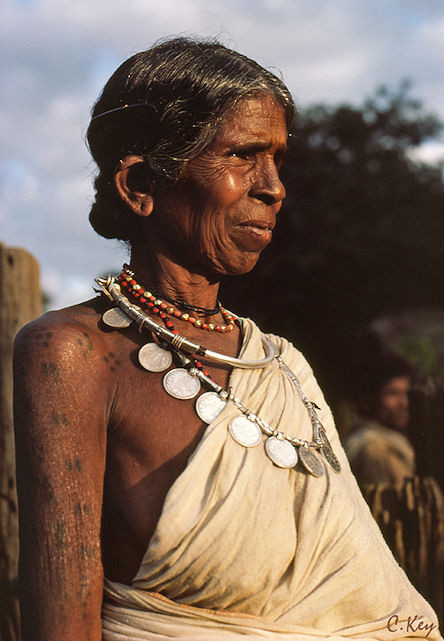
Abb.: द्रव्यम् । Narayanpur - नारायणपुर,
Chhattisgarh
[Bildquelle: Collin Key. --
http://www.flickr.com/photos/collin_key/4597549269/. -- Zugriff am
2011-09-22. --
Creative Commons Lizenz (Namensnennung, keine kommerzielle Nutzung,
keine Bearbeitung)]
वित्त - vitta n.: Fund, Besitz, Habe, Vermögen
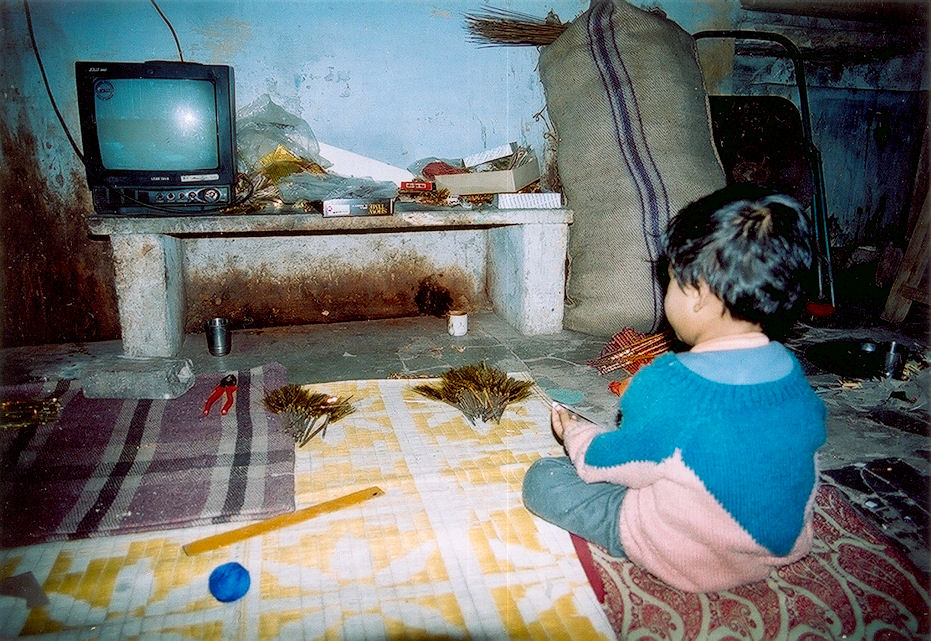
Abb.: वित्तम् । Ajmer - अजमेर,
Rajasthan
[Bildquelle: Vincent Desjardins. --
http://www.flickr.com/photos/endymion120/4874320093/. -- Zugriff am
2011-09-22. --
Creative Commons Lizenz (Namensnennung)]
स्वापतेय - svāpateya n.: Eigentum
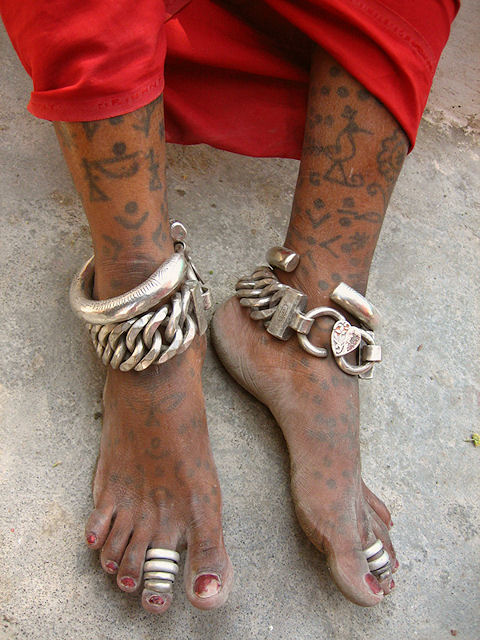
Abb.: स्वापतेयम् । Dorf-Arbeiterin, Diu - દીવ; Daman and Diu
[Bildquelle: Meena Kadri. --
http://www.flickr.com/photos/meanestindian/105210891/. -- Zugriff am
2011-09-21. --
Creative Commons Lizenz (Namensnennung, keine kommerzielle Nutzung,
keine Bearbeitung)]
रिक्थ - riktha n., ऋक्थ - ṛktha n.: Nachlass, Erbe, Vermögen, Besitz
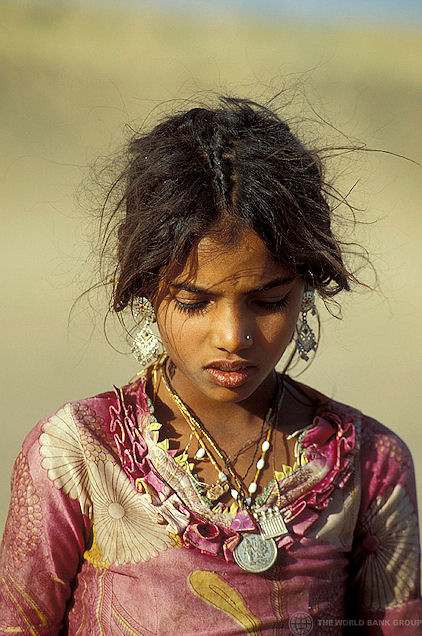
Abb.: रिक्थम् । Indien
[Bildquelle: World Bank / Curt Carnemark. --
http://www.flickr.com/photos/worldbank/2243757037/. -- Zugriff am
2011-09-22. --
Creative Commons Lizenz (Namensnennung, keine kommerzielle Nutzung,
keine Bearbeitung)]
धन - dhana n.: Beute, Gewinn, Kampfpreis, Reichtum, Geld
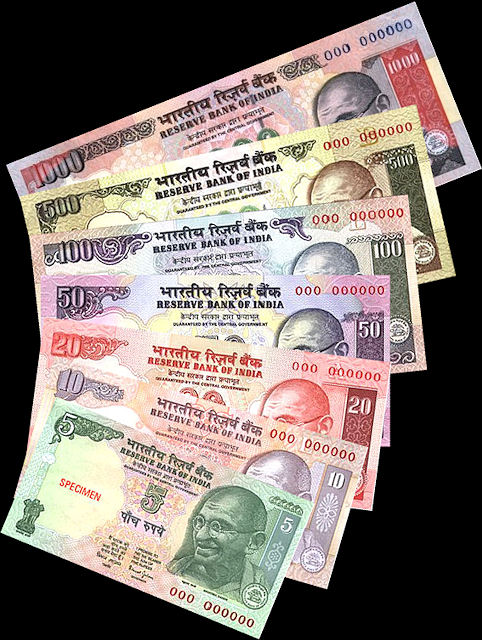
Abb.: धनम् ।
[Bildquelle: Virtualage / Wikipedia. -- Fair use]
वसु - vasu n.: Gut, Reichtum, Besitz
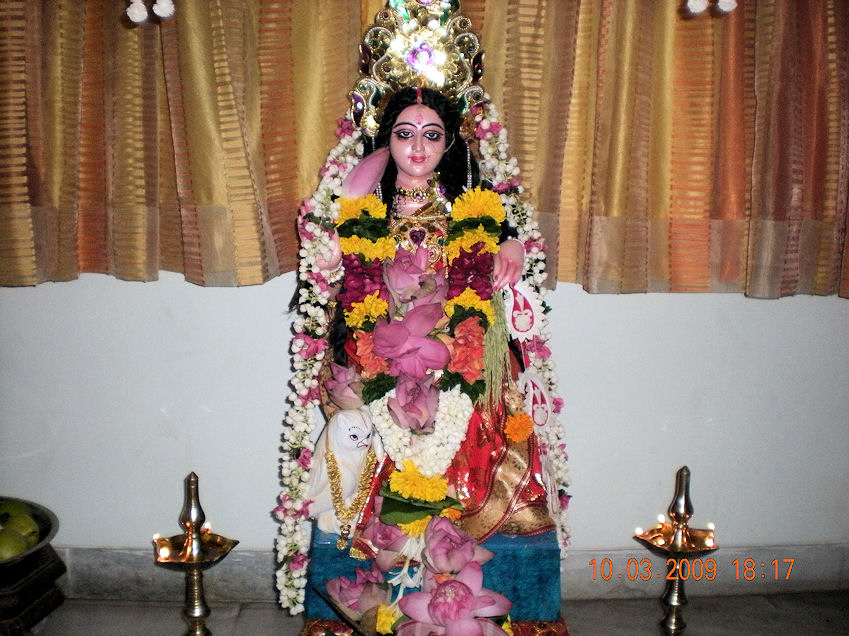
Abb.: वसु । Lakṣmī die Göttin des Reichtums, Pūjā an Śarad-pūrṇimā
[Bildquelle: Saugat22 / Wikipedia. -- GNU FDLicense]
| 91a./b. hiraṇyaṃ draviṇaṃ dyumnam artha-rai-vibhavā api हिरण्यं द्रविणं द्युम्नम् अर्थ-रै-विभवा अपि ।९१ क। [Bezeichnungen für Gold:]
|
हिरण्य - hiraṇya n.: Gold, Reichtum
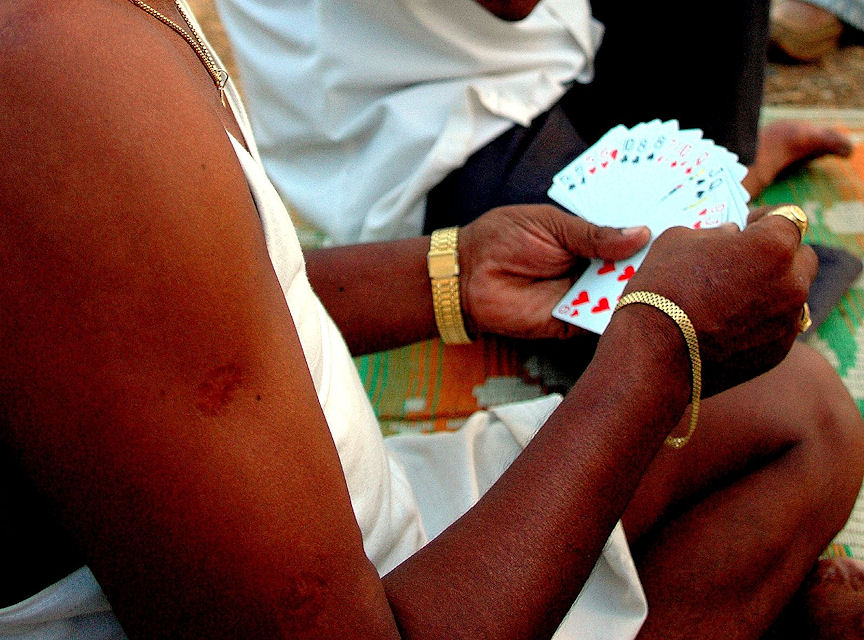
Abb.: हिरण्यम् । Mumbai - मुंबई, Maharashtra
[Bildquelle: Akshay Mahajan. --
http://www.flickr.com/photos/lecercle/359226965/. -- Zugriff am
2011-09-22. --
Creative
Commons Lizenz (Namensnennung, keine kommerzielle Nutzung, share alike)]
द्रविण - draviṇa n.: bewegliches Gut, Reichtum, Vermögen
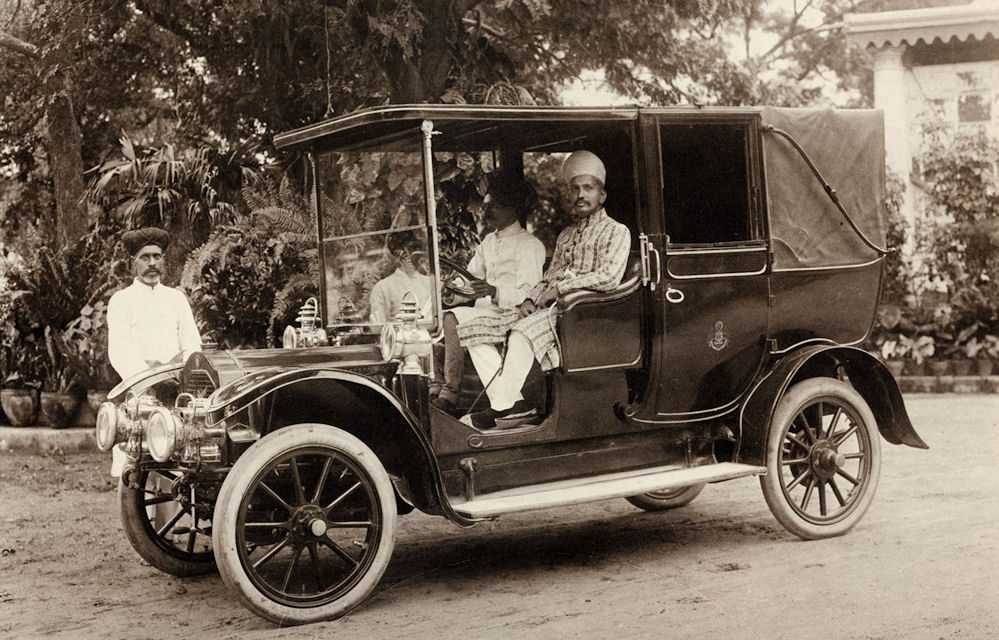
Abb.: द्रविणम् । Adeliger mit Chauffeur, Indien, ca. 1900
[Bildquelle: Raja Lala Deen Dayal (1844 - 1905)]
द्युम्न - dyumna n.: Glanz, Kraft
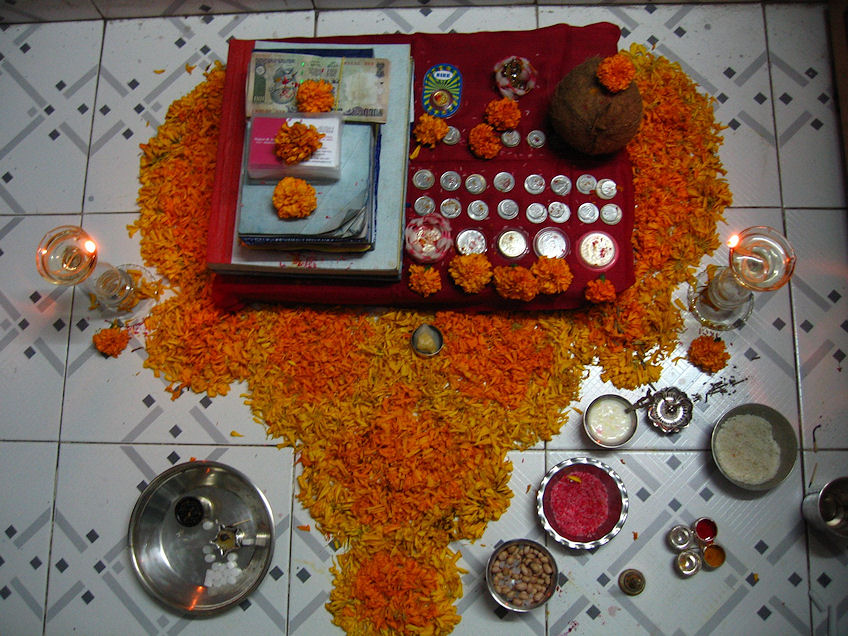
Abb.: द्युम्नम् । Pūjā für Lakṣmī die Göttin des Reichtums, Mumbai - मुंबई,
Maharashtra
[Bildquelle: Ben Piven. --
http://www.flickr.com/photos/piven/1946901109/. -- Zugriff am
2011-09-21. --
Creative Commons Lizenz (Namensnennung, keine kommerzielle Nutzung,
keine Bearbeitung)]
अर्थ - artha m: Zweck, Nutzen, Vermögen
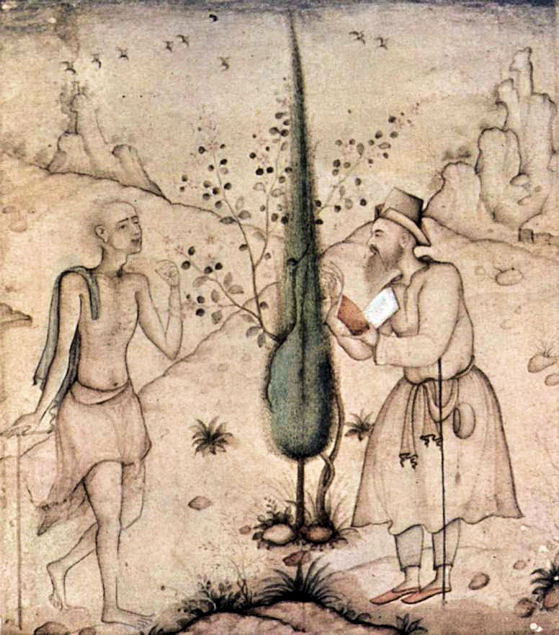
Abb.: अर्थश्च मोक्षश्च । Kaufmann und Asket, ca. 1600
रै - rai m.: Reichtum, Habe, Besitz
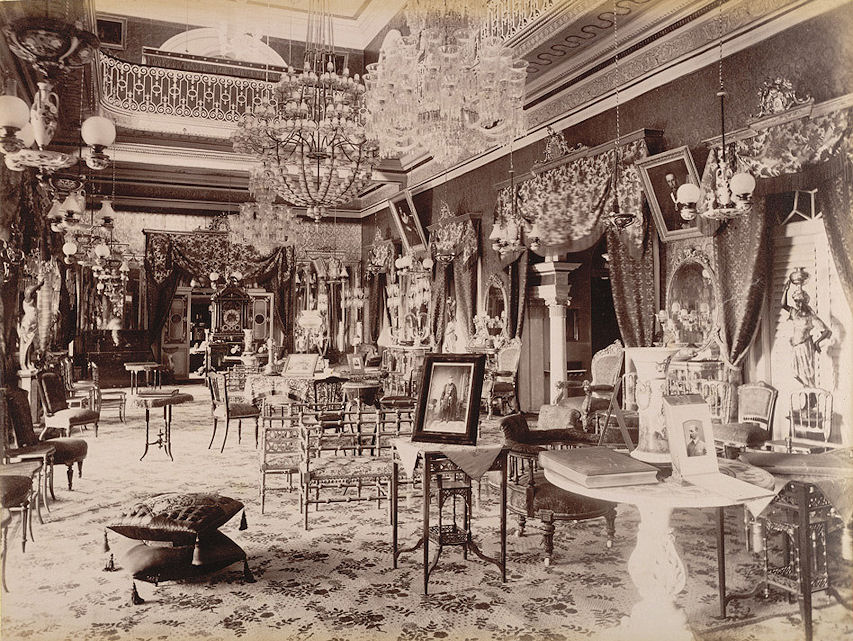
Abb.: राः । Bashir Bagh Palace, Hyderabad -
حیدرآباد, (heute:) Andhra Pradesh, um 1890
[Bildquelle: Raja Lala Deen Dayal (1844 - 1905)]
विभव - vibhava m.: Macht, Reichtum
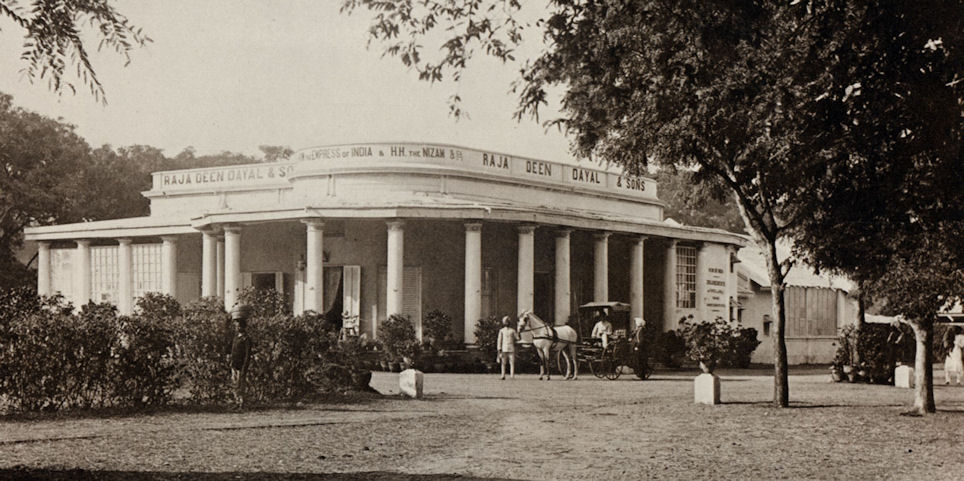
Abb.: विभवः । Das Fotostudio von Raja Deen Dayal & Sons, Hyderabad -
حیدرآباد, (heute:] Andhra Pradesh, um 1890
[Bildquelle: Raja Lala Deen Dayal (1844 - 1905)]
| 91c./d. syāt kośaś ca hiraṇyaṃ ca hema-rūpye kṛtākṛte स्यात् कोशश् च हिरण्यं च हेम-रूप्ये कृताकृते ।९१ ख। Verarbeitetes und unverarbeitetes Gold (heman) und Silber (rūpya) heißen:
|
Colebrooke (1807): "Wrought and unwrought gold, &c."
कोश - kośa m.: Behälter, Schatzbehälter, Schatz, verarbeitetes und unverarbeitetes Gold und Silber
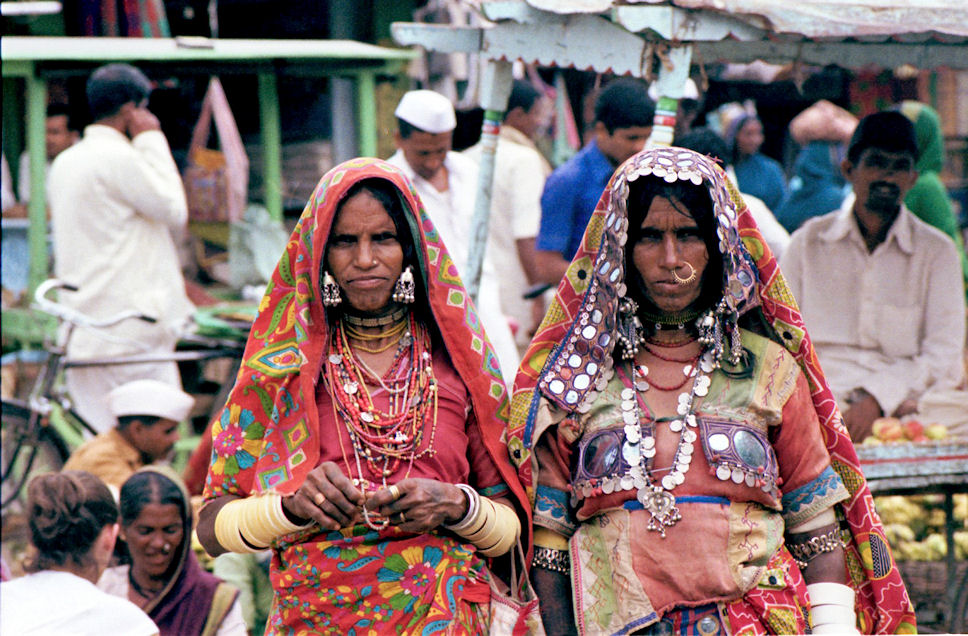
Abb.: कोशः । Bijapur
[Bildquelle: Peter Elman. --
http://www.flickr.com/photos/pepepe/4462965045/. -- Zugriff am
2011-09-27. --
Creative Commons Lizenz (Namensnennung, keine kommerzielle Nutzung,
keine Bearbeitung)]
हिरण्य - hiraṇya n.: Gold, Reichtum, verarbeitetes und unverarbeitetes Gold und Silber
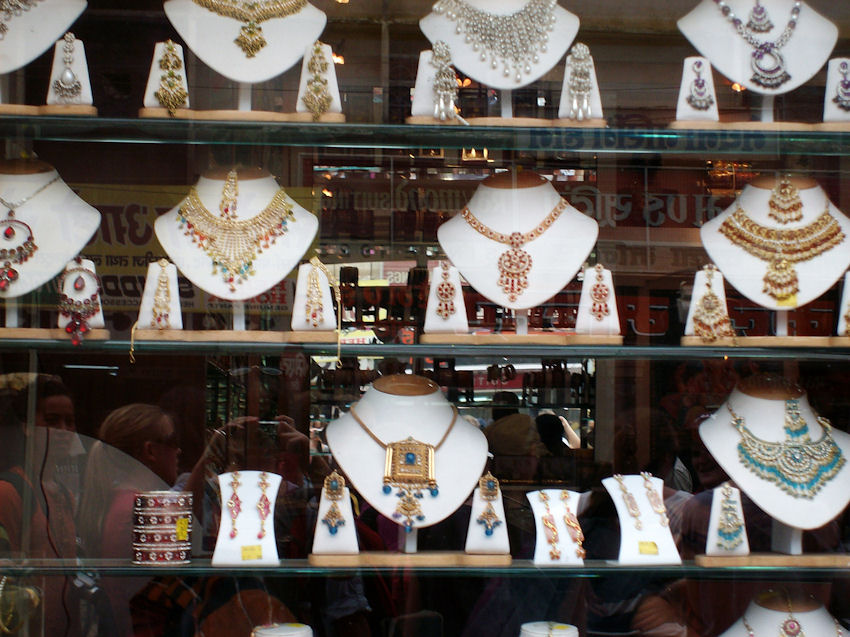
Abb.: हिरण्यम् । Indien
[Bildquelle: annemorgan71. --
http://www.flickr.com/photos/23281382@N05/3504097838/. -- Zugriff am
2011-09-27. --
Creative
Commons Lizenz (Namensnennung, share alike)]
"MINERAL or inorganic medicines are generally described under five heads, namely.
- Rasa or mercury which forms a class by itself ;
- Uparasa or metallic ores and earths.,
- Dhātu or metals,
- Lavaṇa or salts, and
- Ratna or precious stones."
[Quelle: Dutt, Uday Chand: The materia medica of the Hindus / Uday Chand Dutt. With a glossary of Indian plants by George King. -- 2. ed. with additions and alterations / by Binod Lall Sen & Ashutosh Sen. -- Calcutta, 1900. - XVIII, 356 S. -- S. 23.]
"Dreizehntes Kapitel (31. Gegenstand). Der Goldaufseher in der Edelmetallschmiede [अक्षशालायां सुवर्णाध्यक्षः].
Der Goldaufseher soll für die Gold- und Silberbearbeitungen eine Edelmetallschmiede (akṣaśālā) errichten lassen mit vier Hallen und einer Türe und so, dass die einzelnen Werkstätten nicht zusammenhängen. Mitten an die Marktstraße soll er als königlichen Goldschmied einen kunstreichen, wohlgebornen und zuverlässigen Mann hinsetzen.
Gold (hat folgende Arten): das vom Flusse Jambū, das vom Flusse Śatakumbhā, das vom Goldland Hāṭaka, das vom Fluss (oder: Berg) Veṇu, das in Śṛiṅgiśukti entstandne; (oder auch:) gediegen vorgefundnes, Waschgold und Berggold.1
Lotosstaubfadenfarbig, geschmeidig, glatt, lange tönend und leuchtend ist das beste, rotgelb das mittlere, rot das schlechteste.
Von den besten Arten ist das unreine2 weißlich gelb oder weiß. Das, wodurch es unrein ist, soll er mit der vierfachen Menge Blei wegläutern. Wird es durch den Bleizusatz brüchig, so soll er es zusammen mit trocknen Haufen3 im Gebläse schmelzen. Wird es infolge seiner Sprödheit brüchig, dann soll er es in Sesamöl und Kuhmist eingießen.4
Zeigt sich das Berggold (wörtlich das Bergwerksgold, d.h. das aus Berggestein gewonnene) infolge des Bleizusatzes brüchig, dann soll er es in durchhitzte Blätter (Platten) verwandeln und diese auf Holzblöcken klopfen.5 Oder er durchsetze es mit einer Paste aus der Wurzelknolle der kandālī und des vajra.
Silber stammt vom Berge Tuttha, vom Gauḍaland (in Assam), vom Berg Kambu und vom Bergwerk Cakravāla. Das weiße, glatte und geschmeidige ist das beste. Im gegenteiligen Fall und wenn es zerbirst, ist es fehlerhaft. Solches läutre er durch ein Viertel so viel Blei. Kommen Wülstchen (Blasen) zum Vorschein, ist es hell, leuchtend und an Farbe wie saure Milch, dann ist es rein.6
Ein suvarṇa (von 16 māṣa) aus reinem gelbwurzfarbigem Gold bildet den Feingehalt.7 Sechzehn (Minder)gehalte ergibt es, indem von da aus immer um eine weitre kākaṇī Kupfer hineingetan wird bis zur Grenze von vier (māṣa Kupfer, also einem Viertel).8
Nachdem er zuerst das (zu prüfende) Gold über den Prüfstein gezogen hat, ziehe er das Mustergold darüber.9 Wenn sich der Strich als von gleicher Farbe erweist an den Stellen (des Probiersteins), die weder vertieft noch erhöht sind, dann hat es die Goldprobe bestanden.10 Wird (vom Prüfenden beim Strichziehen) stark aufgedrückt oder nur leise darüber hingefahren,11 oder unter den Fingernägeln hervor gelber Ocker draufgepulvert, dann wisse man, dass Betrug vorliegt. Wenn man die Fingerspitzen mit Zinnober oder mit Eisenvitriol, die man in Rindsurin gelöst hat, beschmiert und damit Gold berührt wird es weiß.
Der lotosstaubfadenhafte, glatte, weiche und leuchtende (von Gold hervorgerufene) Strich12 auf dem Probierstreifen ist der vorzüglichste.
Der Stein vom Kalingaland oder vom Flusse Taptī, der die Farbe von Phaseolus Mungo hat, ist der beste Probierstein. Einer, der die Abfärbung (an allen Stellen) gleich aufnimmt, ist vorteilhaft für Kauf und Verkauf (von Gold). Einer, der der Elefantenhaut gleicht (d.h. ebenso rauh und hart ist), in seiner Färbung etwas Grünliches hat und für die Abfärbung empfänglich ist, der ist vorteilhaft für den Verkäufer. Ein harter, unebner und in der Farbe ungleicher ist für die Abfärbung unempfänglich, (also) vorteilhaft für den Käufer.13
Ist ein abgebrochnes Stück Gold an der Bruchstelle schlüpfrig anzufühlen, von gleichmäßiger Farbe, glatt, geschmeidig und leuchtend, so ist das ein vorzüglichstes. Erweist es sich bei der Erhitzung (tāpe) innen und außen als gleich im Aussehen, als lotosstaubfadenfarbig oder kuraṇḍablütenfarbig,14 dann ist es vorzüglichst. Zeigt es sich braun oder blau, dann ist es unrein.
Von Wagen und Gewichtssteinen werden wir im Kapitel vom Aufseher über Maß und Gewicht reden (Buch II, Kap. 19). Nach diesen Angaben soll er Silber und Gold verabfolgen und an sich nehmen.15
In die Edelmetallschmiede darf kein Unbefugter gehen. Wer doch dahingeht, soll vernichtet werden.16
Ein Angestellter aber, der mit Silber oder Gold (die Goldschmiede betritt), soll dessen verlustig gehen.
Die Handwerker in durchlöcherten Goldkügelchen, in Goldgeräten und in Goldschmuck,17 die Bläser (d.h. Schmelzer), die Hilfsarbeiter18 und die Reinmacher dürfen nur, nachdem ihre Kleider, Hände und geheimen Teile19 untersucht worden sind, hineinkommen und hinausgehen. All ihre Geräte und die von ihnen noch nicht vollendeten Arbeiten (prayoga) müssen an Ort und Stelle bleiben. Das Gold, das er empfangen hat, und die hergestellten Arbeiten soll er mitten im Bureau abgeben. Am Abend und am Morgen soll er alles mit dem Siegel des Herstellers und des Auftraggebers vorlegen.20
Einsetzen (kṣepaṇa), Schnursachen (guṇa) und Kleinarbeit (kṣudraka), das sind die verschiednen Arten von Goldschmiedearbeit. Einsetzen ist das Fassen von Glasperlen usw. (d.h. von Edelsteinen). Schnursachen sind die auf Faden gereihten Stücke.21 Kleinarbeit umfasst massive Dinge (wie Reife usw.), hohlräumige Gegenstände (wie Gefäße), sowie die Ziersachen, die mit durchlöcherten Kügelchen u. dgl. mehr versehen sind.
Beim Fassen von Edelsteinen wende er ein Fünftel auf die goldne Unterlage (kāñcana), ein Zehntel auf die festhaltende Einfassung (kaṭamāna).22 Silber, das mit einem Viertel so viel Kupfer gemischt ist, oder Gold, das mit einem Viertel Silber gemischt ist, heißt »hergerichtet« (saṃskṛitaka). Davor sei er auf der Hut.
Bei der Fassung von Edelsteinen zusammen mit durchlöcherten Kügelchen (mit »Tropfen«) sind drei Teile (der gesamten Goldmenge) Untergrund und zwei Teile Einfassung. Oder auch vier Teile Untergrund und drei Teile Einfassung.23
Beim Herstellen von Gefäßen u. dgl. mehr (tvaṣṭṛikarman) soll er ein Kupfergerät mit ebensoviel Gold überziehen (samyūhayet)A1.
Ein Silbergerät, sei es nun massiv (wie z.B. ein Ring) oder massiv-hohlräumig (wie Schüssel, Krug usw.) soll er mit halb so viel Gold (wie das Silber des Gefäßes usw. beträgt) überschmieren (avalepayet). Oder ein Viertel so viel Gold (wie die Silbermenge) zusammen mit geschmolznem oder pulverisiertem Sand und Zinnober möge er auftragen (vāsayet).24
Für Goldschmuck (tapanīya) nur das beste Gold.25
Feingold von vorzüglicher Farbe und Glut (surāga), zu gleichen Teilen mit Blei geläutert, in Form von durchhitzten Blättern ausgeglüht26 und mit Sindhererde (Steinsalz?) zum Aufkochen gebracht, gibt die Grundlage ab für Blau, Gelb, Weiß, Grün und die Farbe eines jungen Papageis. Und die verstärkte Form davon (tīkṣṇam asya) schimmert wie ein Pfauenhals und zeigt weiße Bruchstelle; es schillert sehr stark27 und ist gelb, wenn man es pulverisiert. Eine kākaṇī davon bildet den Farbstoff für einen suvarṇa.28
Feines Silber (tāra) oder nahezu reines (upaśuddha) wird viermal in Kupfervitriol mit (pulverisierten) Knochen, viermal in Kupfervitriol mit ebenso viel Blei (wie Kupfervitriol), viermal in trocknem Kupfervitriol, dreimal in kapāla, zweimal in Kuhmist, in dieser Weise siebenmal in Kupfervitriol geläutert und mit Sindhererde (Salzerde von Sindh; oder: mit Steinsalz?) aufgekocht – von diesem (Silber) wird dann je eine weitre kākaṇi weggenommen bis hinauf zu zwei māṣa. In Gold ist dazuzugeben. Darauf der Farbzusatz. So wird es Weißsilber (śvetatāra).29
Drei Teile geläutertes Gold, damit zweiunddreißig Teile Weißsilber zusammengeschmolzen, das wird eine rötlich weiße Legierung. (Mit ebensoviel) Kupfer (statt Gold) ergibt eine gelbe Legierung. Nachdem man geläutertes Gold (tapanīya) erhitzt hat, füge man ein Drittel30 Farbstoff dazu. Dann wird es gelbrot. Zwei Teile Weißsilber und ein Teil geläutertes Gold ergibt eine Legierung von der Farbe des Phaseolus Mungo. Wenn man es (wohl das Weißsilber) mit halb so viel Eisen31 bestreicht, wird es schwarz. Bestreicht man geläutertes Gold zwiefach mit anklebendem Goldsaft, dann bekommt es die Farbe von Papageienfedern.32
Unternimmt er dergleichen, dann mache er bei den verschiednen Färbungen (immer zuerst) eine Probe.33
Auch soll er sich auf die Behandlung34 von Eisen (tīkṣṇa) und Kupfer verstehen. Daher35 dann auch auf den Abfall bei den verschiednen Exemplaren von Diamanten, Edelsteinen, Perlen und Korallen und auf die erforderlichen Mengen (Material) bei der Herstellung von Gold- und Silberwaren.36
Die Vorzüge eines aus Gold gemachten Schmuckstücks (tapanīya) sind nach der Überlieferung diese: von gleichmäßiger Färbung und Glut, ein Teil genau wie der ihm entsprechende andre,37 die (dabei) verwendeten durchlöcherten Kügelchen nicht aneinanderklebend, solid, wohl poliert, unverfälscht,38 in sich zusammenstimmend, beim Tragen angenehm, geschmackvoll,39 glanzbegabt, ge fällig in der Form, ebenmäßig, das Gemüt und das Auge ergötzend.
Fußnoten
1 Nach den Indern: »vom Berg Śatakumbha«, und: »vom Bergwerk Hāṭaka. Śṛiṅgiśukti ist nach Gaṇ. ein Goldland. Könnte es heißen: aus der gehörnten Muschel entstanden«? Die Farbe soll bei den verschiedenen Arten immer verschieden sein. Man findet die Angaben bei Bhaṭṭ. und danach bei Sham. und Jolly. Jātarūpa von angeborener Gestalt oder Schönheit scheint gediegen vorgefundenes zu sein, rasaviddha »flüssigkeitdurchsetzt«, also wohl Waschgold. 315, 2 heißt rasaviddha giftdurchsetzt, vergiftet. Freilich haben wir ja schon vyadh, vedhana usw. als t. t. für das vom »Goldsaft« ausgehehende Durchdringen anderer Metalle kennen lernen, d.h. für deren Verwandeln in Gold. So muss man vielleicht rasaviddha nach 84, 2–4 und 10 verstehen und übersetzen: »durch Goldsaft erzeugtes.« Die ind. Lex. sagen ja, das Wort bedeute »künstliches Gold«. »Mit Quecksilber amalgamiert« (Sham: und Jolly) aber ist gewiss verkehrt. Trifft meine Übersetzung das Richtige, dann haben wir wieder die drei: bhūmidhātu, rasadhātu und prastaradhātu (60, 7; 81, 16). Ākarodgata wird auf jeden Fall = prastaradhātu Golderz in Gestein, Berggold sein.
2 Wörtl.: »das nicht dahingelangte«, also das unvollkommene. Gaṇ. zieht śreṣṭānām zum vorhergehenden Satz: »Von den besten Arten (Gold) ist das vorzüglichste staubfadenfarbig« usw. Dann hätten wir hier einfach: »Weißlichgelb oder weiß ist das unvollkommene.« Śreṣṭāṇām macht an beiden Orten Schwierigkeiten, bei Gaṇ.'s Auffassung aber mehr.
3 Paṭala »Haufen«, wie wir das Wort gebrauchen, nur eingeschränkt auf Kuhfladen und zwar nach dem Kom. sogar auf den trockenen vom Walde, wo ja das Vieh weidet.
4 Soll er damit infusieren, durchsetzen (niṣecayet).
5 Pākapattra »Durchhitzungsblatt« kehrt 88, 7 wieder, und pattra für ein Blatt, eine Platte, eine Schicht Metall haben wir öfters im Folgenden. Gaṇḍikā ist ein entästeter Baumstamm, ein Baumblock. So 206, 6; 363, 11. Dann überhaupt ein Holzblock wie im Pāli (Jāt. II, 124; III, 4; IV, 167, wohl auch Vin. II, 110; 136[?]; IV, 68[?]). Wahrscheinlich auch Balken, Stange oder Leiste (Vin. II, 172). Vgl. Pāli gaṇḍi Block, Richtblock (Jāt. III, 41, Z. 14; V, 303, Z. 24 und Str. 45).
6 Oder: »ist es frei von Wülstchen (Blasen)«? Es kommt wohl darauf an, ob an die noch heiße, flüssige Masse oder an das erkaltete Metall gedacht ist.
7 Bildet das Standard. Nur dies Wort entspricht wirklich. Varṇaka ist etwa = prativarṇaka 110, 13, also sample, Muster; dann Maßstab, Urbild, Ausgangspunkt und Sorte. Vgl. auch die im PW unter varṇaka aus dem Kathās. und der Rājat. angeführten Stellen.
8 Die Einheit eines survarṇa, d.h. eine Goldmenge im Gewicht von Goldmāṣa bildet also den Ausgangspunkt oder die Grundlage (s. Kap. 19, Text S. 103, 3 f.). Die wörtliche Übersetzung unserer Stelle, bei der man zunächst 88, 14 heranziehen muss, lautet: »Davon dann der von einer kākaṇī Kupfer anfangende und um je eine kākaṇī ansteigende Abzug bis zur Grenze« usw.; also apasārin + tā. Oder, und das ist das Wahrscheinlichere, man muss śulbena kākaṇy uttarāpasaritā lesen: »Davon wird im Austausch um Kupfer (immer) eine weitere (überzählige) kākaṇī (Gold) weggenommen«. Diese zweite Möglichkeit wird durch 91, 1 ff. nahegelegt. Uttarā »eine weitere« heißt dabei eine je um eins fortschreitende, anwachsende. Auch uttara weiter = überzählig wird mithereinspielen. Bhaṭṭ's Erklärung ist in der Sache ganz richtig, und über den Sinn kann kein Zweifel sein. Gold im Gewicht und Wert von einer kākaṇī, d.h. 1/64 des survarṇa, wird weggenommen und dafür ebensoviel Kupfer dazu getan. Das ergibt den ersten Mindergehalt, wo das Gold aus Teilen Gold und einem Teil Kupfer besteht. Beim zweiten wird für 2 kākaṇī Gold weggetan und 2 kākaṇī Kupfer hineingemischt. So hinauf bis zum 16. Mindergehalt, der sich aus 48 Teilen Gold und 16 Teilen Kupfer zusammensetzt. Dadurch erhalten wir zusammen mit dem Standard, dem Feingehalt oder Grundmuster, 17 Grade der Goldhaltigkeit.
9 Prativarṇikā 89, 3 bedeutet Probemuster, Versuchsmuster; prativarṇaka 62, 14; 110, 13 Muster. So wird wohl varṇikā etwa dasselbe heißen und Bhaṭṭ. recht haben, der freilich varṇaka liest. Sham., Sorabji und Jolly hätten die Geschichte nicht umdrehen sollen. In der Sache freilich kommt es schließlich auf das Gleiche hinaus. Aber auch die Inder werden doch nicht bloß das völlig reine Gold, den »Feingehalt«, als Prüfungsnorm von Legierungen verwendet haben, sondern, wie wir, eben auch Legierungen von bekanntem Gehalt.
10 Nikaṣita »geprüfsteint« oder »gegoldstricht«, d.h. auf dem Prüfstein oder durch den Strich auf dem Prüfstein als richtig befunden. Der vākyaśeṣa der indischen Erklärer ist also, soweit ich sehe, ganz unnötig. Die Bedeutungsentwicklung wäre vollkommen natürlich. – Statt animnonnate ist wahrscheinlich nimnonnate »an den vertieften und den erhöhten Stellen« einzusetzen.
11 Wörtlich: »daran geleckt« (parilīḍha).
12 Nicht nur das Neutr., sondern auch das Mask. nikaṣa hat neben der bekannten Bedeutung auch die des Striches auf dem Probierstein. Vgl. Kalāv. VIII, 4, wo mandaruciḥ gelesen werden muss. In unserem Text ist sakesaraḥ und nikaṣarāgaḥ richtig, wie schon Bhaṭṭ. hat.
13 Pratirāgin »der Abfärbung entsprechend, reagierend auf die Abfärbung«. Danach ist wohl samarāgin 86, 19 zu verstehen und folglich von Gaṇ. richtig erklärt. Mit ihm, muss im folgenden Satz chedaś statt śvetaś gelesen werden.
14 Kuraṇḍaka ist gelber Amaranth oder gelbe Barleria.
15 Wohl den Angaben jenes Kapitels. Aber auch die Lehren des vorliegenden Kapitels können gemeint sein.
16 Vgl. 26, 13–14. Da ist offenbar gemeint, der Betr. soll getötet werden. Also wird es hier nicht anders sein und wird Sham. recht haben, nicht aber Gaṇ., der da meint, es solle ihm all sein Gut genommen werden. Nichtangestellter (anāyukta) ist natürlich einer, der nicht in der Edelmetallschmiede beschäftigt ist. Von unredlichen Goldschmieden ist hier keine Rede.
17 Kāñcanapṛiṣata »Goldtropfen«. Die pṛiṣata werden wohl von Sham. richtig als durchlöcherte Kügelchen verstanden. Doch trennen er und Gaṇ., wohl nach Bhaṭṭ.'s Vorgang, kāñcana ab und sehen in den kāñcānakāru dann natürlich »Arbeiter in Gold«, was sich sonderbar ausnimmt. Gaṇ. meint, es seien die Leute, die geschickt seien, künstliches Gold zu machen. Ist kāñcanam allein in 87, 19 richtig und bezeichnet es also die Goldunterlage bei der Fassung von Edelsteinen, so möchte ich lieber die kāñcanakāru für die Künstler halten, die Edelsteine fassen. Bei denen schiene solch eine genaue Untersuchung auch nötiger zu sein als bei den Goldmachern. Tvaṣtṛikarman »Baumeisterarbeit«, vielleicht mit Hinblick auf Tvaṣṭar, den Verfertiger der Werkzeuge der Götter, ist nach Ausweis von 88, 4 ff. die Herstellung von Geräten (Gefäßen usw.). Tapanīya bezeichnet hier Goldschmuck, Goldsachen, die man trägt, wie die Schlußverse des Kapitels dartun.
18 Caraka wird hier von Sorabji und Gaṇ. wohl richtig paricāraka gleichgesetzt. Spion kann es hier kaum bedeuten.
19 Die Frauen können sich mit Hilfe der ihrigen ja die Schätze Golkondas aneignen. Für solch bequeme Schmuggelgelegenheit hatten die altindischen Schmuggelschnüffler jedenfalls eine bessere Nase als die unsrigen. Beim männlichen Gliede nun geht die Sache unendlich viel schlechter. Trotzdem wird guhya hier auch seine gewöhnliche Bedeutung haben, nicht nur die seltene, nach dem PW nur einmal, und da nicht völlig sicher belegte »After«, die hier allein statthaft scheinen möchte. Die altindischen Langfinger waren gewiss auch in diesem Stück fähig, sich zu großer Virtuosität zu trainieren. Überhaupt: Man hat viel vom Heroismus der Tugend geredet. Doch lassen wir die Tugend; sie ist nicht mehr salonfähig. Käme der homo sapiens einmal dahin, dass er ein Hundertstel des Heroismus, den er nicht nur für den Krieg, sondern auch für all seine anderen Verbrechen und Laster aufbringt, dem Dienste edler, wahrhaft freier Menschlichkeit widmete, welch ein Wunderort könnte noch diese klägliche Erde werden! Doch Träume sind Schäume. Wir haben's mit dir zu tun, o Kauṭilya. Warum wird denn der Mund nicht untersucht? Sogar mehr Gold kann jemand in diesem tragen, als ein Johannes Chrysostomos und die Morgenstunde zusammen.
20 Kārayitar wäre am ehesten der Besteller. Aber wie könnte der jeden Abend in die Goldschmiede kommen? Also am Ende doch der Anordner, der Vormann? Im Bureau wird genaue Kontrolle geführt. Das Gold, das der Goldschmied zur Verarbeitung erhält, und die fertigen Arbeiten (man muss wohl kṛitaṃ statt dhṛitaṃ lesen) hat er vorzulegen, ebenso jeden Morgen und Abend alles Wertvolle mit den genannten Siegeln dran, damit man im Bureau zu sehen vermag, dass in der Nacht nichts angetastet worden ist. Dem Goldschmied selber wäre natürlich nicht zu trauen, obgleich er »von guter Geburt und vertrauenswürdig« ist (85, 12 f.).
21 Also aufgereihte Gehänge wie Halsschnüre, Gürtel usw. Wörtlich: »das Weben von Schnüren usw.«.
22 Vgl. 88, 2–3 und 16 und verliere dein letztes bisschen Sicherheit! Im Text fasse ich es also so auf, dass zwei Zehntel des ganzen Schmuckes oder Zierstückes aus goldener Unterlage, ein Zehntel aus der Seiteneinfassung der Steine usw. bestehe. Möglich wäre auch: »ein Fünftel soviel Gold, wie die Edelsteine oder der Edelstein ausmachen« und »ein Zehntel soviel«. So hat es offenbar Bhaṭṭ. verstanden; denn er sagt: maṇeḥ (so lese ich statt des maṇau bei Sorabji und finde meine Mutmaßung durch Gaṇ. bestätigt) pañcamaṃ bhāgaṃ talabhāgakāñcanam ity ādhārasuvarṇaṃ praveśayet. Das setzt freilich große Edelsteine voraus. Vergleicht man nun aber 88, 2–3, so schiene trotz der schweren sachlichen Bedenken: »fünf Teile Gold als Unterlage und zehn Teile als Befestigung« nötig zu sein. D.h. ein Drittel der ganzen verwendeten Goldmasse käme auf die Unterlage und zwei Drittel auf die Einfassung. Das klingt aber höchst sonderbar. Dass kāñcana = GoldunterlageA2 sei, ist ebenfalls recht unsicher. Man wird am Ende doch kāñcanavāstukaṃ oder kāñcanaṃ vāstukam lesen müssen unter Vergleichung mit 88, 2 ff. – Gaṇ. liest kaṭumānam, Bhaṭṭ. haṭamānam. Kaṭamāna (vielleicht besser kaṭimāna) »Hüftenmaß« oder »Hüftenbau« sieht sehr vernünftig aus. Mit kaṭumāna aber sitzt man ganz auf dem Trockenen.
23 So nach Gaṇ.'s Text. Von der Schwierigkeit, die sich aus der Vergleichung mit 87, 19 ergibt, ganz zu schweigen, so ist schon das hi höchst sonderbar. Auch Gaṇ. hat es. Soll man dvibhāgāḥ, lesen: »drei zwiefache Teile« usw., d.h. zwiefach im Verhältnis zu dem Gefassten, sodass also hier Untergrund und Einfassung doppelt so viel ausmachen als das Gefasste oder gar 10, bzw. 14 mal so viel? Das klänge recht toll. So ist auch diese auf den ersten Blick ganz klare Stelle sehr dunkel.
24 Doch wohl weniger wahrscheinlich: »Oder eins, das aus einem Viertel Gold (und drei Vierteln Silber) besteht, möge er mit einer flüssigen oder einer pulverisierten Mischung aus Sand und Zinnober bekleiden« (vāsayet von vas, vaste). Vā, das freilich bei Gaṇ. fehlt, deutet aber am natürlichsten auf diese Auslegung. Sprachlich unmöglich ist die von Gaṇ.
25 Verwunderlich ist bei der bisherigen Auffassung, auf die ich zuerst verfiel, 1. dass da der doch so wichtige Goldschmuck keine Berücksichtigung fände, 2. dass die Beschreibung des Goldes für die Farbtinktur doch allzu überlastet wäre. Wörtlich also wohl doch lieber: »Goldschmuck ist das beste« (Gold).
26 Und auch auf dem Holzblock gehämmert (wie 86, 3)? Nach Bhaṭṭ. dem alle anderen folgen: »mit trockenem Kuhmist zum Schmelzen gebracht«. Aber 86, 3 kommt man mit dieser Bedeutung kaum zurecht, obgleich pākapattra »Backblätter« ganz gut trockenen Kuhfladen bezeichnen könnte. Statt »geläutert« hieße es wörtlich: »durchpassiert« (durch den Läuterungsprozess?). Bhaṭṭ. umschreibt atikrānta aber allem Anschein nach richtig mit śodhita. Vgl. Zeile 13.
27 Cimicimāyate, das wir sonst nur in der Bedeutung stechen, prickeln keimen, hat jedenfalls die von Bhaṭṭ. angegebene Bedeutung, und zwar wird kaum die Vorstellung zugrunde liegen, dass der Farbenglast geradezu stechend oder prickelnd für die Augen sei. Vgl. das gleicherweise lautmalende simisimāyate »simmern« mit diesem cimicimāyate »schimmern«.
28 Von diesem Färbezusatz braucht es also nur 1/61, soviel wie von dem zu färbenden Gold; denn der suvarṇa ist ja = 64 kākaṇī.
29 Die Farbebeigabe müsste hier doch wohl eine Silberfarbtinktur sein. Nach Bhaṭṭ. aber bezeichnet rāga in Zeile 18 das tīkṣṇa von Zeile 10. Dann muss er wohl an unserer Stelle dasselbe annehmen. Auf jeden Fall ergeben sich so acht Silberlegierungen, von denen die erste nur 1/64 Gold, die letzte 8/64 enthält. Wir haben suvarṇe viṣaye in Gold (in Form von Gold) soll immer soviel hinzugegeben werden, wie man Silber weggenommen hat. Nicht aber kann es, wie man bisher geglaubt hat, heißen: »Zu einem suvarṇa Gold wird immer die betr. Menge Silber hinzugetan«. Denn dass eine Mischung von 1/64 Silber und 63/64 Gold Weißsilber ergeben sollte, ist ja heller Unsinn. Was die Läuterung mit Kupfervitriol betrifft, so muss man wohl annehmen, dass in den Fällen, wo Kupfervitriol (tuttha) nicht ausdrücklich genannt wird, es hinzugedacht werden muss. Doch bin ich der Übersetzung keineswegs sicher, weiß auch nicht, was kapāla hier bedeutet, weiß nur dies, dass die völlig verschiedene Auslegung der Stelle, die Bhaṭṭ. gibt, ganz töricht aussieht.
30 Oder: »drei Teile«. Aber wovon? Ist wirklich die Farbessenz (tīkṣṇa) von Zeile 10 bis 11 gemeint, dann wäre es wohl ein Drittel von jener Dosis, also 1/192 der zu färbenden Masse. Was hat aber hier, wo doch von den Legierungen des Weißsilbers geredet wird, auf einmal diese Goldmischung verloren? Man muss also vielleicht übersetzen: »Nachdem man geläutertes Gold aufgekocht hat, füge man (davon) ein Farbdrittel hinzu«, d.h. füge man zu Weißsilber, um ihm Farbenwärme zu geben, ein Drittel soviel von diesem Gold als man sonst Silberfarbstoff beifügte, hinzu. »Dann wird es gelbfarbig.«
31 Mit halb so viel Prozent Eisen, wie beim vorigen Rezept Gold beigegeben worden ist, also einem Sechstel, wie Bhaṭṭ. gewiss richtig sagt. Dann kann aber nicht Gold die schwarz zu färbende Masse sein, wie Sham., Jolly und Gaṇ. annehmen. Auch hätte es wenig Sinn, dass Kauṭ. in Zeile 2 ausdrücklich tapanīyam hinsetzte, wenn bereits im Vorhergehenden dies das Subjekt wäre. Endlich ist allem Anschein nach durchweg von 88, 12 an bis 89, 2 Weißsilber der einzige Gegenstand der Besprechung.
32 Drei verschiedene Auslegungen dieser Stelle gibt Bhaṭṭ. Von ihm geleitet, nehmen Sham., Jolly und Gaṇ. an, es handle sich hier um einen Anstrich aus Eisen und Quecksilber. Aber weder diese Auffassung noch die von Bhaṭṭ. aufgeführten scheinen dem Wortlaut und der Vernunft gerecht zu werden. Pratilepin kann nur etwa »anklebend« heißen, es sei denn, es bezeichne eine besondere Substanz, was kaum wahrscheinlich sein dürfte. Rasa nun bedeutet, soviel ich sehe, nirgends bei Kauṭ. klar und deutlich Quecksilber. Im Lichte der vorliegenden Kapitel betrachtet, kann es wohl nur als Saft, Flüssigkeit, namentlich Goldflüssigkeit verstanden werden. Sodann lässt es sich nicht denken, dass Gold durch doppelten Anstrich von Eisen, selbst wenn Quecksilber beigemischt ist, papageienfarbig würde, wenn schon durch den einfachen Anstrich Weißsilber (ja nach der bisherigen Auffassung Gold selber) schwarz wird. »Papageienfedernfarbig« bezeichnet nun an anderen Stellen, wo es vorkommt, allem Anschein nach ein Gelb. Da stünde also die Farbe im besten Einklang. Gewiss ist mir jedoch nur dies, dass alle anderen Erklärungen falsch, nicht aber, dass meine richtig ist.
33 Wörtlich: »er nehme ein Muster«, also: mache einen Versuch im Kleinen. Mit prativarṇikā vgl. varṇikā 86, 11 und prativarṇaka 62, 14; 110, 13, sowie varṇaka 86, 9–10.
34 Wörtlich wohl: »auf die Herrichtung« (saṃskāra). Das schlösse jedenfalls auch die Prüfung ein. Nur diese scheint Bhaṭṭ. hier zu sehen, wenn anders sein śodhana, »Reinigung«, aber auch »auf die Probe Stellen«, von Sham. richtig verstanden wird. Nun bedeutet tīkṣṇa, das wohl 83, 9 und 84, 3, kaum aber hier Eisen bezeichnen wird, auch Salpeter. Könnte also tīkṣṇatāmrasaṃskāra, dessen tāmra vielleicht eine falsche Lesart darstellt, eine Goldprüfungsart sein, ähnlich der unserigen mit Salpetersäure, d.h. mit dem Königswasser? Dass der Goldaufseher sich auch auf die ganze Behandlung von Kupfer und Eisen verstehen müsste, scheint eine unnötige Forderung zu sein. Denn soweit in der Goldschmiedekunst Kupfer zur Verwendung kommt, ginge es wohl ganz gut ohne solche eingehende Fachkenntnis von Kupfer, und Eisen spielt da gar keine weitere Rolle. Sodann sind Kupfer und Eisen und alles, was mit denen zusammenhängt, doch Sache des Anfsehers über die unedeln Metalle (lohādhyakṣa 84, 3 f.).
35 Oder: »danach.« Bhaṭṭ. sagt wohl richtig: »nach dem Beispiel des Goldes«; d.h. was Kauṭ. vom Gold gesagt hat, ist Anleitung auch für die Edelsteine usw.
36 Ein Blick schon auf apaneyiman lehrt, dass es von apanayati »wegnehmen« kommt. So sagt denn auch Bhaṭṭ., es sei = apanītatva, womit uns freilich nichts geholfen ist. Der erste Bestandteil apaneya gibt die zwei Möglichkeiten an die Hand: 1. Wegnehmbarkeit, Abziehbarkeit, 2. Notwendigkeit des Wegnehmens oder Abziehens. Im Text habe ich es im zweiten Sinn gefasst, weil es sich so am besten in den Zusammenhang fügt und auch sonst am ehesten zu passen scheint. Hat es die erste Bedeutung, dann muss es wohl heißen: er soll wissen, was, wieviel usw. die Betrüger bei Edelsteinen und den ihnen verwandten Dingen wegnehmen, fälschen, vertauschen, unterschieben können. So versteht es offenbar Gaṇ. Auch rūpyasuvarṇabandha hat seine Tücken. Man könnte auch übersetzen: »wieviel Bindung (Festigungszusatz) es braucht bei Waren aus Silber und Gold«. So erklärt es Gaṇ. Aber eine solche verengende Einzelheit scheint hier nicht am Platze zu sein. Das auch von Jolly gebrauchte »Herstellung« schließt jenes mit ein.
37 Wörtl.: »gleiche Paare oder Gegenstücke habend«.
38 Asaṃpīta, wörtl. etwa: »unverwässert, undurchtränkt.« Vgl. pāyita durchtränkt 415, 4.
39 Abhinīta. Nach den indisch. Lex. sollte das wohl etwa mit »vorzüglich hergerichtet« übersetzt werden. Vgl. aber das PW unter abhinī, ferner nīta, nīti und vinaya. Dem entsprechend also: feine Bildung des Geistes und sittliche Selbstkultur verratend, also auch frei von Aufdringlichkeit, keusch, nicht nur geistvoll.
A1 Mit saṃyūhayati vgl. nijjūhiūṇa zurückweisend (Uttarajjh. XXXV, 20). Dies könnte man von einem Denom. niryūthayati »aus des Herde hinaustun« ableiten. Aber zu XXXVI, 256 sagt der Kommentar, nijjūhaṇa (= tyāga) komme von niryūhana. Unsere Kauṭilyastelle gibt ihm Recht. Freilich ließe sich auch annehmen, die Wurzel yūh beruhe auf falscher Sanskritisierung.
A2 In Raghuv. VI, 79 lesen wir: Ratnaṃ samāgacchatu kāñcanena. Das könnte nun bedeuten: »Die Perle geselle sich einer Goldunterlage.« Aber es wird wohl einfach heißen: »dem Golde«, wie es die ind. Komm, verstehen."
[Quelle: Kauṭilya: Das altindische Buch vom Welt- und Staatsleben : das Arthaśāstra des Kauṭilya / [aus dem Sanskrit übersetzt und mit Einleitung und Anmerkungen versehen von] Johann Jakob Meyer [1870-1939]. -- Leipzig, 1926. -- Digitale Ausgabe in: Asiatische Philosophie. -- 1 CD-ROM. -- Berlin: Directmedia, 2003. -- (Digitale Bibliothek ; 94). -- S. 122 - 129.]
|
92a./b. tābhyāṃ yad anyat tat kupyaṃ rūpyaṃ tad dvayam āhatam ताभ्यां यद् अन्यत् तत् कुप्यं रूप्यं तद् द्वयम् आहतम् ।९२ क। Von diesen beiden (Gold und Silber) verschiedenes Metall heißt कुप्य - kupya n.: Nicht-Edelmetall, Metall (außer Gold uns Silber) |
Colebrooke (1807): "Base metals."
"The metals [dhātu] used in Sanskrit medicine are
- gold,
- silver,
- copper,
- tin,
- zinc,
- lead,
- iron,
- bell-metal, and
- brass."
[Quelle: Dutt, Uday Chand: The materia medica of the Hindus / Uday Chand Dutt. With a glossary of Indian plants by George King. -- 2. ed. with additions and alterations / by Binod Lall Sen & Ashutosh Sen. -- Calcutta, 1900. - XVIII, 356 S. -- S. 23.]
"Metals and metallic compounds [for medical use] are subjected to a so-called process of purification in order to get rid of their impurities or deleterious qualities. If used in an unpurified state, they are supposed to induce certain diseases or morbid symptoms. The metals, for the most part, are purified by repeatedly heating their plates and plunging them in the following fluids, namely, oil, whey, sour conjee, cow's urine and the decoction of a pulse called kulattha (Dolichos uniflorus). Another method of purification consists in soaking the plates of heated metals in the juice of the plantain-tree.
Metals and metallic compounds are reduced to powder by various processes. The operation is called māraṇa, which literally means killing or destruction of metallic character but practically a reduction to powder, either in the metallic state, or after conversion into an oxide or a sulphide.
Various processes for the calcination of different metals are described in Sanskrit works on the subject. I will not burden these pages with a detailed account of these but shall only describe modes of preparation followed at the present day.
Although the Hindus had made some successful efforts in preparing a certain number of chemical compounds such us perchloride of mercury, sulphides of copper and silver, oxide of tin, some acids, alkalies, etc., yet their chemical operations were of a very rude and primitive character. The apparatus employed by them consisted of crucibles of different sorts, glass bottles and earthen pots arranged for sublimation of volatile compounds, retorts for distillation, sand and vapour baths, etc. The furnace for heating metals is usually a pit in the ground called गजपुट Gajapuṭa. It is made one and a quarter cubits in depth, length and breadth. This is filled with dried balls of cowdung. The metals or metallic compounds to be roasted are enclosed in a covered crucible and placed in the centre of the pit within the balls of cowdung, which are then set fire to and allowed to burn till consumed to ashes.
मुषायन्त्र Muṣāyantra or crucibles, are recommended to be made of husks of rice two parts, earth from ant-hills, iron rust, chalk and human hair cut into small bits, one part each. These are rubbed together into a paste with goat-milk, and made into crucibles which are dried in the sun. Practically, however, goldsmith's crucibles or common earthen cups are used. The compounds to be roasted are placed in one crucible, this is covered with a second, and the two are luted together with clay.
वालुकायन्त्र. The sand-bath called Vālukā yantra is made by filling an earthen pot with sand and heating it over the fire. Metalic preparations sublimed within glass bottles are heated in sand-baths.
दोलायन्त्र. When medicines, tied in a piece of cloth or other material, are suspended and boiled in a pot of water, the apparatus is called Dolā yantra. The steam-bath called Śvedana yantra is got up by covering the mouth of a pot of boiling water with a piece of cloth, placing the medicines to be heated by steam on this cloth, and then covering them with another pot.
For the sublimation of metals and metalic preparations, two sorts of apparatus are used. The first, called उर्द्धपातनयन्त्र Urddhapātana yantra, consists of two earthen pots placed one above the other with their rims luted together with clay. The lower pot containing the medicine is put on fire while the upper one is kept cool with wet rags. The sublimate is deposited in the interior of the upper pot. Sometimes the lower pot is covered with a concave dish and water poured into its hollow to keep it cool and changed as often as it gets hot. The second plan consists in placing the medicines to be sublimed in the bottom of a glass bottle which has been strengthened with layers of clay and cloth wrapped round it, and then exposing it to heat in a sand-bath. The sublimate is deposited in the neck of the bottle, whence it is extracted by breaking the latter.
तिर्यक्पातनयन्त्र Tiryakpātana yantra. This apparatus means the adjustment of retorts and receivers for sublimation and distillation. At the present day glass retorts of European manufacture are used. Country-made glass retorts are also available."
[Quelle: Dutt, Uday Chand: The materia medica of the Hindus / Uday Chand Dutt. With a glossary of Indian plants by George King. -- 2. ed. with additions and alterations / by Binod Lall Sen & Ashutosh Sen. -- Calcutta, 1900. - XVIII, 356 S. -- S. 24f.]
"ZINC. Sans. यशद, Yaśada. Vern. Dastā.
Zinc is not mentioned by the older writers, such as Susruta, nor does it enter into the composition of many prescriptions. The Bhāvaprakāśa mentions it in the chapter on metallic preparations, and directs it to be purified and reduced to powder in the same way as tin. It is said to be useful iu eye diseases, urinary disorders, anaemia and asthma.
Kharpara. This mineral is mentioned in most works. It enters into the composition of a number of prescriptions both for internal and external use. The article used under this name by the physicians of Upper India is a sort of calamine or zinc ore. Most of the physicians in Bengal are not acquainted with this ore, and substitute zinc for kharpara, that is, they consider kharpara as a mere synonym of zinc or yaśada. They accordingly direct that kharpara should be reduced to powder by being melted over a fire and rubbed with rock salt. Zinc thus prepared is a fine yellowish grey powder consisting of carbonate of zinc mixed with chloride of sodium. In the works of the physicians of Upper India, this preparation is not described. There they use the zinc ore, which does not dissolve on the application of heat. It is simply purified by being boiled in cow's urine or soaked in lemon juice and then powdered. The Bengali physicians who substitute zinc for kharpara are evidently wrong, for the description of some of the preparations of this drug, as for example of the collyrium mentioned below, can not apply to metallic zinc.
Kharpara, as sold by Hindustani medicine vendors, occurs in greyish or greyish black porous earthy masses composed of agglutinated granules. On chemical analysis it was found to consist of carbonate and silicate of zinc with traces of other metals as iron baryta, etc. Kharpara is described as tonic and alterative and useful in skin diseases, fevers etc. It is also much used as a collyrium in eye diseases. Dose, grains six to twelve.
[...]
A collyrium is prepared as follows. Rub some kharpara in a stone mortar with water, take the dissolved watery portion, rejecting any solid particles that may have subsided to the bottom. Evaporate this solution, powder the residue and soak it three times in a decoction of the three myrobalans. When dry add one tenth part of powdered camphor and mix intimately. This collyrium is said to be useful in various sorts of eye diseases."
[Quelle: Dutt, Uday Chand: The materia medica of the Hindus / Uday Chand Dutt. With a glossary of Indian plants by George King. -- 2. ed. with additions and alterations / by Binod Lall Sen & Ashutosh Sen. -- Calcutta, 1900. - XVIII, 356 S. -- S. 71f.]
कुप्य - kupya n.: Nicht-Edelmetall, Metall (außer Gold uns Silber)
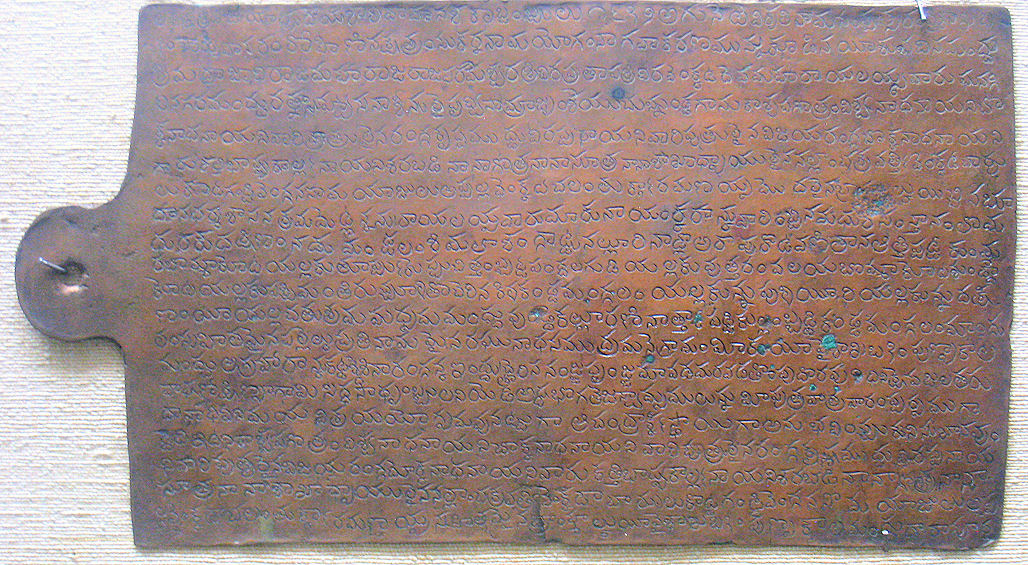
Abb.: कुप्यम् । Kupferplatte, Vijayaraṃga Cokka Nātha Nāyaka - విజయరంగ చోక్క
నాథ నాయక, Telugu, 1717
[Bildquelle: Daderot / Wikimedia. -- Public domain]
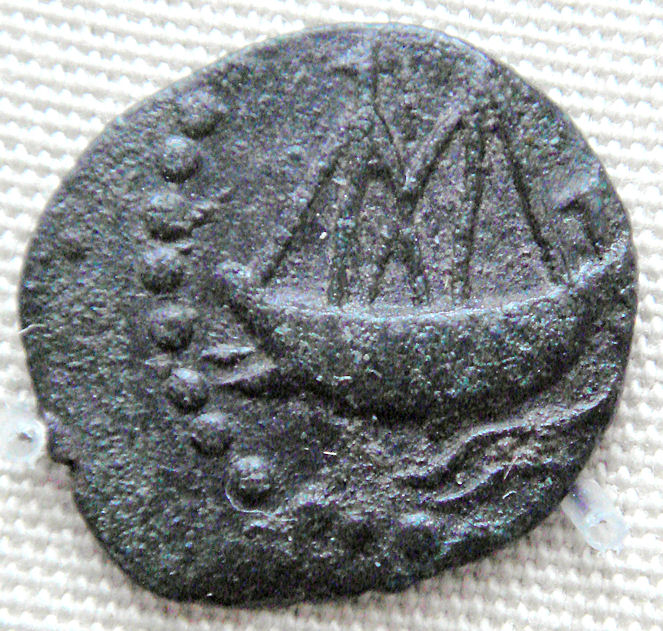
Abb.: कुप्यम् । Bleimünze von Vasisthiputra Sri Pulamavi (Sātavāhana), 1./2.
Jhdt n. Chr.

Abb.: कुप्यम् । Zink (Zn)
[Bildquelle: Alchemist-hp / Wikipedia. -- Creative Commons Lizenz (Namensnennung,
keine kommerzielle Nutzung, keine Bearbeitung)]
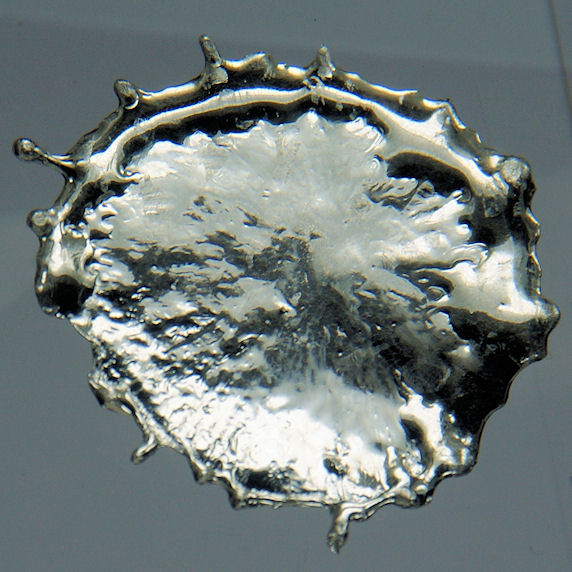
Abb.: कुप्यम् । Zinn (Sn)
[Bildquelle: Jurii / Wikimedia. --
Creative
Commons Lizenz (Namensnennung)]
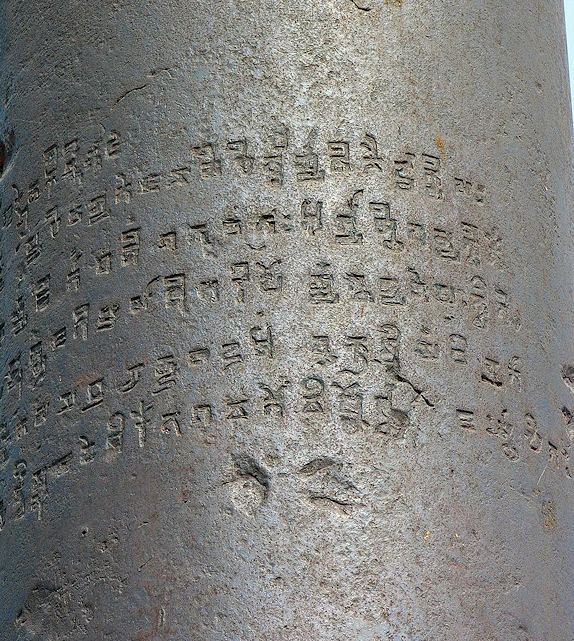
Abb.: कुप्यम् Inschrift auf 7 m hoher, nichtrostender Eisensäule, Delhi, 4. Jhdt. n. Chr.
[Bildquelle: Mark A. Wilson / Wikipedia. -- Public domain]
"METALS.
[...]
The metallic products of the East Indies comprise
- antimony,
- arsenic,
- chromium,
- cobalt,
- copper,
- gold,
- iron,
- lead,
- manganese,
- mercury,
- nickel,
- platinum,
- silver,
- tin,
- titanium, and
- zinc.
Metal casting in India is very largely practised, and the processes are of great simplicity. The natives generally prepare a model in wax, and imbed it in moist clays, which, after being dried in the sun, is heated in the fire, the wax run out, and the metal run in. A better plan, where accuracy is required, is to cut the model in lead, and, having bedded it in clay, it may, when the mould is dry, be melted and run out, and the metal run in. In Manbhum, a core is made of plastic clay, all carefully shaped to the internal form of the fish or other object to be imitated. This core is then baked and indurated. On this, the pattern designed to be represented is formed with clean beeswax. This done, and the wax having cooled, it becomes tolerably hard. Soft clay is moulded over all. The whole is then baked, the heat indurating the outer coating of clay, but softening the wax, which all runs out of the mould, leaving empty the space occupied by it. The mould being sufficiently dried, the molten brass is poured into the empty space, and, when cool, the clay is broken away, when the figured casting is seen. These are untouched after the casting, excepting on the smooth and flat surfaces, which are roughly filed. The Chinese excel in all working in metals, in ordinary blacksmith work, metal smelting, alloys, particularly their white metal of copper, zinc, iron, silver, and nickel, their sonorous gongs and bells, one at Pekin being 14½ feet by 13 feet, and their ingenious metallic mirrors, some with engravings. The Burmese, also, are skilled.
Indian metal ware is of several descriptions, some of it being much admired by Europeans. The black engraved work of Moradabad, N.W. Provinces, is well known, and so is the Tanjore brass ware. Madura men also manufacture brass vessels, to sell to the pilgrims. Messrs. Morrison, Rohde, Cal. Cat. Ex. 1862."
[Quelle: Balfour, Edward <1813-1889>: Cyclopædia of India and of eastern and southern Asia, commercial, industrial and scientific: products of the mineral, vegetable and animal kingdoms, useful arts and manufactures / ed. by Edward Balfour. -- 3rd ed. -- London: Quaritch. -- Vol. 2. -- 1885. -- S. 933f.]
|
92a./b.
tābhyāṃ yad anyat tat kupyaṃ
rūpyaṃ tad dvayam āhatam ताभ्यां यद् अन्यत् तत् कुप्यं रूप्यं तद् द्वयम् आहतम् ।९२ क। Geschlagene (geprägte) Edelmetalle heißen रूप्य - rūpya n.: "eine schöne Gestalt habend", Silber, gestempeltes oder geprägtes Gold und Silber |
Colebrooke (1807): "Bullion."
रूप्य - rūpya n.: "eine schöne Gestalt habend", Silber, gestempeltes oder geprägtes Gold und Silber
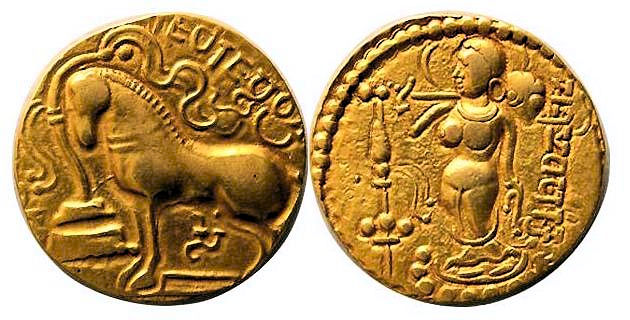
Abb.: रूप्यम् । Münze von Samudragupta zur Erinnerung an sein Aśvamedha, 4.
Jhdt. n. Chr.
[Bildquelle: Wikimedia. -- Public domain]
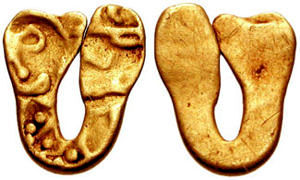
Abb.: रूप्यम् । Gestempelte Larin-Münze, 12./13. Jhdt.
[Bildquelle: Classical Numismatic Group, Inc. / Wikimedia. -- GNU
FDLicense]
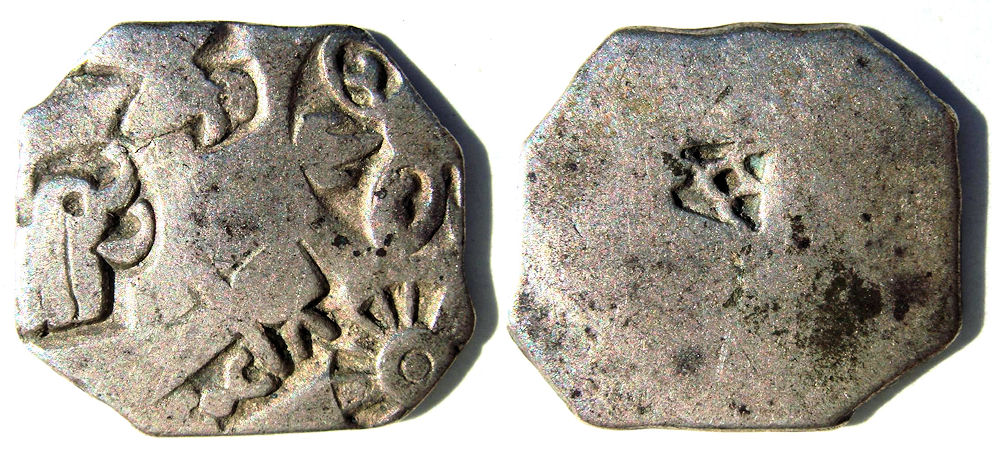
Abb.: रूप्यम् । "Punch marked coin", Maurya, 3./2. Jhdt. v. Chr.
[Bildquelle: Per honor et gloria / Wikimedia. -- Public domain]
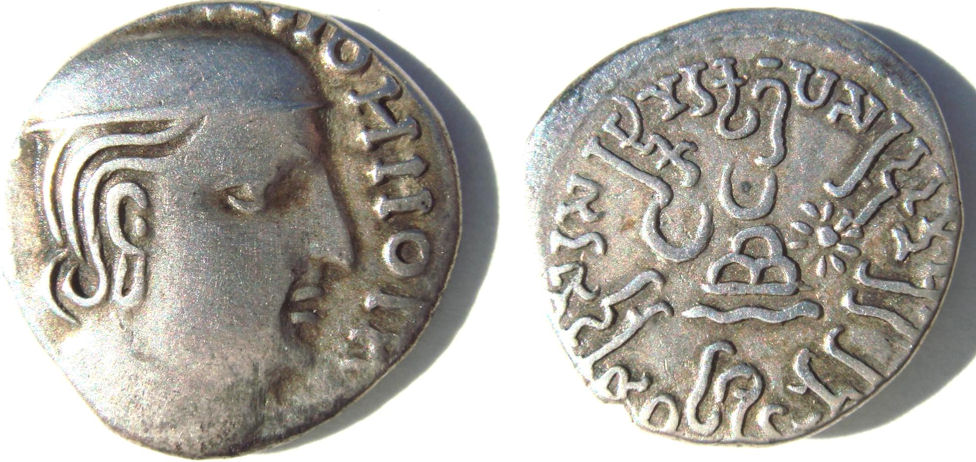
Abb.: रूप्यम् । Münze von Rudrasimha I, 2. Jhdt. n. Chr.
[Bildquelle: Per honor et gloria / Wikimedia. -- GNU FDLicense]
| 92c./d. gārutmataṃ marakatam aśmagarbhaṃ harinmaṇiḥ गारुत्मतं मरकतम् अश्मगर्भं हरिन्मणिः ।९२ ख। [Bezeichnungen für Smaragd:]
|
Colebrooke (1807): "An emerald."
"Smaragd ist eine im hexagonalen Kristallsystem kristallisierende Varietät des Silikat-Minerals Beryll und hat eine Härte von 7,5 bis 8. Seine chemische Zusammensetzung ist durch Be3Al2Si6O18 beschrieben. Die Farbe ist durch Beimengung von Chrom- und Vanadium-Ionen grün, die Strichfarbe ist weiß." [Quelle: http://de.wikipedia.org/wiki/Smaragd. -- Zugriff am 2011-09-21]
गारुत्मत - gārutmata n.: die Gestalt des Garuḍa habend, die Farbe des Garuḍa habend, Smaragd
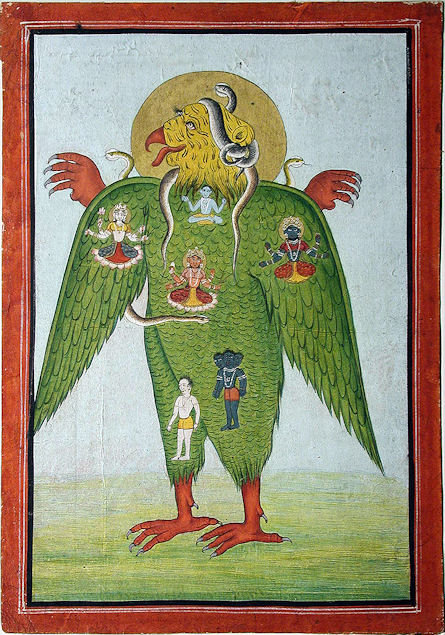
Abb.: गारुत्मतम् । गरुडः - Garuḍa, Kullu - कुल्लू, Himachal Pradesh, 1750
[Bildquelle: Asian Curator at The San Diego Museum of
Art. --
http://www.flickr.com/photos/asianartsandiego/4838471614/. -- Zugriff am
2011-09-12. --
Creative Commons Lizenz (Namensnennung, keine kommerzielle Nutzung,
keine Bearbeitung)]
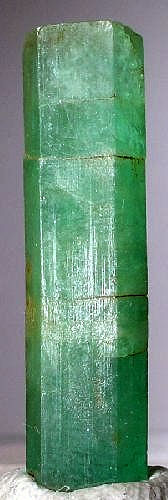
Abb.: गारुत्मतम् । Smaragd, Panjshir Valley ( درهٔ پنجشير
), Afghanistan
[Bildquelle: Rob Lavinsky, iRocks.com / Wikimedia. --
Creative
Commons Lizenz (Namensnennung, share alike)]
मरकत - marakata n.: Smaragd
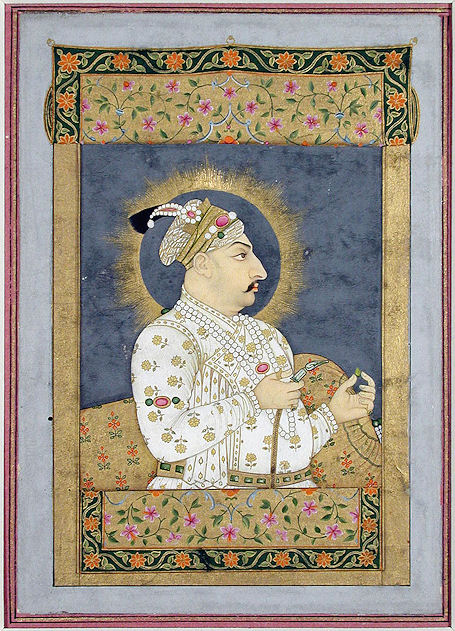
Abb.: मरकतम् । Emperor Muhammad Shah (محمد شاه) mit Smaragd in Hand / von Nidha Mal, ca. 1730
[Bildquelle: The San Diego Museum of
Art Collection. --
http://www.flickr.com/photos/thesandiegomuseumofartcollection/6125078792/. -- Zugriff am
2011-09-21. --
Creative Commons Lizenz (Namensnennung, keine kommerzielle Nutzung,
keine Bearbeitung)]
अश्मगर्भ - aśmagarbha n.: Stein als Ursprung habend, auf Stein wachsen, Smaragd

Abb.: अश्मगर्भम् । Smaragd, Badakhshan (بدخشان), Afghanistan
[Bildquelle: Rob Lavinsky, iRocks.com / Wikimedia. --
Creative
Commons Lizenz (Namensnennung, share alike)]
हरिन्मणि - harimaṇi m.: grüner Edelstein
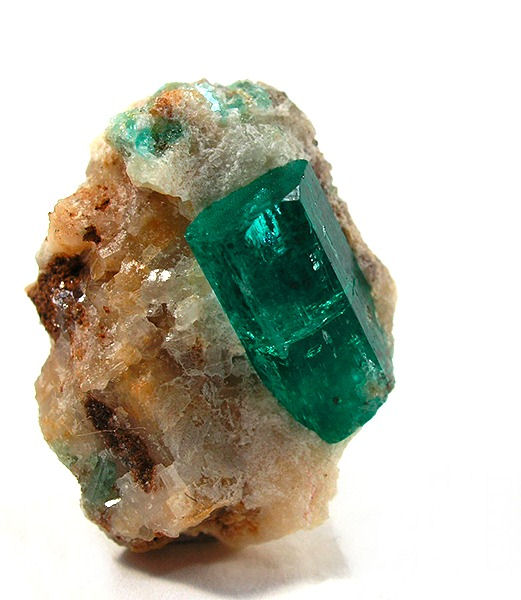
Abb.: हरिमणिः । Smaragd, Panjshir Valley ( درهٔ پنجشير
), Afghanistan
[Bildquelle: Rob Lavinsky, iRocks.com / Wikimedia. --
Creative
Commons Lizenz (Namensnennung, share alike)]
"EMERALD.
[...]
It is the rarest of all gems, of a beautiful green colour, unsurpassed by any gem. When of a deep rich grass-green colour, clear and free from flaws, it sells at from £20 to £40 the carat, those of lighter shade from 5s. to £15 the carat. The finest occur in a limestone rook at Muzo, in New Granada, near Santa Fé de Bogota 6° 28', at Odontchclong in Siberia, and near Ava.
From ancient times many stones hare been famed as emeralds, which can only bare been jasper or other green mineral. [...]
Aquamarine
includes clear beryls of a sea-green, or palebluish, or bluish-green tint. Hindus and Mahomedans use them pierced as pendants and in amulets. Many of the stones used as emeralds in India consist of beryl. Prismatic corundum or chrysoberyl, says Dr. Irvine, is found among the Tora hills near Rajmahal on the Bunas, in irregular rolled pieces, small, and generally of a light green colour. These stones are considered by the natives as emeralds, and are called in Panjabi Panna. The most esteemed colours are the Zababi, next the Saidi, said to come from the city Saidi in Egypt ; Raihani, new emeralds ; Fastiki, old emeralds, that is, such as have completed their 20 years ; Salki, Zangari, colour of verdigris ; Kirasi and Sabuni.
Most of the emeralds commonly in use in India are smooth, cut and bored like beads ; they are always full of flaws."
[Quelle: Balfour, Edward <1813-1889>: Cyclopædia of India and of eastern and southern Asia, commercial, industrial and scientific: products of the mineral, vegetable and animal kingdoms, useful arts and manufactures / ed. by Edward Balfour. -- 3rd ed. -- London: Quaritch. -- Vol. 1. -- 1885. -- S. 1047f.]
| 93a./b. śoṇaratnaṃ lohitakaḥ padmarāgo 'tha mauktikam शोणरत्नं लोहितकः पम्द्मरागो ऽथ मौक्तिकम् ।९३ क। [Bezeichnungen für Rubin:]
|
Colebrooke (1807): "A ruby."
"Als Rubin [Al2O3, sowie Beimengungen von Cr] bezeichnet man die rote Varietät des Minerals Korund. Die rote Verfärbung ist auf geringe Beimengungen von Chrom zurückzuführen. Nur die roten Korunde heißen Rubine, wobei der Rotton zwischen Blassrot und Dunkelrot variieren kann. Rosafarbene werden allerdings ebenso wie blaue und alle anderen Farbvarietäten unter der Bezeichnung Saphir zusammengefasst." [Quelle: http://de.wikipedia.org/wiki/Rubin. -- Zugriff am 2011-09-21]
शोणरत्न - śoṇaratna n.: roter Juwel
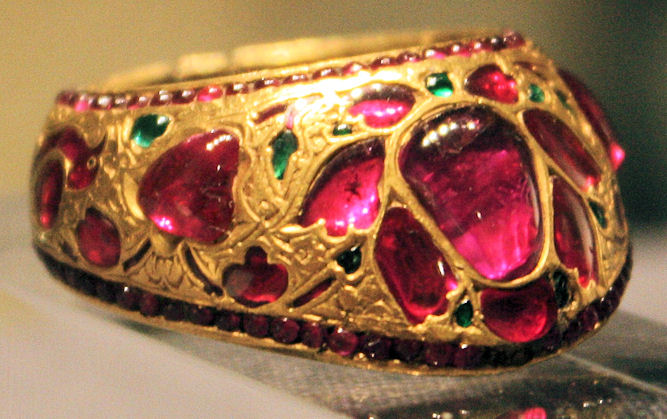
Abb.: शोणरत्नानि । Ring mit Rubinen und Smaragden, Moghulzeit, Indien
[Bildquelle: Val_McG. --
http://www.flickr.com/photos/33676549@N04/3312614172. -- Zugriff am
2011-09-21. --
Creative
Commons Lizenz (Namensnennung, share alike)]
लोहितक - lohitaka m.: Roter, Rubin
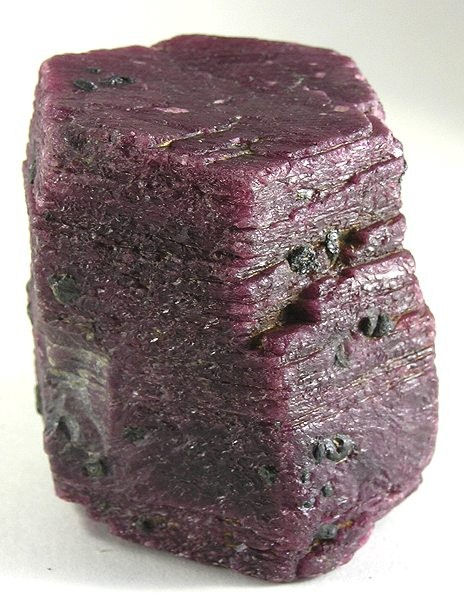
Abb.: लोहितकः । Rubin, Mysore District - ಮೈಸೂರು ಜಿಲ್ಲೆ,
Karnataka
[Bildquelle: Rob Lavinsky, iRocks.com / Wikimedia. --
Creative
Commons Lizenz (Namensnennung, share alike)]
पम्द्मराग - padmarāga m.: Lotusfarbiger, Lotusroter, Rubin
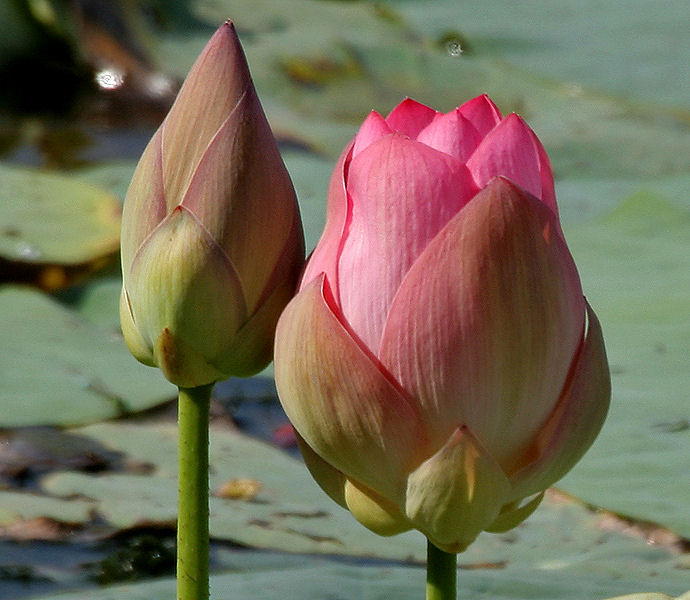
Abb.: पद्मरागः । पद्मौ । Lotusse - Nelumbo nucifera Gaertn. 1788,
Hyderabad - హైదరాబాదు,
Andhra Pradesh
[Bildquelle: J. M. Garg / Wikimedia. -- GNU FDLicense]
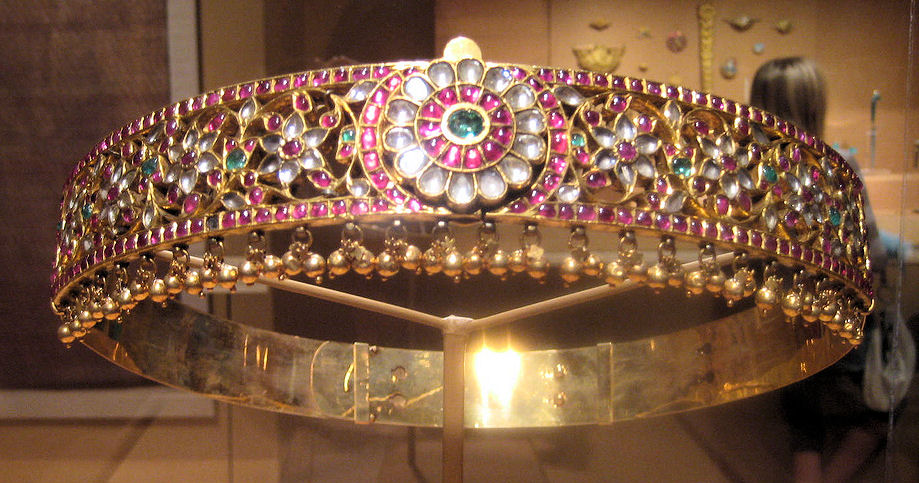
Abb.: पद्मरागाः । Gold-Gürtel (
"RUBY.
[...]
The true oriental ruby, the sapphire, the topaz, and the emerald, though differing greatly in appearance, arc chemically the same substance, pure alumina ; but jewellers give this name to several other minerals possessing brilliant red colour. The oriental ruby is the most valuable of all gems when of large size, good colour, and free from flaws. The ruby in colour varies from the highest rose tint to the deepest carmine, but the most valuable tint is that of pigeon's blood, a pure, deep, rich red, and generally occurs in 6-sided prisms.
The hest come from India, Burma, and Ceylon; Bohemia furnishes an inferior article. They are found in Ava, Siam, the Cupelam mountains, ten days' journey from Syrian a city in Pegu, Ceylon, India, Borneo, Sumatra, on the Elbe, on the Espailly in Auvergne, and Iser in Bohemia. The ruby and sapphire mines of Burma are 25 miles south of Moongmeet. Many of the rubies and other precious stones that the Shans bring with them in their annual caravan from the north of Burma, are made of rock-crystal, coloured artificially. These are heated and plunged into coloured solutions. Fine rubies have from time to time been discovered in many of the corundum localities of Southern India, associated with this gem, particularly in the gneiss at Viralimodos and Sholasigamany. It occurs also in the Trichingode taluk and at Mallapollaye, but it is, comparatively speaking, rare.
In Ceylon, at Badulla and Saffragam, and also, it is said, at Matura, rubies, sapphires, and topaz are found. Badakhshan has been famed since the time of Marco Polo as the country producing the true balas ruby. Its ruby mines are in the Gharan district, 20 miles from the small Tajak state of Ishkashm, on the right bank of the Oxus. They have not been worked since the Kimduz chief took Badakhshan. Irritated by their small yield, he marched the inhabitants of the district, 500 families, to Kunduz, where he sold them as slaves.
Of the accounts of the ruby mines of Burma, one was written by Père Giuseppe D'Amato, an Italian Jesuit missionary to Burma, a translation of which appeared in the Journal of the Asiatic Society of Bengal in 1833 ; and another account by Mr. Bredmeyer, who about 1870 was in charge of some minor ruby mines within 16 miles of Mandalay. The mines visited by Père D'Amato are said to be 60 or 70 miles distant from Ava in a north-east direction, and separated from the Irawadi valley by the Shoay-aoung or Golden Mountain range, which are only occasionally visible from the town of Male, owing to the constant fogs and mists that hang around, and snow lies on them for four months of the year, beginning with the middle or end of November. They are situated north-east from Mandalay, and distant about 60 or 70 miles. The principal road to them leaves the Irawadi at Tsiuguh-Myo, and passes through Shuemale. There are other roads, from Tsarapaynago and other villages to the north. The mines lie nearly due east from the village. The villages in the immediate neighbourhood of the mines are Kyatpen, Mogouk, and Katheyuwa. The gems are procurecl over an area of probably 100 square miles. The mode of seeking for them is simply sinking pits until the gem-bed or ruby earth is met with ; this is then raised to the surface and washed. The gem-bed is met with at various depths, sometimes not more than two or three feet from the surface, and occasionally not at all. When the layer of earthy sand containing the rubies is met, lateral shafts are driven in on it, and the bed followed up, until it either becomes necessary to sink another pit in it, or it becomes exhausted. It varies in thickness from a few inches to two or three feet. The rubies are, for the most part, small, not averaging more than a quarter of a rati, and when large are generally full of flaws. Well-marked crystals occasionally occur, but the vast majority of stones are well rounded and ground down. It is very rare to find a large ruby without flaws ; and Mr. Spears states that he had never seen a perfect ruby weighing more than half a rupee. The same authority mentions that sapphires are also found in the same earth with the rubies, but are much more rare, and are generally found of a larger size. Stones of ten or fifteen rati without a flaw are common, whereas a perfect ruby of that size is hardly ever seen. The largest perfect sapphire he ever saw weighed one tikal. It was polished, but he has seen a rough one weighing 26 tikal. For every 500 rubies, he does not think they get one sapphire. You see very small sapphires in the market, while small rubies are abundant and cheap. The value of the gems, rubies, and sapphires obtained in a year maybe from £12,500 to £15,000. They are considered the sole property of the king, and strictly monopolized, but, notwithstanding the care that is taken, considerable quantities are smuggled. There are about 20 lapidaries or polishers of these stones at Amarapura ; they are not allowed to carry on their trade at the mines. For polishing, small rubies and worthless pebbles brought from the mines, being pounded fine and mixed up with an adhesive substance, and then made into cakes some ten inches long by four broad, are employed to rub down the gem. After it has been brought to the form and size required, another stone of finer grain is employed. The final process is performed by rubbing the ruby on a plate of copper or brass until it is thoroughly polished, when the gem is ready for the market. Rubies of Burma are not exported to any large extent, and then only stones of inferior value. But a pink spar found in the ruby district is a more important item of export. It is believed to be used for one of the classes of distinctive mandarin cap-knobs. Great numbers of these gems are brought down to Rangoon for sale, but a heavy price is always demanded for them, and it requires an experienced eye to purchase them with a view to profit. Topazes are also found in the vicinity of the rubies and sapphires, but they are scarce, and fetch a higher price in Burma than they would realize in England.
Recently, rubies and sapphires have been found in Siam, about four days' journey from Bangkok, in a very feverish locality. The stones, though inferior to those obtained in Upper Burma, are said by the Burmese to be so plentiful near Bangkok, that even women are anxious to proceed to the mines.
Ceylon ruby is a term applied in England to the garnets and carbuncle which come from Siam through Ceylon, and also to peculiar tinted almandines. The stones are of a rich red tinged with yellow. They are superior to those of the mine of Zobletz in Silesia, from the Tyrol, and from Hungary. Under the designation Ceylon rubies, jewellers obtain a large price for them from the ignorant. A stone of a fine rich tint, free from flaws, of a certain size, will range from £8 to £10.
Balas ruby is a term used by lapidaries to designate the rose-red varieties of spinel. Spinel is seen of all shades,—blood red, the proper spinel ruby ; rose red, the balas ruby ; orange or red rubicelle ; and voilet-coloured or almandine ruby.
Red tourmaline is sometimes mistaken for the ruby, and the pink topaz for the balas ruby. Spinel and balas rubies are found in Ceylon, Ava, Mysore, Baluchistan ; the spinel ruby is comparatively of little value, but they are often sold for a true ruby, and the true ruby is occasionally parted with as a spinel ruby.
Tavernier gives the figures of a ruby that belonged to the king of Persia. It was in shape and bigness like an egg, bored through in the middle, deep coloured, fair, and clean, except one flaw in the side. They would not tell what it cost, nor what it weighed ; only it had been several years in the treasury. He likewise gives the figure of a balas ruby, sold for such to Giafer Khan, uncle of the Great Moghul, who paid 9,50,000 rupees = 1,425,000 livres for it. But an old Indian jeweller affirming afterwards that it was no balas ruby, that it was not worth above 500 rupees, and that Gaifer Khan was cheated, and his opinion being confirmed by Shah Jahan, the most skilful in jewels of any person in the empire, Aurangzeb compelled the merchant to take it again, and to restore the money back. Tavernier gives also the figure of a ruby belonging to the king of Visapur. It weighed fourteen mangelin, or seventeen carats and a half, a Visapur mangelin being but five grains. It cost the king 14,200 new pagodas or 74,500 livres. Also, he figures a ruby that a Banya showed him at Benares ; it weighed 58 rati or 50¾ carat, being of the second rank in beauty, in shape like a plump almond bored through the end. He offered 40,000 rupees or 6000 livres for it, but the merchant demanded 55,000 rupees.
The largest oriental ruby known was brought from China to Prince Gargarin, governor of Siberia ; it afterwards came into possession of Prince Menzikoff, and now constitutes a jewel in the imperial crown of Russia."
[Quelle: Balfour, Edward <1813-1889>: Cyclopædia of India and of eastern and southern Asia, commercial, industrial and scientific: products of the mineral, vegetable and animal kingdoms, useful arts and manufactures / ed. by Edward Balfour. -- 3rd ed. -- London: Quaritch. -- Vol. 3. -- 1885. -- S. 449f.]
| 93a./b. śoṇaratnaṃ lohitakaḥ padmarāgo 'tha mauktikam 93c./d. muktātha vidrumaḥ puṃsi prabālaṃ puṃ-napuṃsakam
शोणरत्नं लोहितकः पम्द्मरागो
ऽथ मौक्तिकम् ।९३ क। [Bezeichnungen für Perle:]
|
Colebrooke (1807): "A pearl."
मौक्तिक - mauktika n.: Perle
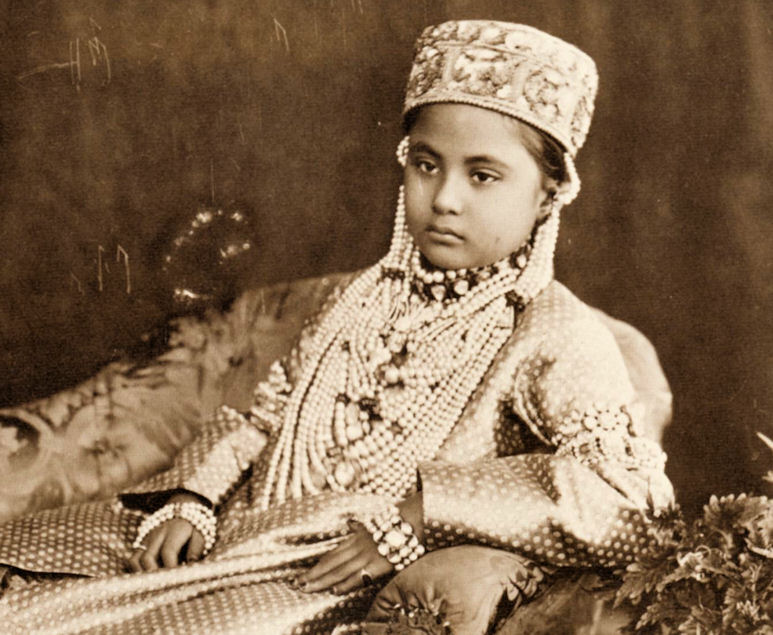
Abb.: मौक्तिकानि । Die Tochter des Nizam, Hyderabad -
حیدرآباد, (heute:) Andhra Pradesh, 1890
[Bildquelle: Raja Lala Deen Dayal (1844 - 1905)]
मुक्ता
- muktā f.: Perle
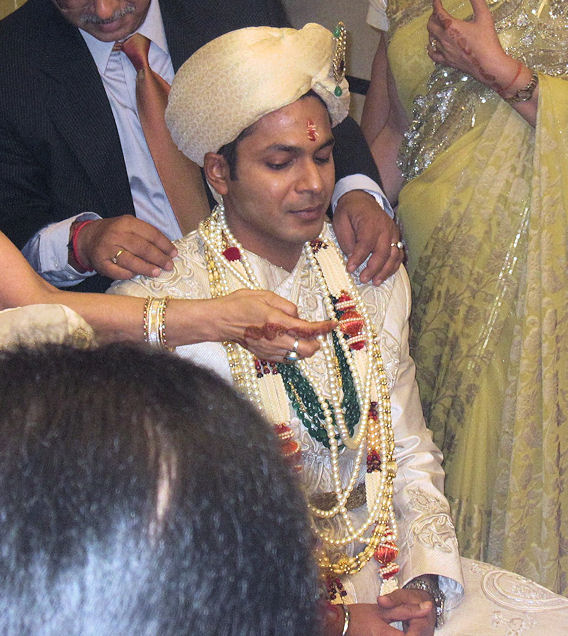
Abb.: मुक्ताः । Bräutigam, New Delhi
[Bildquelle: Maja. --
http://www.flickr.com/photos/maja-h/5207499893/. -- Zugriff am
2011-09-22. --
Creative
Commons Lizenz (Namensnennung, keine kommerzielle Nutzung, share alike)]
"PEARL.
[...]
Pearls are found in several molluscs inhabiting shallow seas and sandbanks in the old and new world, but the most productive mollusc is the Meleagrina margaritifera or Avicula margaritifera, the pearl oyster ; and the best known localities are the Persian Gulf, the west coast of Ceylon in the Gulf of Manaar, Panama, the shores of California, Australia, Red Sea, Arabian coasts, the Aru Islands, Zebu, the Sulu Archipelago, Mindanao, coast of New Guinea, Torres Straits, Gulf of Omra, and coasts of Japan.
Friar Jordanus, a quaint old missionary bishop, who was in India in 1330, says that 8000 boats were engaged in this fishery and that of Ceylon, and that the quantity of pearls was astounding and almost incredible. The headquarters of the fishery was then, and indeed from the days of Ptolemy to the 17th century continued to be, at Chayl or Coil, literally, the temple, on the sandy promontory of Ramnad, which sends off a reef of rocks towards Ceylon, known as Adam's Bridge. And Ludovico di Varthema mentions having seen the pearls fished for in the sea near the town of Chayl, in about a.d. 1500 ; and Barbosa, who travelled about the same time, says that the people of Chayl are jewellers who trade in pearls. This place is, as Dr. Vincent has clearly shown, the Koru of Ptolemy, the Kolkhi of the author of Periplus, the Coll or Chayl of the travellers of the Middle Ages, the Ramana-Koil (temple of Rama) of the natives, the same as the sacred promontory of Ramnad and isle of Rameswaram, the headquarters of the Indian pearl fishery from time immemorial.
In Arabic poetry, pearls are fabled to be drops of vernal rain congealed in oyster shells. Benjamin of Tudela says that in the month of March the drops of rain-water which fall on the surface of the sea are swallowed by the mothers-of-pearl, and carried to the bottom of the sea, where, being fished for and opened in September, they are found to contain pearls. The Hindus poetically describe them as drops of dew falling into the shells when the molluscs rise to the surface of the sea in the month of May, and becoming, by some unexplained action of the sun's rays, transformed into pearls. Pliny and Dioscorides believed that pearls were productions of dew ; but that observant old Elizabethan navigator, Sir Richard Hawkins, shrewdly remarked that 'this must be some old philosopher's conceit, for it cannot be made probable how the dew should come into the oyster.'
[...]
In whatever way produced, pearls of considerable size, on account of their beauty and rarity, have been valued at enormous prices in past ages, and are still among the choicest objects of the jeweller's art. Their delicate and silvery lustre has been as widely celebrated as the brilliance of the diamond. The Meleagrina margaritifera furnishes the finest pearls and finest nacre. When secreted in the globular form, it is the pearl ; on the inner walls of the shell, it is the nacre. A pearl, to be pure, should be of perfect whiteness, be spherical or of a regular pear shape; those of blue reflection are less valued, and the yellow pearls still less. Tavernier was of opinion that the yellow colour was a stain from the rotting mollusc.
The pearl mollusc multiplies by means of what technically called spat or spawn, which is thrown out in sonic years in great quantities, —perhaps similar to the edible oyster of Britain,´which threw much spat in 1849, and not again until 1860, and not then up at least to 1866. The pat floats in and on the water, and attaches itself to anything it comes in contact with, attaining, it is said, the size of a shilling in six months. In its seventh year the pearl mussel attains its maturity as a pearl producer; pearls obtained from a seven-year mussel being of double the value of those from one of six years of age. In mussels under four years the pearls are not of any mercantile value, and after seven years the pearls deteriorate. Those from mussels of about four years old have a yellow tinge, and the older kinds a pinky hue ; but pearls of a red and even black, as also with other colours, are likewise met with.
Of all the substances used for personal decoration, the pearl alone derives nothing from art. The Baghdad dealers prefer the round white pearl. Those of Bombay esteem pearls of a yellow hue and perfect sphericity. According to European taste, a perfect pearl should be round or drop-shaped, of a pure white, slightly transparent, free from specks, spots, or blemish, and possess the peculiar lustre characteristic of the gem. In India and China, the bright yellow colour is preferred. The rose-tinted pearl of Scotland is in large esteem amongst Paris ladies. The pearls of Scotland of the best kind range in price from £5 to £50, but £100 has been paid for a fine specimen. Pearls of the Persian Gulf and Ceylon realize from Rs. 1000 to Rs. 1500 a tola of 180 grains.
A pair of very fine black pearls was recently sold to a rich iron merchant in Paris for 500,000 francs. The pink pearl ranks with the clear white pearl in value. Some specimens have been found with purple, cream, and salmon colours.
Pearls are designated in Europe by their colours, white, yellow, or black ; or by their size, as seed-pearl. The best pearls are of a clear, bright whiteness, free from spots or stains, with the surface naturally smooth and glossy. Those of a round form are preferred, but the larger pear-shaped ones are esteemed for ear-rings, Seed-pearls are those of the smallest size.
The dealers in Ceylon recognise twelve classes, in none of which is the actual weight taken into consideration
Called Ani, comprising those pearls to which Pliny first applied the term 'unio,' in which all the highest perfections of lustre and sphericity are centred ;
Anathari are such as fail a little in one point, either in lustre or sphericity ;
Sanadayam, and
Kayeral, such as fail in both ;
Massagu, or confusion;
Vadivu, beauty;
Medangu, bent or 'folded ' pearls ;
Kurwal, double pearls ;
Kalippu, signifying abundance ;
Poesal, and
Kural, mis-shapen. These find a ready sale in India, all kinds and shapes being indiscriminately used to adorn the roughly made breastplates of gold worn by women of high caste.
Thool, literally 'powder.' These are all easily disposed of in India, where they are sometimes made into lime to chow with betle.
Pearls arc found in the Unio marginalis, Lam., and Unio flavidus, Benson, of the Bhandardali lake near Berhampore.
In the salt-water inlets along the entire seacoast of Sind, a thin-shelled variety of the oyster occurs on the sandbanks, called Kenjur, that are left dry at low tides, but chiefly in the creeks near Kurachee, a seed-pearl is found, selling at Rs. 15 the tola. The seed-pearl fishery was let by the Amirs successively for Rs. 650, Rs. 1300, and Rs. 19,000. After 1839, they let them out for Rs. 1100, Rs. 21,000, and Rs. 35,000, but the contractors failed.
The produce of the fisheries in the Gulf of Manaar has varied greatly at long intervals. From 1838 to 1854 there was no fishery at all. A similar interruption had been experienced between 1820 and 1828. The Dutch had no fishery for 27 years, from 1768 to 1796 ; and they were equally unsuccessful from 1732 to 1746. It has now been satisfactorily proved that the pearl-oysters occasional disappearance is perfectly natural. The Arabs of the Persian Gulf, according to Colonel Pelly, attribute the decay of the Sind and Ceylon fisheries to the mixture of mud and earthy substance with the sand of the beds.
In the Persian Gulf the pearl banks extend 300 miles in a straight line, and the best beds are level and of white sand, overlying the coral in clear water ; and any mixture of mud or earthy substance with the sand is considered to be detrimental to the pearl mollusc. These banks are from 3 to 6 miles off shore, in 6 to 7 fathoms water. 400 boats of all sizes are annually employed, carrying crews of from 13 to 25 persons, half of them divers. The yearly produce was estimated at 40,000 tomans, each toman 18 piastres Rumi. —the masters drawing three shares, divers two shares, and assistants one share. Some of the Arab colonies on the Persian littoral retain a right to fish on the banks, which are appanages of the parent Arabian tribe.
In the Persian Gulf there is both a spring and a summer fishery, and as many as 5000 boats will assemble from Bahrein and the islands, and continue fishing from April to September. The total amount derived in the pearl fisheries of the Persian Gulf has been estimated at £400,000, employing about 30,000 persons. During a recent year, 30 divers engaged in the pearl fishery in the Persian Gulf lost their lives, most of them being victims of sea monsters. The value of the pearls taken in 1879 in the Persian Gulf was set down at about £300,000. There were 7,000,000 fished, and it was believed that but for the frequent interruption by weather, 2,000,000 more might have been lifted.
Off the coast of Ceylon the fishing season is inaugurated by numerous ceremonies, and the fleet, sometimes of 150 boats, then puts to sea. Each boat has a stage at its side, and is manned by ten rowers, ten divers, a steersman, and a shark charmer (Pillal karras). The men go down five at a time, each expediting his descent by means of a stone 20 to 25 lbs. in weight, and. holding their nostrils, gather into a net or basket about 100 shells in the minute or so which they remain under water. Each man makes 40 to 50 descents daily. The pearl -oysters are thrown on the beach and left to putrefy. It has been ascertained that no diving apparatus could, with any advantage, be substituted. The common time for remaining under water is 50 or 60 seconds, but Sir Henry Ward timed one man at 80 seconds, and another at 84 seconds. When the oysters reach the Government kottus, they are divided into four heaps. The divers then remove their share, and the remaining three-fourths, belonging to Government, divided into heaps of 1000 each, are sold by auction to the highest bidder. Sir Henry Ward says,—I have seen myself 32 pearls taken out of one oyster, three of which were worth £1 a piece, while even the smallest had a marketable value.
Pearl banks dot the coast from the sandy island of Rameswaram southwards to the mouth of the Tambraparni river.
In 1881, about 27 millions of oysters were fished, which were sold for an average of Rs. 33 per 1000, about 3000 men being employed at the work. About the year 1794, the Madras Government undertook the management of the pearl fisheries on the S.E. coast of the Peninsula, and in the 83 years realized about 12 lakhs of rupees, their annual expenditure being about Rs. 6000.
[...]
The larger pearls are considered the more valuable.
[...]
The prices of the smaller-sized pearls, like those of the smaller-sized diamonds, are rapidly Hill casing. A pearl of 3 grains will cost about £; a pearl of 30 grains, £110. The Imam of Muscat has one worth £32,000. "
[Quelle: Balfour, Edward <1813-1889>: Cyclopædia of India and of eastern and southern Asia, commercial, industrial and scientific: products of the mineral, vegetable and animal kingdoms, useful arts and manufactures / ed. by Edward Balfour. -- 3rd ed. -- London: Quaritch. -- Vol. 1. -- 1885. -- S. 168ff.]
"PEARLS AND CORAL. Sans. मुक्ता Muktā, Pearls. प्रवाल Pravāla, Coral.
THESE gems have been used in medicine from a very ancient period and are mentioned by Susruta. Pearls are purified by being boiled in the juice of the leaves of Sesbania aculeata (jayanti), or of the flowers of Agati grandiflora (vaka). Coral is purified by being boiled in a decoction of the three myrobalans. Both are prepared for medicinal use by being calcined in covered crucibles and then reduced to powder. The properties of both these articles are said to be alike and they are generally used in combination. They are said to be useful in urinary diseases, consumption etc, and to increase the strength, nutrition, and energy of weak persons."
[Quelle: Dutt, Uday Chand: The materia medica of the Hindus / Uday Chand Dutt. With a glossary of Indian plants by George King. -- 2. ed. with additions and alterations / by Binod Lall Sen & Ashutosh Sen. -- Calcutta, 1900. - XVIII, 356 S. -- S. 93.]
| 93c./d. muktātha vidrumaḥ puṃsi prabālaṃ puṃ-napuṃsakam मुक्ताथ विद्रुमः पुंसि प्रबालं पुं-नपुंसकम् ।९३ ख। [Bezeichnungen für Koralle:]
|
Colebrooke (1807): "Coral."
विद्रुम - vidruma m.: "absonderlicher Baum", Koralle
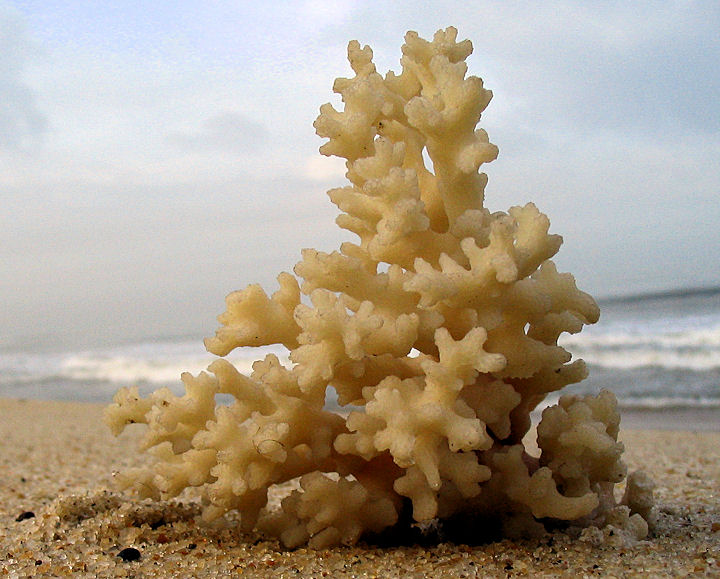
Abb.: विद्रुमः । Kanyakumari - கன்னியாகுமரி,
Tamil Nadu
[Bildquelle: wildxplorer. --
http://www.flickr.com/photos/krayker/2117971591/. -- Zugriff am
2011-09-22. --
Creative Commons Lizenz (Namensnennung)]
प्रबाल - prabāla m., n.: Schoß, Trieb, Zweig, Koralle
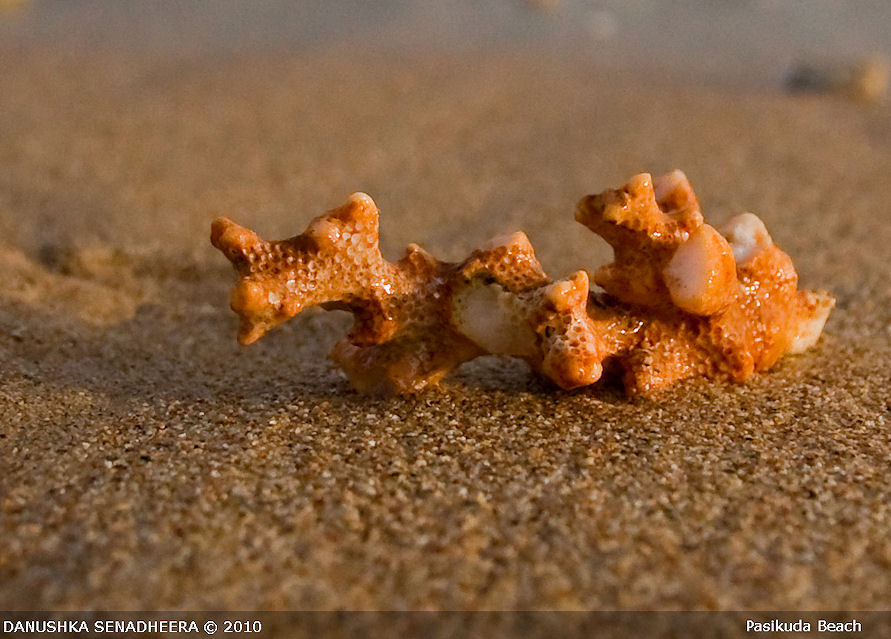
Abb.: प्रबालः । Batticaloa (மட்டக்களப்பு
/ මඩකලපුව), Sri Lanka
[Bildquelle: Danushka Senadheera. --
http://www.flickr.com/photos/advanture_srilanka/4834500777/. -- Zugriff
am 2011-09-22. --
Creative Commons
Lizenz (Namensnennung, keine kommerzielle Nutzung, keine Bearbeitung)]
| 94a./b. ratnaṃ maṇir dvayor aśmajātau muktādike 'pi ca रत्नं मणिर् द्वयोर् अश्मजातौ मुक्तादिके ऽपि च ।९४ क। Korallen und andere auf Stein Gewachsene heißen:
|
Colebrooke (1807): "Any gem."
रत्न ratna n.: Juwel
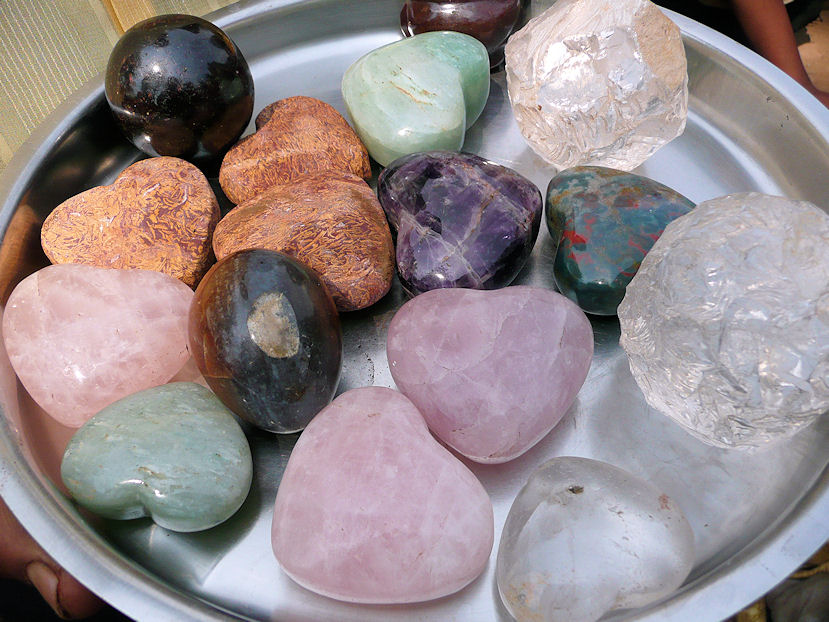
Abb.: रत्नानि । Khambhat - ખંભાત, Gujarat
[Bildquelle: The National Labor Committee. --
http://www.flickr.com/photos/nlcnet/4401722056/. -- Zugriff am
2011-09-22. --
Creative
Commons Lizenz (Namensnennung, keine kommerzielle Nutzung, share alike)]
"These gemstones are grinded in India and sold for large profits in the U.S.
and Europe."
मणि - maṇi m., f.: Juwel, Edelstein
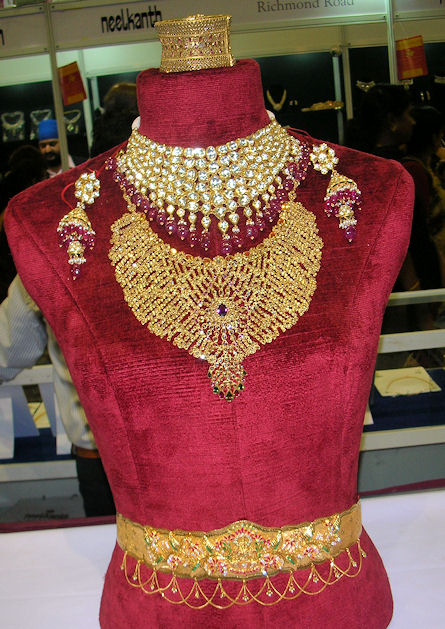
Abb.: मणयः । Bangalore - ಬೆಂಗಳೂರು,
Karnataka
[Bildquelle: najeebkhan. --
http://www.flickr.com/photos/42429527@N03/3984963296/in/photostream/. --
Zugriff am 2011-09-22. --
Creative
Commons Lizenz (Namensnennung, keine kommerzielle Nutzung, share alike)]
"The precious stones described are,
- Hīraka, diamond ;
- Gārutmat, emerald;
- Puṣparāga, topaz;
- Māṇikya, ruby;
- Indranīla, sapphire;
- Gomeda, a yellow gem of the colour of fat;
- Vaidūrya, a gem of a dark blue colour, the lapis lazuli;
- Mauktika, pearls;
- Vidruma, corals.
Collectively they are called Navaratna or the nine gems. Rājavarta, an inferior kind of diamond from Virat, and Vaikrānta, another inferior kind of diamond, are sometimes used instead of diamond."
[Quelle: Dutt, Uday Chand: The materia medica of the Hindus / Uday Chand Dutt. With a glossary of Indian plants by George King. -- 2. ed. with additions and alterations / by Binod Lall Sen & Ashutosh Sen. -- Calcutta, 1900. - XVIII, 356 S. -- S. 23.]
| 94c./d. svarṇaṃ suvarṇaṃ kanakaṃ hiraṇyaṃ hema-hāṭakam 95a./b. tapanīyaṃ śātakumbhaṃ gāṅgeyaṃ bharma karburam 95c./d. cāmīkaraṃ jātarūpaṃ mahārajata-kāñcane 96a./b. rukmaṃ kārtasvaraṃ jāmbūnadam aṣṭāpado 'striyām
स्वर्णं सुवर्णं कनकं हिरण्यं हेम-हाटकम् ।९४
ख। [Bezeichnungen für Gold:]
|
Colebrooke (1807): "Gold."
स्वर्ण - svarṇa n.: Schönfarbiges, Gold
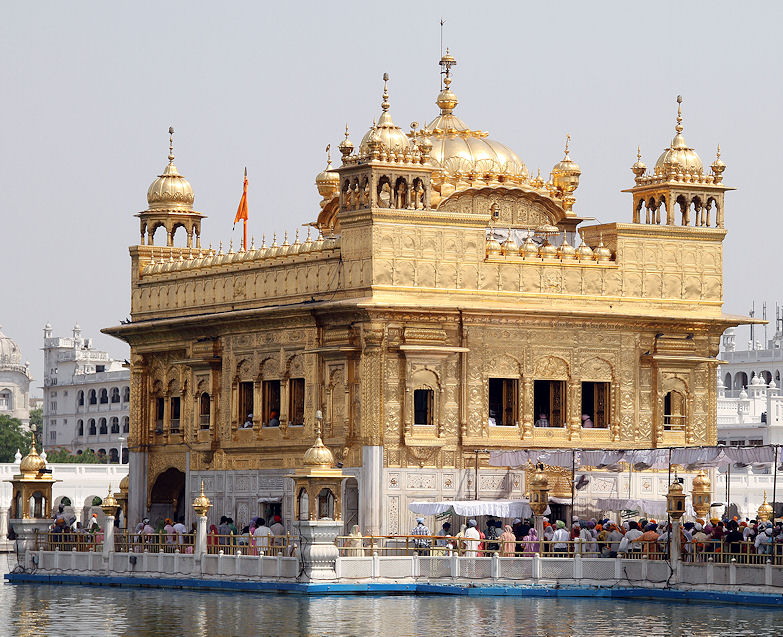
Abb.: स्वर्णम् । Harmandir Sahib (ਹਰਿਮੰਦਰ ਸਾਹਿਬ), Amritsar -
ਅੰਮ੍ਰਿਤਸਰ, Punjab,
vergoldet vor 1830
[Bildquelle: Oleg Yunakov / Wikipedia. -- GNU FDLicense]
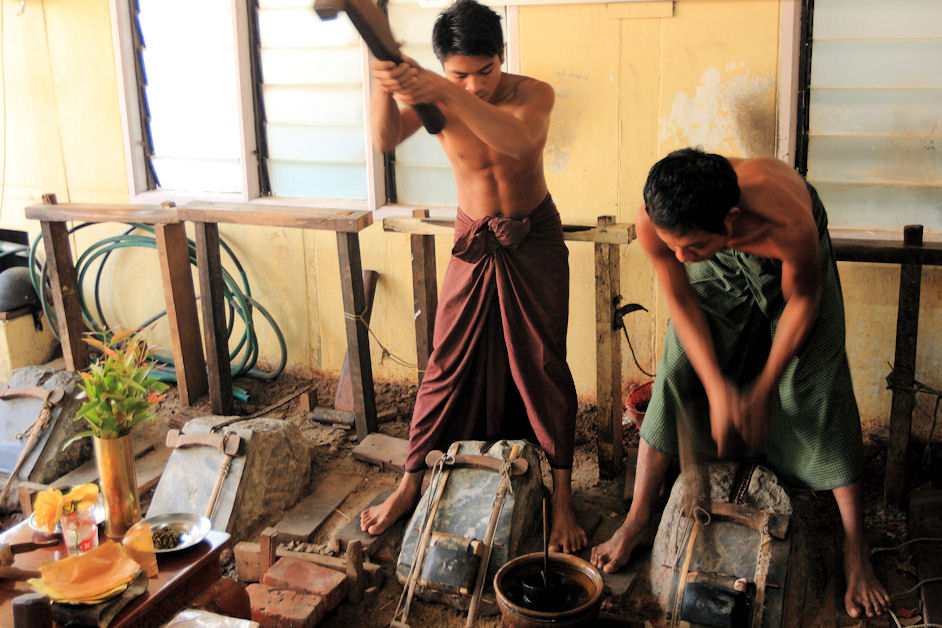
Abb.: स्वर्णम् । Schlagen von Blattgold, Mandalay -
မန္တလေးမြို့, Myanmar
[Bildquelle: Damien Halleux Radermecker. --
http://www.flickr.com/photos/dayapragm/4350796844/. -- Zugriff am
2011-09-28. --
Creative
Commons Lizenz (Namensnennung, share alike)]
सुवर्ण - suvarṇa n.: Schönfarbiges, Gold
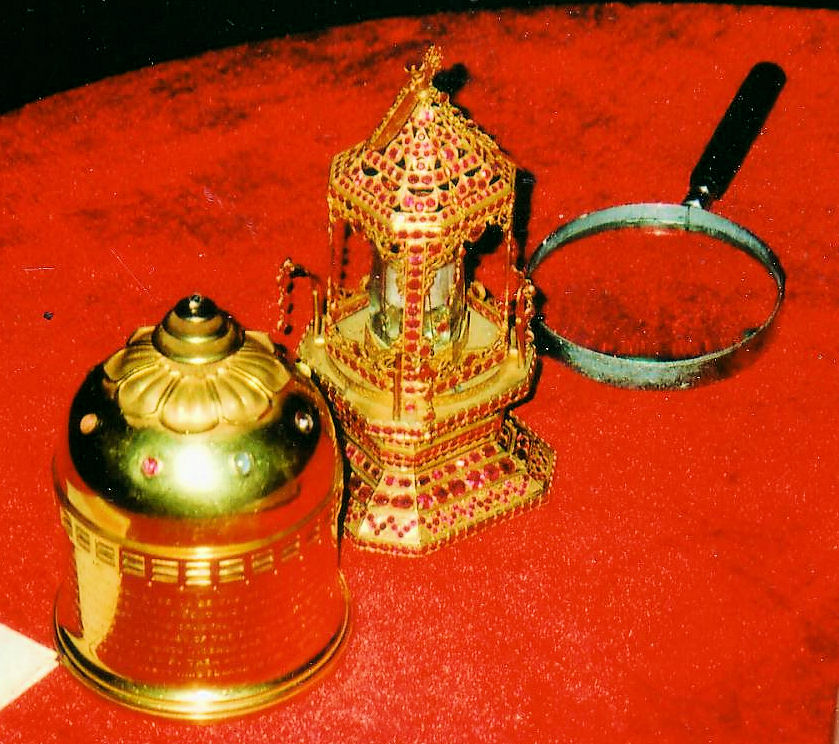
Abb.: सुवर्णम् । Buddhistisches Reliquiar, gestiftet von Kaniṣka (Κανηϸκι),
Peshawar (پشاور),
Pakistan, 2. Jhdt. n. Chr.
[Bildquelle: Teresa Merrigan / Wikimedia. -- GNU FDLicense]
कनक - kanaka n.: "Glänzendes", Gold
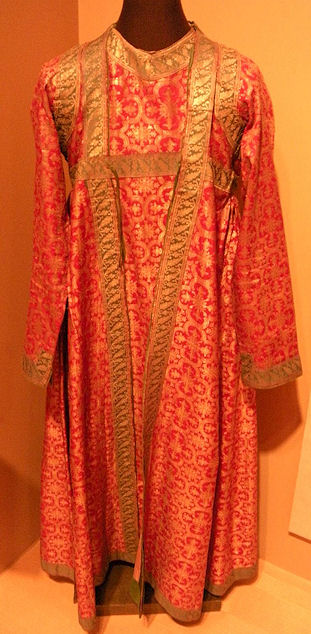
Abb.: कनकम् । Männermantel, Moghul, Indien, frühes 18. Jhdt.
[Bildquelle: airforceJK. --
http://www.flickr.com/photos/35663527@N06/3305001609. -- Zugriff am
2011-09-27. --
Creative Commons Lizenz (Namensnennung)]
हिरण्य - hiraṇya n.: Gold, Reichtum
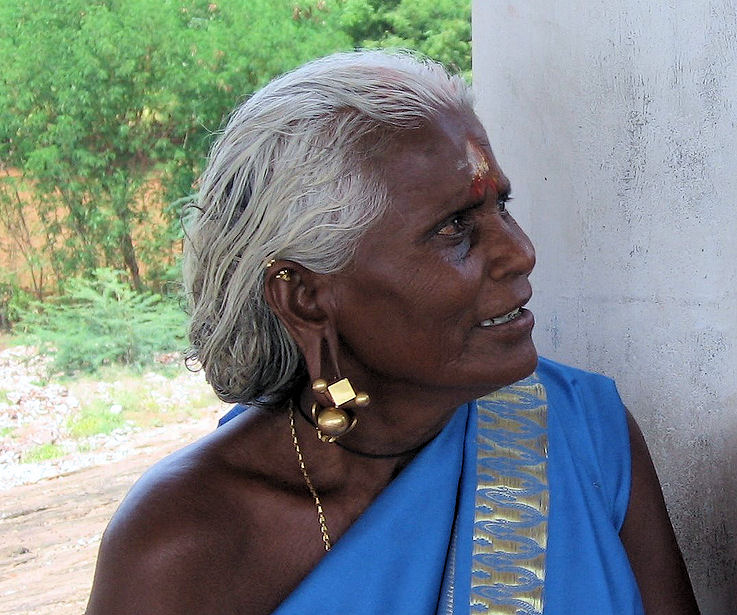
Abb.: हिरण्यम् । Ohrringe, die über 100 Gramm wiegen, Tamil Nadu
[Bildquelle: sowrirajan s. --
http://www.flickr.com/photos/sowri/1144968763/. -- Zugriff am
2011-09-27. --
Creative Commons Lizenz (Namensnennung)]
हेमन् - heman n.: Gold
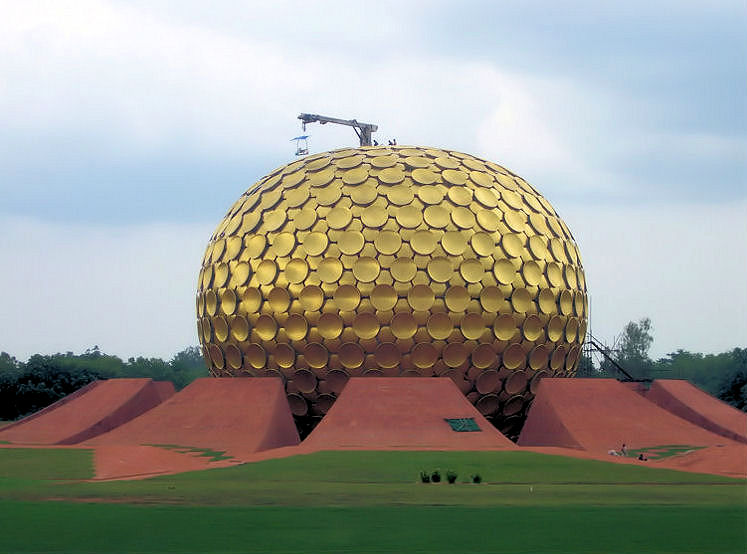
Abb.: हेम । Matrimandir (मातृमन्दिर), Auroville -
ஆரோவில்,
Tamil Nadu
[Bildquelle: Sujit kumar / Wikimedia. --
Creative
Commons Lizenz (Namensnennung, share alike)]
हाटक - hāṭaka n.: "aus Hāṭaka (der Vitala-Unterwelt) Kommendes", Gold
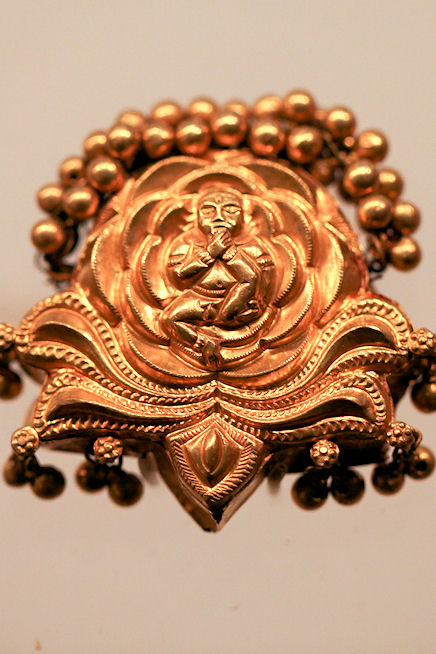
Abb.: हाटकम् । Kopfschmuck, Indien, 19. Jhdt.
[Bildquelle: Anne Petersen. --
http://www.flickr.com/photos/opacity/5364788437/. -- Zugriff am
2011-09-27. --
Creative Commons Lizenz (Namensnennung, keine kommerzielle Nutzung,
keine Bearbeitung)]
तपनीय - tapanīya n.: zu Erhitzendes, geläutertes Gold
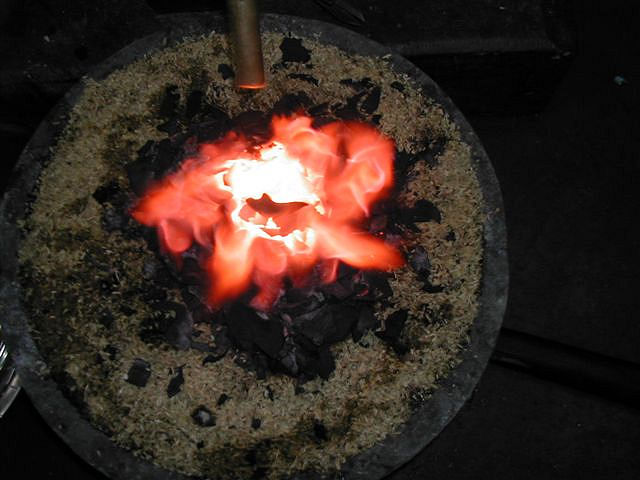
Abb.: तपनीयम् । Goldschmelze, Sri Lanka
[Bildquelle: HumanityAshore. --
http://www.flickr.com/photos/humanityashore/62987403/. -- Zugriff am
2011-09-27. --
Creative Commons Lizenz (Namensnennung, keine kommerzielle Nutzung,
keine Bearbeitung)]
शातकुम्भ - śātakumbha n.: aus dem Fluss Śatakumbhā Stammendes, Gold
गाङ्गेय - gāṅgeya n.: aus der Gaṅgā Stammendes, Gold
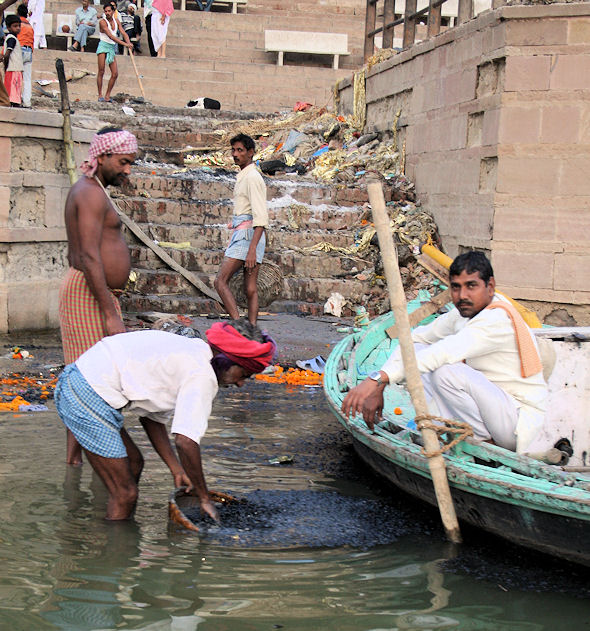
Abb.: गाङ्गेयम् । Varanasi - वाराणसी, Uttar Pradesh
[Bildquelle: Ross Thomson. --
http://www.flickr.com/photos/rpt/319398709/. -- Zugriff am 2011-09-17.
--
Creative Commons Lizenz (Namensnennung, keine kommerzielle Nutzung,
share alike)]
"These guys are panning for gold teeth and other
valuables in the cremated remains at the bottom of the burning ghat."
भर्मन् - bharman n.: Unterhalt, Lohn, Gold
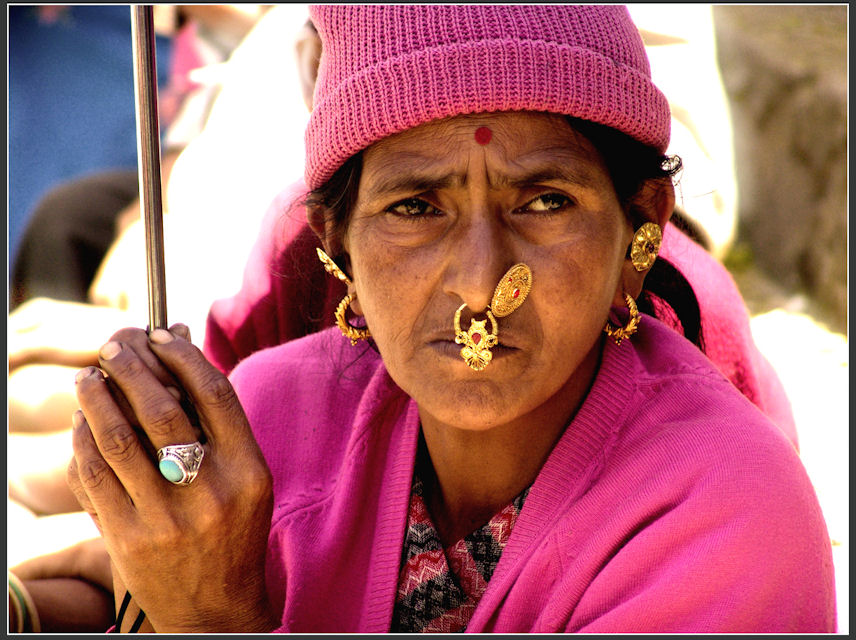
Abb.: भर्म । Gemüseverkäuferin, Sikkim
[Bildquelle: Sukanto Debnath. --
http://www.flickr.com/photos/7487149@N03/536924973/. -- Zugriff am
2011-09-27. --
Creative Commons Lizenz (Namensnennung)]
कर्बुर - karbura n.: Geflecktes, Gold
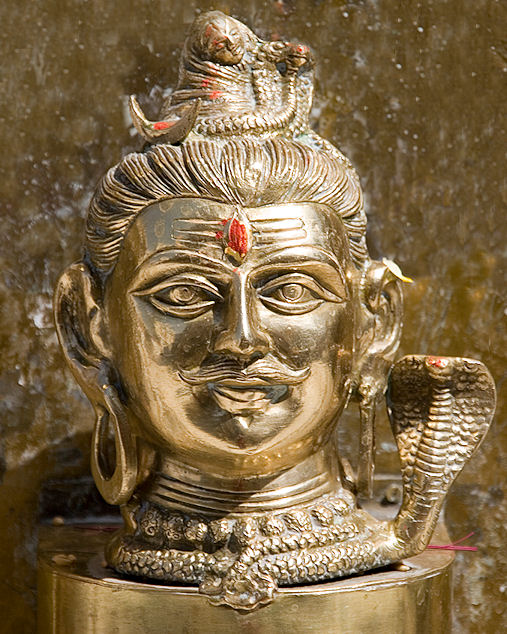
Abb.: कर्बुरम् । Śiva, Jagdish Tempel, Udaipur - उदयपुर, Rajasthan
[Bildquelle: ॐ Dey Alexander ॐ. --
http://www.flickr.com/photos/dey/927764895/. -- Zugriff am 2011-09-27.
--
Creative Commons Lizenz (Namensnennung, keine kommerzielle Nutzung,
share alike)]
चामीकर - cāmīkara n.: Gold
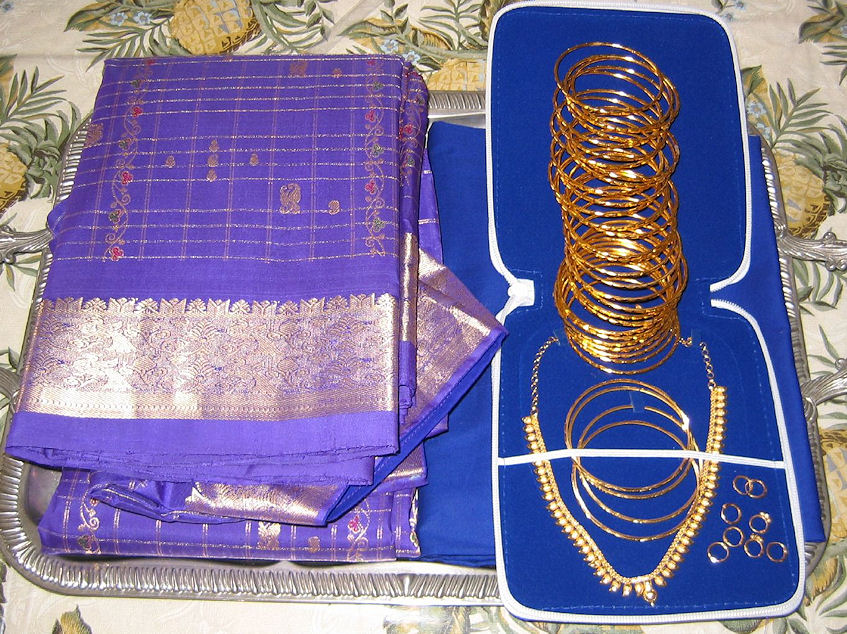
Abb.: चामीकरम् । Traditionelle Geschenke der Familie des Verlobten an
künftige Schwiegermutter, Chennai - சென்னை,
Tamil Nadu
[Bildquelle: Melissa. --
http://www.flickr.com/photos/coral/36326835/. -- Zugriff am 2011-09-27.
-- Creative
Commons Lizenz (Namensnennung, share alike)]
जातरूप - jātarūpa n.: "Gold
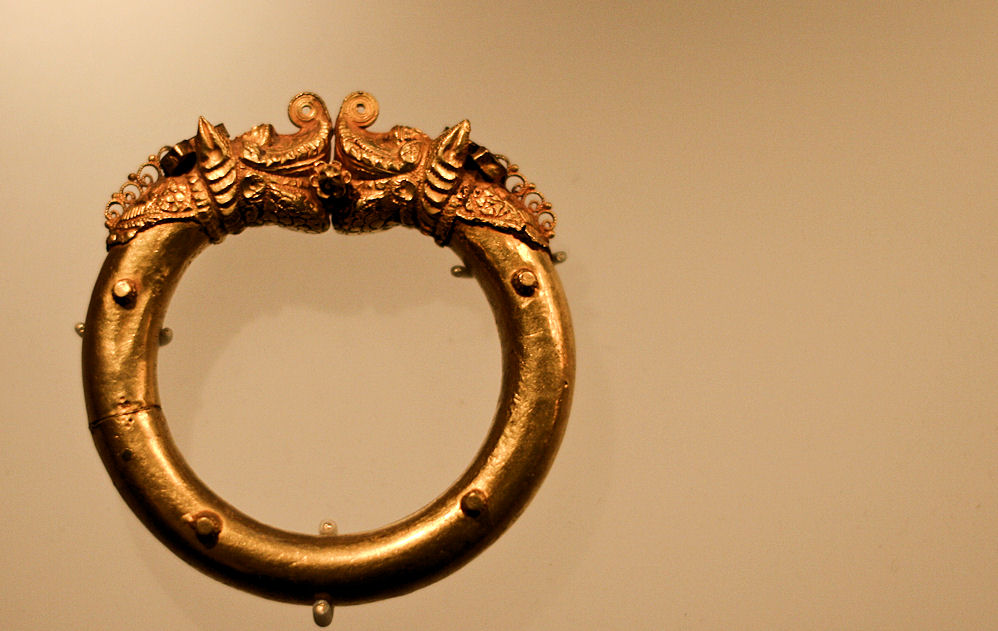
Abb.: जातरूपम् । Armreif, Gujarat, 19. Jhdt.
[Bildquelle: Anne Petersen. --
http://www.flickr.com/photos/opacity/3883676290/. -- Zugriff am
2011-09-27. --
Creative Commons Lizenz (Namensnennung, keine kommerzielle Nutzung,
keine Bearbeitung)]
महारजत - mahārajata n.: "großes Silber", Gold

Abb.: महारजतम् । Hikkaduwa -
काञ्चन - kāñcana n.: Gold
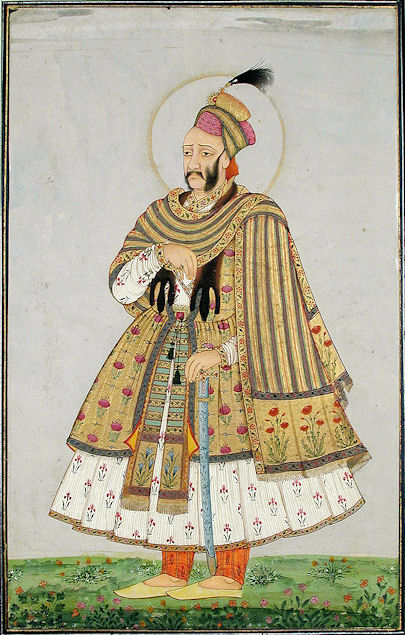
Abb.: काञ्चनम् । Abdullah Qutb Shah (عبداللہ قطب شاہ) (regierte 1625 - 1672)
mit Goldmantel und Goldschal, Golconda, Andhra Pradesh, ca. 1700
[Bildquelle: Asian Curator at The San Diego Museum of
Art. --
http://www.flickr.com/photos/asianartsandiego/4837641347/. -- Zugriff am
2011-09-27. --
Creative Commons Lizenz (Namensnennung, keine kommerzielle Nutzung,
keine Bearbeitung)]
रुक्म - rukma n.: "Glänzendes", Gold
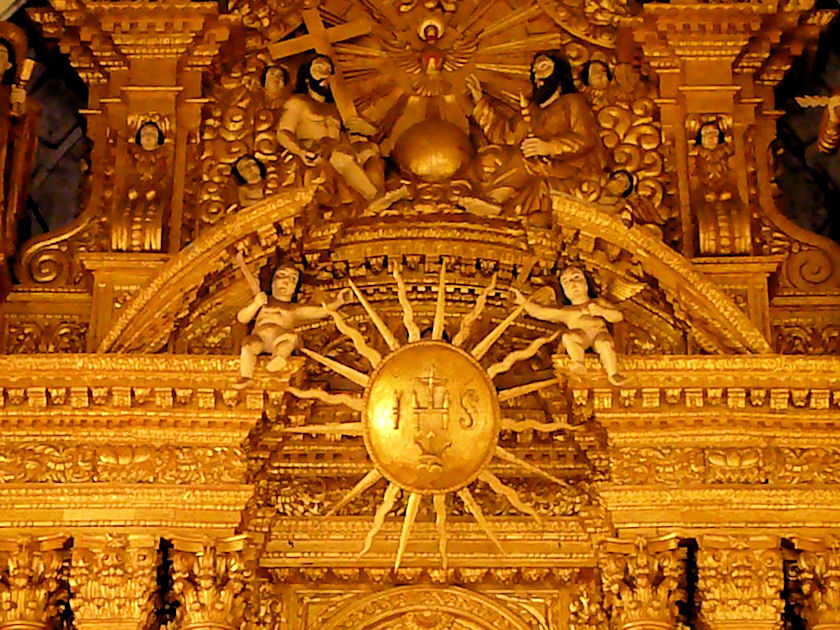
Abb.: रुक्म । Basílica do Bom Jesus, Goa, 1605
[Bildquelle: Shreyas. --
http://www.flickr.com/photos/sravishankar/199496176/. -- Zugriff am
2011-09-27. --
Creative
Commons Lizenz (Namensnennung, keine kommerzielle Nutzung, share alike)]
कार्तस्वर - kārtasvara n.: "[schön] Klingendes", Gold
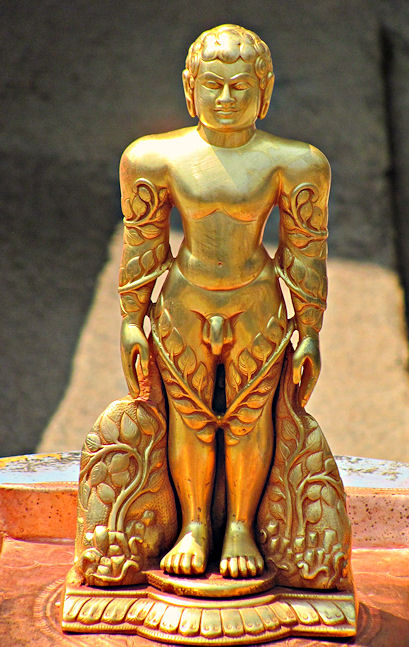
Abb.: कार्तस्वरम् । Gomateshwara (ಗೊಮ್ಮಟೇಶ್ವರ),
Shravanabelagola - ಶ್ರವಣಬೆಳಗೊಳ,
Karnataka
[Bildquelle: Ashok Prabhakaran. --
http://www.flickr.com/photos/freakyyash/4507817456/. -- Zugriff am
2011-09-27. --
Creative
Commons Lizenz (Namensnennung, share alike)]
जाम्बूनद - jāmbūnada n.: Vom Fluss Jambū Kommendes, Gold
अष्टापद - aṣṭāpada m., n.: Achtfüßer, Gold
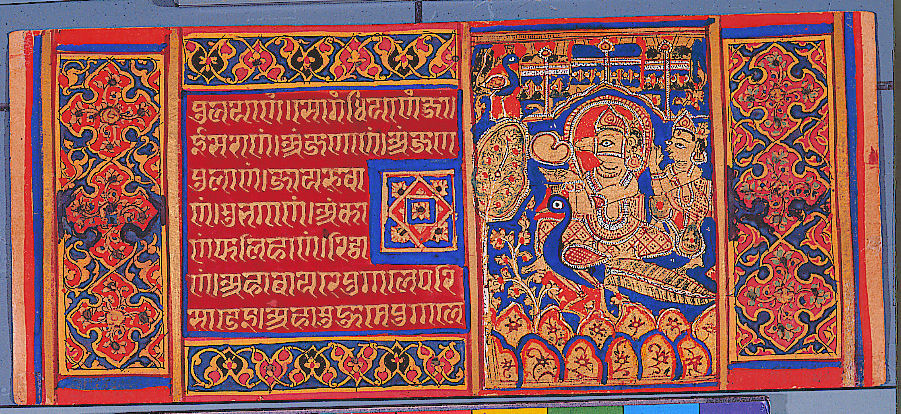
Abb.: अष्टापदम् । Jaina-Kalpasūtra-Handschrift, Gold, Silber und Wasserfarbe
auf Papier, Gujarat, ca. 1475
[Bildquelle: Asian Curator at The San Diego Museum of
Art. --
http://www.flickr.com/photos/asianartsandiego/4835646273/. -- Zugriff am
2011-09-27. --
Creative Commons Lizenz (Namensnennung, keine kommerzielle Nutzung,
keine Bearbeitung)]
"GOLD.
[...]
Gold is almost always found native, but seldom perfectly pure, being alloyed with minute quantities of other metals, which sometimes considerably affect its colour. Sometimes it occurs in combination with silver, constituting electrum; with tellurium in native tellurium ; with silver and tellurium in graphic and yellow tellurium ; and with lead and tellurium in foliated tellurium.
[...]
Native gold is to a large extent obtained from alluvial washings. It is also found disseminated through certain rocks, especially quartz, gneiss, and talcose rocks, and it is often contained in pyrites, constituting the auriferous pyrites ; the detritus affording gold-dust has proceeded from some gold-bearing rocks.
Gold is mentioned as an article of the eastern commerce of ancient times.
[...9
in Ceylon, gold has been discovered at Saffragam. Ilam has been said to be the Tamil name of Ceylon, and to signify gold, but gold in Tamil is Ponnu.
In India, scales of gold are found in the gravel of river-beds over a great extent of country.
On the Malabar coast, in particular, it is widely diffused. The geological formation there is very similar to that which led Sir Roderick Murchison to foretell the existence of gold in Australia. The discovery there in the 19th century, of shafts and adits of unknown miners, shows that the region had long been known as auriferous.
In South India, writes Mr. Burr, gold occurs in Coimbatore and the southern declivities of the Neilgherry Hills. Sir Whitelaw Ainslie (Materia Medica, i. p. 514) mentions that the gold discovered by Mr. Mainwaring in the Madura district, occurs mineralized by means of zinc, constituting a blende. The streams running through the Palghat valley, which unite about 15 miles below Palghatcherry, and form the great Ponany river, all contain gold. In June 1882, Lieutenant Nicolson visited Darampuray, at the foot of the Shevaroy Hills, Sattiamungalum, Donagancottah, Addivarum or Stremogoy, and Metapollum, where gold is found. Natives likewise wash for gold at the branch of the Cauvery which runs past Darampuray. Gold mines are mentioned by Heyne (Tracts, p. .342) as being worked at Suttergul, a few miles from Pungumpilly. At Pulkanath, 14 miles north of Dindigul, just under the east end of the Pulney mountains, gold is found in small particles in the alluvium and sand of a plain at the foot of a small mountain. Mr. Burr mentioned the southern declivities of the Neilgherry mountains as gold districts ; and Dr. Benza stated that gold had been found on the plateau of the Neilgherry Hills, below Gradation Hall.
In 1831, Mr. Sheffield reported that gold-dust weighing 11,449 fanams had been collected in a few of the taluks of Malabar, and that gold is found in all the rivers of the Malabar Province, from the stream which falls into the sea at Elatur, about 8 miles north of Calicut, as far south as the numerous streams flowing through the Palghat valley, which form their junction about 15 miles below Palghatcherry, to the great Ponany river, and some of which reach the southern boundary between Cochin and Malabar about 110 miles to the S.E. of Calicut. Lieut. Nicolson during 1830 and 1831 traced the source of the gold to its matrix in the rocks of the Kundah and Mokurty Hills, and he found many pits 20 to 40 feet in depth, sunk on the different hills in the neighbourhood of Devalla. Agricultural slaves of the Panier caste had, it is said, on several occasions during the last few years come across nuggets of gold, which were of sufficient value to enable them to cease work for two and three years at a time.
Mr. W. King, deputy superintendent of the Geological Survey, examined a considerable portion of the Wynad, finding quartz reef apparently auriferous through a considerable extent of country, and obtained gold at the rate of 26 dwt. to the ton from some of the surface outcrop. The chain more immediately connected with the gold washing is fonned of the Kundah and Mokurty Hills to the S.E. of Calicut and Neilgherries to the east, and the Wynad mountains to the N.E. These send off numerous lateral ranges, between which are chief valleys, in most places closely covered with forest. The most extensive of these is that of Nellumbur, including nearly the whole of the Ernaad taluk, bounded on the E. by the Neilghberries, on the N. by Wynad, on the N.W. by a lateral range running S. from the Ghats called the Wawoot Hills, and on the S. by the Kundah and Mokurty mountains. From these on all sides innumerable mountain streams descend, and, uniting near Nellumbur, form the Beypur river, of considerable magnitude, which falls into the sea about 8 miles to the southward of Calicut. In the mountainous district of Wynad, streams in the same manner descend through every valley, and unite into streamlets and rivers, which fall into the Cauvery in the Mysore and Coimbatore countries, comprising an auriferous tract of 1500 square miles. The part most abundant in gold is at Malealam, near the Mysore frontier, where one grain in every 65 lbs. of earth occurs. In Wynad it is found in the sands of Cherankod, Devalla, Nelyalam, Poneri, and Pulyode.
The Punapoya, or Golden River, rises in the Paral Mallah N.E. of Mokurty, forming part of the main chain of the Neilgherries. The Punapoya descends the mountains between Alliampully and the Carcur Cherum, and long before its formation with the Carambye it receives both the Kellakumpoya and Caracoopova.
In the Nellumbur valley the washings are innumerable ; the principal, however, are in the thickest part of the jungle immediately under the Wynad Hills, and near the villages belonging to the Tirupaad of Nellumbur.
In Mysore there is an auriferous tract near Baitmangalam, at the base of the Baterine Hills. Lieut. Warren of H.M. 33d Regiment, in 1802, found it in the small nullahs or ruts or breaks in the ground at Warrigum, a small village 4½ miles S.W. of Baitmangalum, also on the banks of the Palar river, and the Ponian near Caargory ; and also at Marcupium, 3 miles south of Warrigum, where mines were worked by natives which had also been worked by Tipu. Heyne likewise (p. 41) stated that gold had been found near the hills to the S.E. of Oosoottab. Betwixt Annicul and Punganore it was found disseminated in quartz, and also in the alluvial soil.
Southem Mahratta Country.—About the year 1840, Captain Newbold (p. 44, vol. xi of the Madras Lit. Journal) reported gold washings in the bed of a rivulet at Sattoor, a few miles from Dhoni, in the Kuppatgode range of hills near Damul ; also in the sands of the Hurti rivulet, in the same range, a few miles to the south of Gudduk ; and in the Kir taluk of the Dharwar collectorate, near Chik Mulgund. He also obtained a small button of silver from the auriferous ore collected in the sands near Dhoni, and a grey silver ore in a fragment of quartz. Subsequently, in 1852, Captain Ayton and Mr. Le Souef examined the auriferous tract of the Kuppatgode Hills and reported that it occurs in a broad band of chloritic hornblende, argillaceous and hematitic schists, between two stony bands of granitoid gneiss ; and native gold-washers after the monsoon wash the heavy deposits of crushed quartz (detritus) which the rains bring down.
In the Ceded Districts, black sand mixed with the gold is found in the bed of the river at the village of Canahally, near Bellary. Gold is mentioned as occurring at Suttangul. Heyne, at p. 342 of his Tracts, describes it as having been discovered near Royacottah, not far from Pangampilly, near Hurrydrug. Also a nullah takes its rise about a cos from Bavehully taluk, a hamlet of Mydur, in the Harpunhully taluk, at a hill called Jageracullygoodda ; and there is also another nullah, called Sheghahulla, rising in the same hill, and running into the Baegaly tank, where gold sand was formerly washed, but a man cannot procure more gold than will pay him for his day's labour.
In the Hyderabad Territories, gold occurs at Goodaloor or Godalore, on the Godavery. Dr. Walker (p. 184, vol. xvi. of Madras Lit. Soc. Jour.) mentions its occurrence where the Ramgher and Cummumet Circars meet, and also in several nullahs that feed the Godavery from the south. It is washed for also in the bed of the river nearly opposite Marrigudum, in the Nuggur taluk, also where the Kinarsani nullah falls into the Godavery a little below Badrachellum.
Northern Circars.—Gold washing is carried on at Sumbulpur and Cuttack, and also in the beds of the Mahanadi and its affluents. The natives obtain a little gold by washing in the streams near Vizagapatam, in the Suvarna Rika or stream of the golden sands, the Lanji, the Godavery, and some parts of the bed of the Kistna.
In the Central Provinces gold-dust is found in the beds of rivers at Purnalia, Chutia Nagpur, in the beds of rivers in Manbhum and Palamow, and in the Paiqdhur nullah, in the Seoni district. The little stream rises in the Konye range of hills, and falls into the Wain-Ganga. The natives say they never get more than four annas' worth by a day's work, and would consider it unlucky if they did, as the goddess who is supposed to make it would then leave their locality. It is found in the Balaghat, being washed in the Deo and Sone rivers, in the Sonbera nullah near the Panchera Ghat in the Dhansua pargana, and in the Nara river of the Mau tract, but the quantity obtainable scarcely repays the labourers. It is also washed in the sands of the Banjar river, an affluent of the Nerbadda ; likewise in Bastar from the sands of the Kutri river, and towards Prattapur, and in the forks of the Kutri and Indravati rivers ; also in some of the nullahs of the Chanda district ; and diamonds and rubies were formerly obtained near Wairagurh.
In Afghanistan, gold and lapis-lazuli are found at Huladat near Bamian, and at Istalif north of Kabul, also in the Kabul river, and auriferous rocks occur near Kandahar.
[...]
Gold-dust is imported into the Panjab from Elache in Khoten. Gold is found in Gnari and Guge, Baltistan and Zanskar. Dr. Cleghorn mentions (Report, p. 178) that a little gold-dust is brought across the higher range through Chilaa from the valley of the Indus, where gold washing is carried on to a considerable extent.
[...]
Indus and Panjab. —Gold is obtained from the sands of the Indus ; and between Attock and Kalabagh about 300 persons are employed in washing the sand for gold, which occurs in small flattened grains. The Indus flood of 1842 strewed with gold the fields of Chuch above Attock. Dr. Thomson (Tr. p. 212) found a number of people a little below Khapalu, washing the sand of the Indus for gold; but the work is only carried on during winter, when labour is of no value for other purposes. He purchased for a rupee (paying, he believes, a good deal more than the value) the produce in gold-dust of one man's labour for three weeks. It is found in the districts of Ambala, Kangra, Lahore, Rawal Pindi, Jhelum, Hazara, Bunnu, and Peshawur. It occurs in the form of minutes scales in the sandstone of the Salt Range, a lower range of hills running parallel to the Himalayan chain, between the rivers Indus and Jhelum ; it is also found in small quantities in the sands of the Indus, Jhelum, Beas, and Sutlej ; but the gains are not more than from 3d. to 6d. a day, and the proceeds of the annual lease of gold washing amounted in one year to but £84. The gold washings of the Salt Range are nearly all in the Jhelum district. In the year 1850, 158 cradles were at work, and they were taxed from Rs. 2 to 5 per troon ; the total tax amounted to Rs. 525. In the streams where gold sand is washed, grains of platinum are occasionally found in small quantities ; the gold-seekers call it Safed sona, white gold, and reject it as useless. Platinum has also been found in the Tavi river of Jummoo territory, aud in the Kabul river at Naushera. Gold has been found between Ambala and Kalkah. In the neighbourhood of Patiala is a small mountain stream where gold is washed for, and gold-dust can be obtained from sand in the Srinuggur district, and in the rivers of Kamaon.
Hindustan.—Gold is obtained in the sands of the Gumti river, at the Gandak and Ningti, also those of the Raniganga and its tributaries the Koh and the Phika.
In Assam, at Heerakhond, diamonds occur. Tavemier tells us (Tr. p. 156) that in his time gold 'cormes from the kingdom of Tipra, but it is coarse, almost as bad ns that of China.' Gold-dust is washed for in the Tezpore district. The value of the gold on the spot is Rs. 16 the tola of 180 grains. At the junction of the Dohiri stream with that of the Brahmaputra, about 375 oz. are said to be collected annually. The Brahmaputra was followed from Suddya to Paghat. Gold-dust was found along the banks of the stream, particularly at angles or reaches where the alluvial matter is re-deposited.
[...]
The information given here as to the diffusion of gold in the streamlets of Malabar, the Neilgherries, and Mysore, was also printed in the first and second editions of this Cyclopaedia. It showed that the gold-washers were earning at most about 3d. a day, and offered no prospect of profit to skilled workers. But in 1877 to 1882, speculators formed 26 companies, with capital amounting to about £3,000,000, about half of which went to the sellers of estates. It is the second speculation that has occurred in the Madras Presidency since 1860, the first having been coffee. Gold there is, but, as yet seen, by no means sufficient to meet the heavy demands of skilled labour and machinery. The annual imports of gold into all British India from 1872 to 1882 has ranged in value from £1,443,712 in 1877, to £4,856,392 in 1882."
[Quelle: Balfour, Edward <1813-1889>: Cyclopædia of India and of eastern and southern Asia, commercial, industrial and scientific: products of the mineral, vegetable and animal kingdoms, useful arts and manufactures / ed. by Edward Balfour. -- 3rd ed. -- London: Quaritch. -- Vol. 1. -- 1885. -- S. 1210ff.]
"GOLD. Sans. सुवर्ण, Suvarṇa.
GOLD enters into the composition of a large number of medicines for various diseases. Pure leaf-gold is used. It should be free from admixture of copper and silver, of a red colour when exposed to heat, and of saffron colour when rubbed on touchstone. It is purified by heating its leaves and cooling them alternately with kāñjika, oil, cow's urine, butter-milk and a decoction of horse-gram. Gold is reduced to powder by being rubbed with mercury and exposed to heat in a covered crucible with the addition of sulphur. Two parts of mercury and one of leaf-gold are rubbed together into a mass with lemon juice and placed in a crucible with three parts of sulphur. The crucible is then covered and exposed to heat. This process of mixing the gold with mercury and exposing to heat is repeated fourteen times, when the gold completely loses its metallic character. In books it is stated that the gold should be rubbed with mercury only the first time, and that in roasting it afterwards sulphur alone should be placed in the crucible with the gold, but Kavirāja Binod Lāl Sen tells me that he reduces gold to powder by mixing it with mercury every time it is roasted, and that he repeats the process till the gold is reduced to a dark brown impalpable powder. This powder of gold appears to undergo little change from its metallic state, for on being rubbed on an agate mortar it produces a brilliant yellow stain like that of massive gold, when it is rubbed on touchstone for ascertaining its purity.
Gold thus prepared for medicinal use is considered a valuable tonic and alterative. It is said to increase strength and beauty, to improve the intellect and memory, to clear the voice and to increase the sexual powers. It is used in fever, consumption, insanity, diseases of the nervous system and urinary organs, impotence, etc. Dose, one to two grains.
[...]
Gold is much used as an alterative tonic. Prepared gold in doses of two grains daily with the addition of honey, ghee and emblic myrobalan, or root of Acorns Calamus (vaca) is recommended to be taken for a lengthened period. It is also given to infants under an impression that it will impart strength and beauty to their frames."
[Quelle: Dutt, Uday Chand: The materia medica of the Hindus / Uday Chand Dutt. With a glossary of Indian plants by George King. -- 2. ed. with additions and alterations / by Binod Lall Sen & Ashutosh Sen. -- Calcutta, 1900. - XVIII, 356 S. -- S. 57ff.]
| 96c./d. alaṅkāra-suvarṇaṃ yac chṛṅgīkanakam ity adaḥ अलङ्कार-सुवर्णं यच् छृङ्गीकनकम् इत्य् अदः ।९६ ख। Gold für Schmuck heißt शृङ्गीकनक - śṛṅgī-kanaka n.: "gehörntes Gold", zu Schmucksachen dienendes Gold |
Colebrooke (1807): "Gold for ornaments."
शृङ्गीकनक - śṛṅgī-kanaka n.: "gehörntes Gold", zu Schmucksachen dienendes Gold
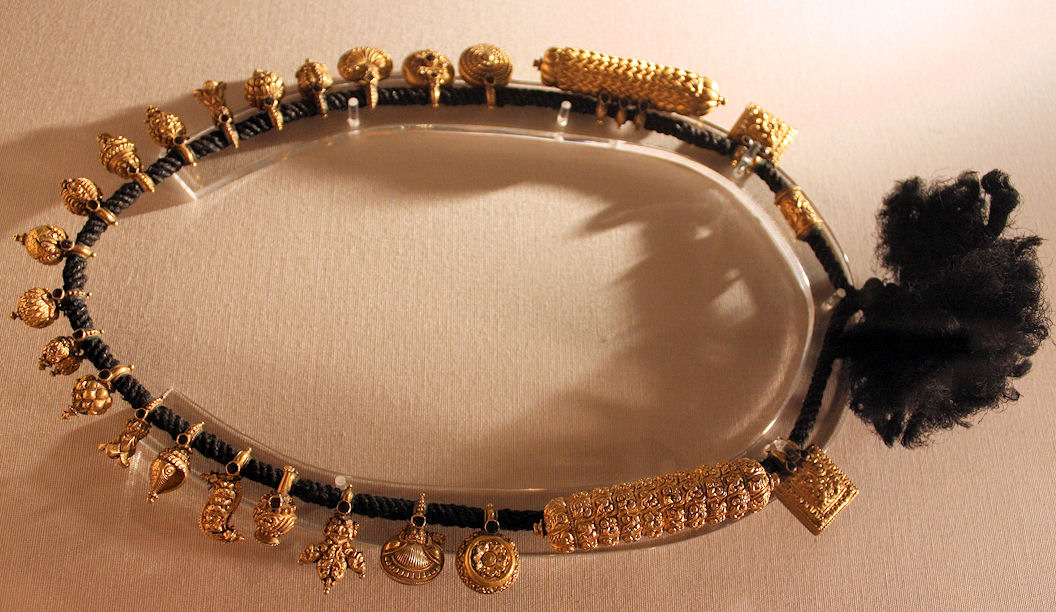
Abb.: शृङ्गीकनकम् । Hochzeits-Halsband, Madurai -
மதுரை, Tamil Nadu, 19. Jhdt.
[Bildquelle: Val_McG. --
http://www.flickr.com/photos/33676549@N04/3311815527. -- Zugriff am
2011-09-27. --
Creative
Commons Lizenz (Namensnennung, share alike)]
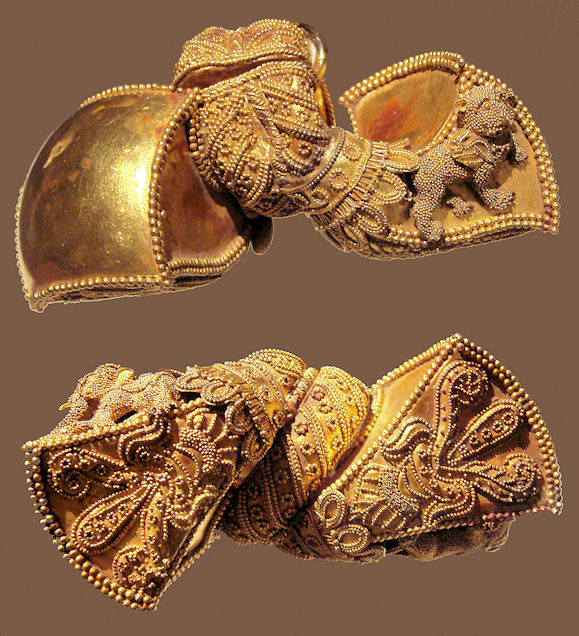
Abb.: शृङ्गीकनकम् । Ohrringe, Andhra Pradesh, 1. Jhdt. v. Chr.
[Bildquelle: PHGCOM / Wikimedia. -- GNU FDLicense]
| 97a./b. durvarṇaṃ rajataṃ rūpyaṃ kharjūraṃ śvetam ity api दुर्वर्णं रजतं रूप्यं खर्जूरं श्वेतम् इत्य् अपि ।९७ क। [Bezeichnungen für Silber:]
|
Colebrooke (1807): "Silver."
दुर्वर्ण - durvarṇa n.: eine schlechte Farbe habend, Silber (Gegensatz zu suvarṇa n.: Gold)
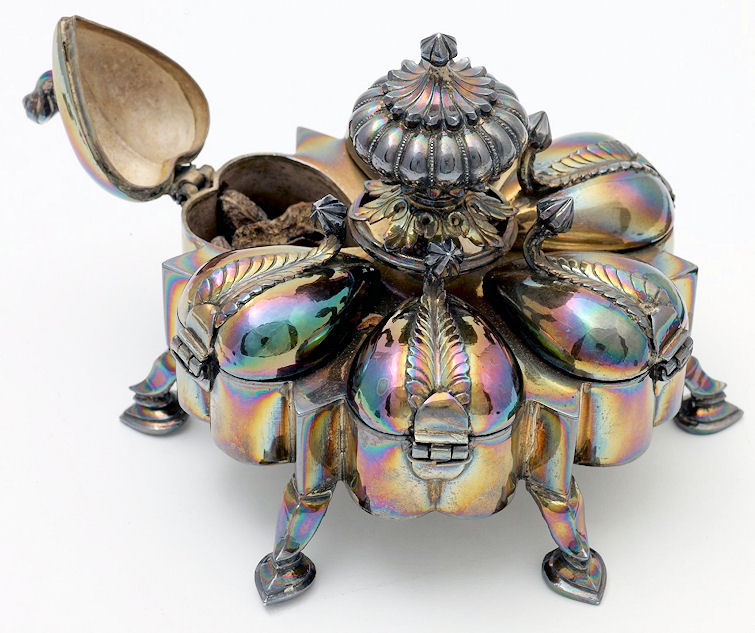
Abb.: दुर्वर्णम् । Gewürzbehälter, Indien
[Bildquelle: Black Country Museums. --
http://www.flickr.com/photos/blackcountrymuseums/4384863508/. -- Zugriff
am 2011-09-27. --
Creative Commons
Lizenz (Namensnennung, keine kommerzielle Nutzung)]
रजत - rajata n.: Silber
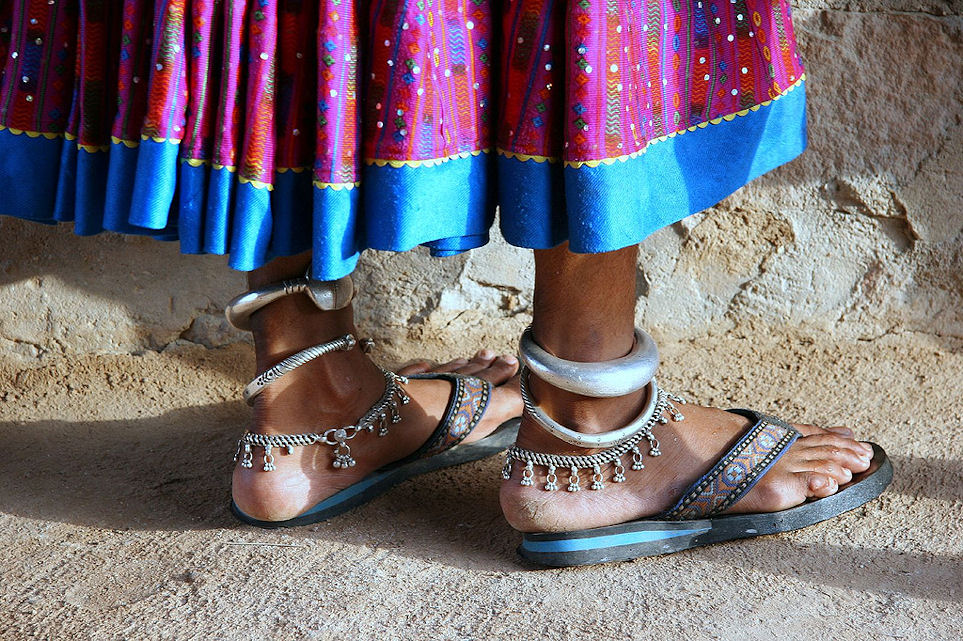
Abb.: रजतम् । Bhadrajun, Rajasthan
[Bildquelle: Tetyana Pryymak. --
http://www.flickr.com/photos/manataka/2618694831/. -- Zugriff am
2011-09-27. --
Creative Commons Lizenz (Namensnennung, keine Bearbeitung)]
रूप्य - rūpya n.: Silber
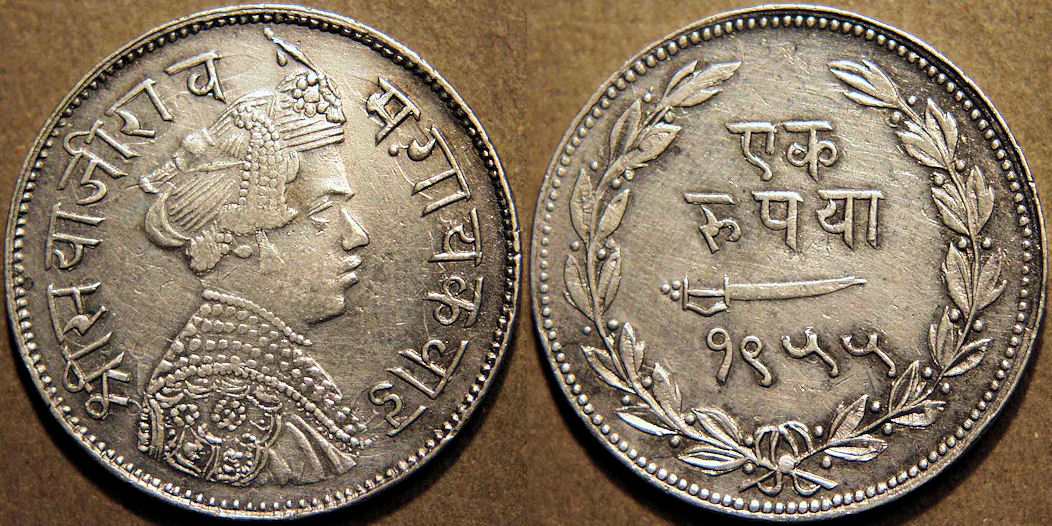
Abb.: रूप्यम् । Eine Rūpee (एक रूपया) von Sayaji Rao Gaekwad III (तिसरे
सयाजीराव गायकवाड) of Baroda (वडोदरा)
(regierte 1875-1939), 1955 V.E. = 1897 C.E., heutiges Gujarat
[Bildquelle: Rani nurmai / Coinindia / Wikimedia. -- GNU FDLicense]
खर्जूर - kharjūra n.: Silber
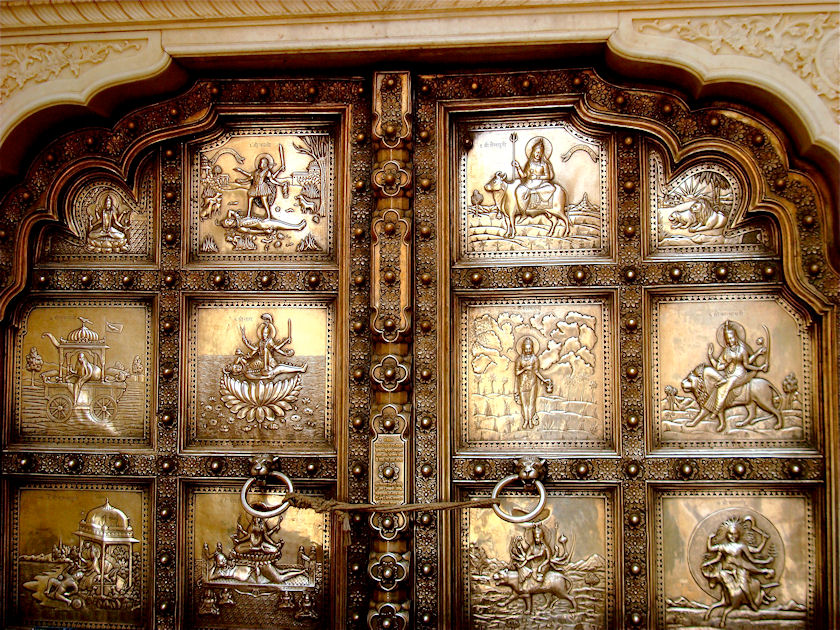
Abb.: खर्जूरम् ।
श्वेत - śveta n.: Weißes
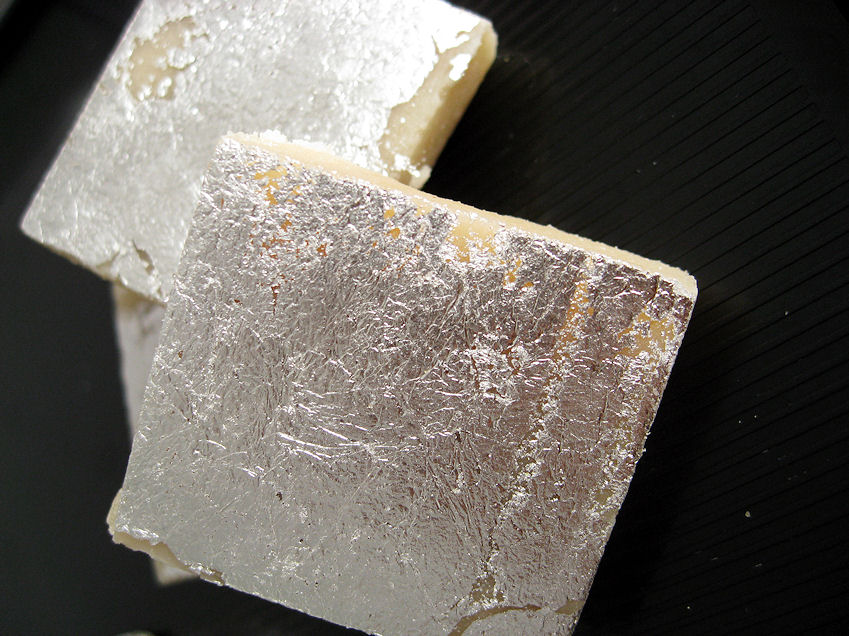
Abb.: श्वेतम् । Versilberte Barfi (बर्फ़ी)
- eine Süßigkeit, Mumbai - मुंबई, Maharashtra
[Bildquelle: Renée S. --
http://www.flickr.com/photos/sifu_renka/2699490785/. -- Zugriff am
2011-09-27. --
Creative Commons Lizenz (Namensnennung, keine kommerzielle Nutzung,
keine Bearbeitung)]
"Silver is one of the most anciently known of the metals. [...] Joshua vi. 18, 19, says, 'And ye, in any wise keep yourselves from the accursed thing. But all the silver, and gold, and vessels of brass and iron, are consecratcd unto the Lord.' It is on this principle that the Brahmanical Hindus act. A Brahman will receive from any caste, however degraded, gold, silver, etc., but to receive from Sudras food or garments, etc., would be considered as a great degradation.
Silver is found native and also combined with sulphur in considerable quantities, also as a chloride, and alloyed with other metals, especially lead, gold, antimony, arsenic, copper. It is separated from its ores by the process of amalgamation, and is largely coined into the money of various denominations of many countries ; it is largely used for ornament and for domestic purposes, and, being little liable to alteration or to be affected by reagents, it is much employed for surgical instruments and for vessels for chemical purposes.
Silver is obtained in many countries. An ore of galena or sulphuret of lead at Jungumrazpillay, in the Kurnool district, is rich in silver. One specimen of the Kurnool ore contained upwards of 1 per cent, of silver, or 374 ounces in the ton, the quantity of lead and silver together being only 45 per cent., which was occasioned by there being a considerable quantity of gangue disseminated through the portion examined. Another specimen from Kurnool was found to contain 175 oz., or 3 dwt. in the ton. This, however, accords with the minute researches of Durochet, who found that when sulphide of silver is associated with the sulphides of other metals, it is always unequally distributed. It is found to be advantageous, to separate the precious metal where it exists to the extent of only 6 ounces in the ton. Mr, W. Mainwaring found it in the Madura district in a native sulphuret of zinc (blende). Captain Arthur discovered this metal in Mysore, both in its native state (in thin plates adhering to some specimens of gold crystallized in minute cubes) and as a muriate in an ore containing sulphur and oxide of iron.
Grey silver-ore occurs in the beds of the rivulets of the Kupputgode range, and Heyne (Tracts, p. 315) states that it occurs in the galena of the Nellore and Calastri districts. Silver occurs in the galena of Kulu. The 'silver country of the Waziri,' in Kulu, covers 677 miles, and abounds in silver ores, some producing 1 in 16 parts of silver. Mr. Ball mentions its occurrence in over twenty British districts.
[...]
There have been in all countries in historic times great changes in the value of silver compared with that of gold. In British India, in the earlier part of the 19th century, a tola (180 grains) of gold could be purchased for 15 or 10 tolas of silver, but in the period between 1870 and 1883, a tola of gold was costing even 23 tolas of silver. Silver has long been selected as a medium of exchange or standard of value ; but at certain periods of history its purchasing power has undergone very great alterations. Between the reign of Edward III. and the accession of Elizabeth, silver rose steadily in value, at the end of that period its purchasing power being double what it was at the beginning. In other words, one ounce of silver at the accession of Elizabeth would buy almost as much as two ounces in the time of Edward III. [...]
The Public Works policy initiated by Lord Dalhousie, the Mutiny, and the demand for Indian cotton caused by the American Civil War, the opening up of China, and subsequently of Japan, all created an extraordinary demand for silver, which the abundance of gold enabled Europe to spare. [...] In the spring of 1866 the American Civil War came to a close. The Southern ports were then opened, American cotton began to arrive in Liverpool, and the demand for the Indian article fell off. In London, between the years 1833 and 1872, the price of a standard ounce of bar silver ranged between 59 3/10 d. and 62 1/10 d. In 1873, the price of silver began to decline, and since then it has been selling as under:
In 1871 peace was declared between France and Germany; in 1873 the German Government announced the demonetizing of silver; in 1874 there was an enormous increase of bullion, £22,000,000, mostly gold. In 1876 there were remarkable fluctuations in rates of Indian exchanges and bar silver, and the latter touched the lowest price on record.
Value of gold and silver imported from, and exported to, foreign countries at ports in British India :
[Quelle: Balfour, Edward <1813-1889>: Cyclopædia of India and of eastern and southern Asia, commercial, industrial and scientific: products of the mineral, vegetable and animal kingdoms, useful arts and manufactures / ed. by Edward Balfour. -- 3rd ed. -- London: Quaritch. -- Vol. 3. -- 1885. -- S. 641ff.]
"SILVER. रूप्य Rūpya. तार, Tāra.
PURE silver, according to Sanskrit writers, should be soft, white, brilliant and ductile. It should not be discoloured by fire. Impure silver, that is, silver mixed with other metals, is discoloured by fire, of a reddish or yellowish colour, and not ductile. Silver is purified in the same way as gold. It is converted into a black oxide by thin silver leaves being mixed with twice their weight of cinnabar, and heated in the subliming apparatus, called Urddhapātana yantra. This process is repeated fourteen times. The resulting compound is a fine greyish black powder with minute shining white particles intermixed with it. On chemical analysis it is found to consist of the black oxide of silver. The properties of silver thus prepared are said to be allied to those of gold but somewhat inferior. It is generally used in combination with other metals, such as gold, iron, etc. Dose, grains one to two."
[Quelle: Dutt, Uday Chand: The materia medica of the Hindus / Uday Chand Dutt. With a glossary of Indian plants by George King. -- 2. ed. with additions and alterations / by Binod Lall Sen & Ashutosh Sen. -- Calcutta, 1900. - XVIII, 356 S. -- S. 61f.]
| 97c./d. rītiḥ striyām ārakūṭo na striyām atha tāmrakam रीतिः स्त्रियाम् आरकूटो न स्त्रियाम् अथ ताम्रकम् ।९७ ख। [Bezeichnungen für Messing:]
|
Colebrooke (1807): "Brass."
रीति - rīti f.: Strom, Strich (von Gold usw.), gelbes Messing
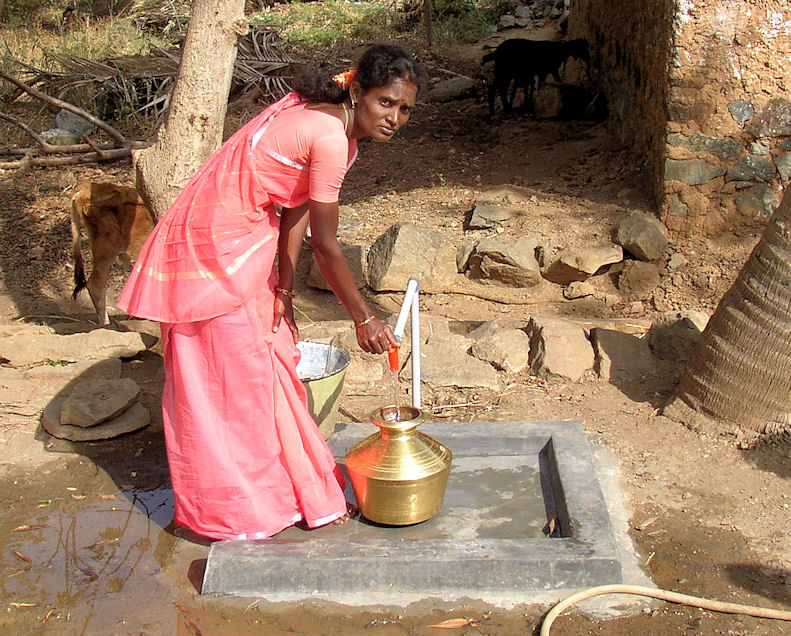
Abb.: रीतिः । Ponnusangampatti Village, Tamil Nadu
[Bildquelle: Marla Smith-Nilson. --
http://www.flickr.com/photos/waterdotorg/3696889084/. -- Zugriff am
2011-09-27. --
Creative
Commons Lizenz (Namensnennung, keine kommerzielle Nutzung, share alike)]
आरकूट - ārakūta m., n.: falsches Erz, Messing
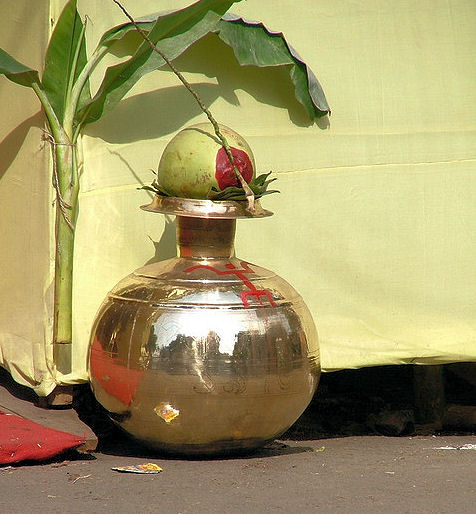
Abb.: आरकूटः । Kolkata - কলকাতা, West
Bengal
[Bildquelle: Lokendra Nath Roychoudhury. --
http://www.flickr.com/photos/lokenrc/239429521/. -- Zugriff am
2011-09-27. --
Creative
Commons Lizenz (Namensnennung, keine kommerzielle Nutzung, share alike)]
"Auspicious signs for Durga Puja at Grey Street,
Calcutta, India : brass pot with vermillion mark of humanity, green coconut,
banana plant. Pot filled with water from River Ganges. 20.10.2004 / 13:36
hrs"
"Messing ist die Sammelbezeichnung für eine Gruppe von Legierungen mit den Hauptbestandteilen Kupfer und Zink. Die Farbe von Messing ist abhängig vom Zinkgehalt und schwankt meist zwischen einem helleren und dunkleren Goldgelb mit großer Farbähnlichkeit zu natürlichem Gold. Bei Zinkgehalten unter 20 % wird Messing bräunlich bis bräunlich-rötlich und bei Gehalten über 36 % hellgelb bis fast weißgelb. Eine ähnliche Legierung aus Kupfer und Zinn wird als Bronze bezeichnet."
[Quelle: http://de.wikipedia.org/wiki/Messing. -- Zugriff am 2011-09-27]
"Brass is an alloy of copper and zinc, generally the yellow alloy, with about an equal weight of zinc and copper, called yellow brass ; copper alloyed with about one-ninth its weight of tin is the metal of brass ordnance or gun-metal. Similar alloys used for the brasses or bearings of machinery are called hard brass, and when employed for statues or medals they are called bronze.
Brass is extensively used in India for domestic utensils, and is in greater request than copper among the natives. Generally, Mahomedans use copper, and Hindus brass utensils. In the Panjab, for smaller work, they prepare the alloy in their own kuthali, or crucibles ; for making the larger sizes, however, the gagara, shamadan, etc., they prefer the fine sheet metals imported from Europe. A metal giving a beautiful sonorous ring when struck, and called Phul or Khani, is made in the Panjab ; Roin, a genuine bell- metal, is also manufactured ; also an alloy called Barth, and an inferior one called Kuth. A good brass may be made by fusing two parts of copper and one of zinc ; but various proportions should be used according to the purpose required. The substances used in alloying are in various proportions by native braziers to form brass, gun-metal (lokam), pewter (satki), bell-metal (kansu), and bedery ware. Occasionally silver is added to form gongs and bells. In general, however, the proportions used are regulated by reducing the quantities of the more expensive and increasing those of the cheaper metal, as far as may be practicable. Repeated meltings, by drawing off the excess of zinc, leave a good malleable brass ; and for this reason old brass is much sought after by smiths when they desire it for any work requiring it to be particularly malleable. Guns taken at Kurnool were little better than spelter. Ordinary yellow brass is rendered very sensibly harder by a small addition of tin, say a fifth or half ounce to the pound ; on the other hand, by the addition of a like quantity of lead, it becomes more malleable and cuts sharply. Brass becomes a little whiter for the tin and redder for the lead ; the addition of nickel to brass constitutes German silver. Gun-metal (copper and tin), by the addition of a small proportion of zinc, mixes better, and the malleability is increased without materially reducing the hardness. Lead m small quantities improves the ductility of the metal, but at the expense of its hardness and colour; It is seldom added."
[Quelle: Balfour, Edward <1813-1889>: Cyclopædia of India and of eastern and southern Asia, commercial, industrial and scientific: products of the mineral, vegetable and animal kingdoms, useful arts and manufactures / ed. by Edward Balfour. -- 3rd ed. -- London: Quaritch. -- Vol. 1. -- 1885. -- S. 440]
"BELL METAL AND BRASS.
BELL metal, (कांश, Kāṃśa), as used in medicine, is an alloy of copper and tin. Brass, (पित्तल, Pittala) is an alloy of copper and zinc. They are sometimes used in combination with other metals, and are regarded as tonic and alterative. They are purified and reduced to powder in the same way as copper."
[Quelle: Dutt, Uday Chand: The materia medica of the Hindus / Uday Chand Dutt. With a glossary of Indian plants by George King. -- 2. ed. with additions and alterations / by Binod Lall Sen & Ashutosh Sen. -- Calcutta, 1900. - XVIII, 356 S. -- S. 75.]
| 97c./d. rītiḥ striyām ārakūṭo na striyām atha tāmrakam 98a./b. śulbaṃ mlecchamukhaṃ dvy-aṣṭaṃ variṣṭodumbarāṇi ca
रीतिः स्त्रियाम् आरकूटो न स्त्रियाम् अथ
ताम्रकम् ।९७ ख। [Bezeichnungen für Kupfer:]
|
Colebrooke (1807): "Copper."
ताम्रक - tāmraka n.: Kupfer
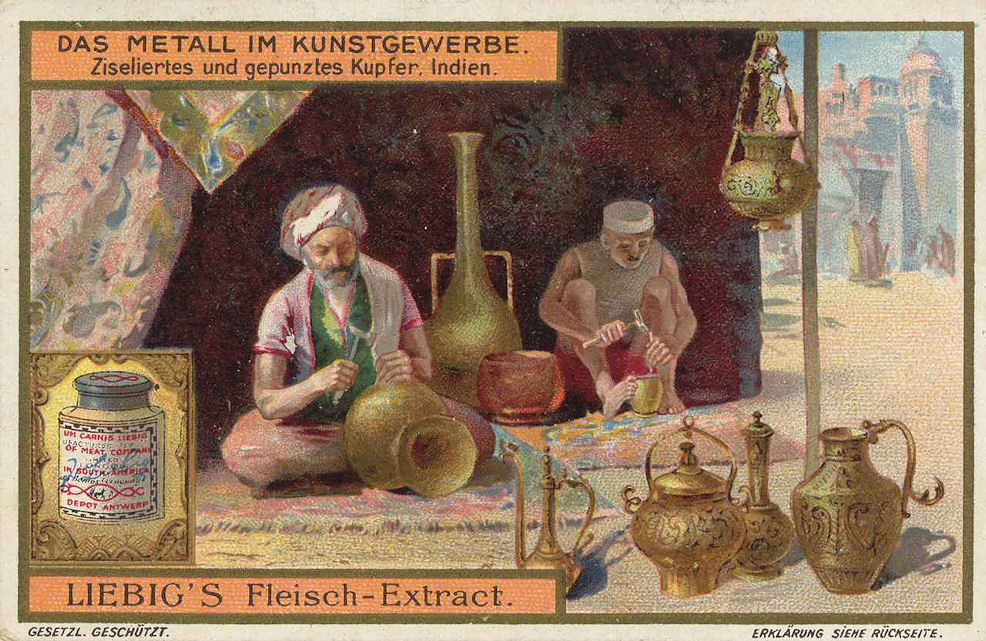
Abb.: ताम्रकम् । Ziseliertes und gepunztes Kupfer, Indien
[Bildquelle: Liebigs Sammelbilder, 1907]
शुल्ब - śulba n.: Kupfer (aus śullbāri : Feind des śulba = Schwefel erschlossen)
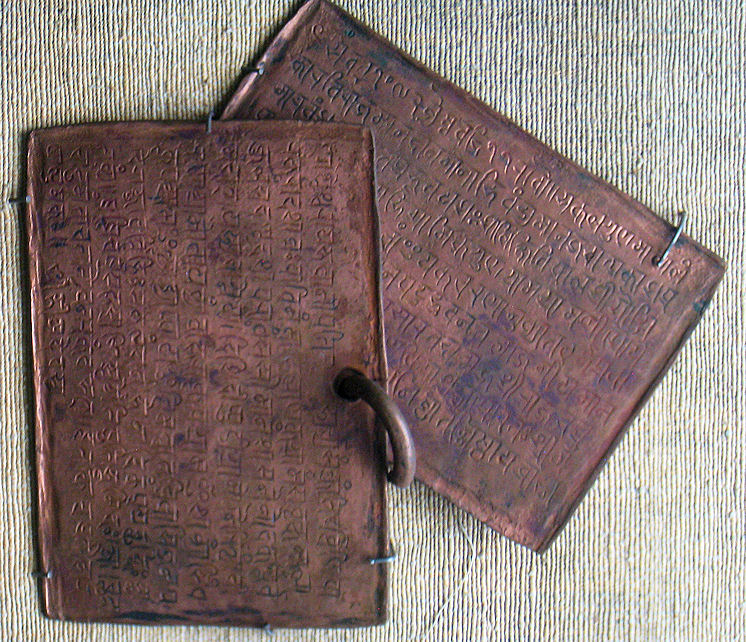
Abb.: शुल्बम् । Kupfertafel, Rāja Caccukka (Paramāra-Vasall), Sanskrit, 1035 n. Chr.
[Bildquelle: Daderot / Wikimedia. -- Public domain]
म्लेच्छमुख - mlecchamukha n.: "Barbarengesicht", Kupfer
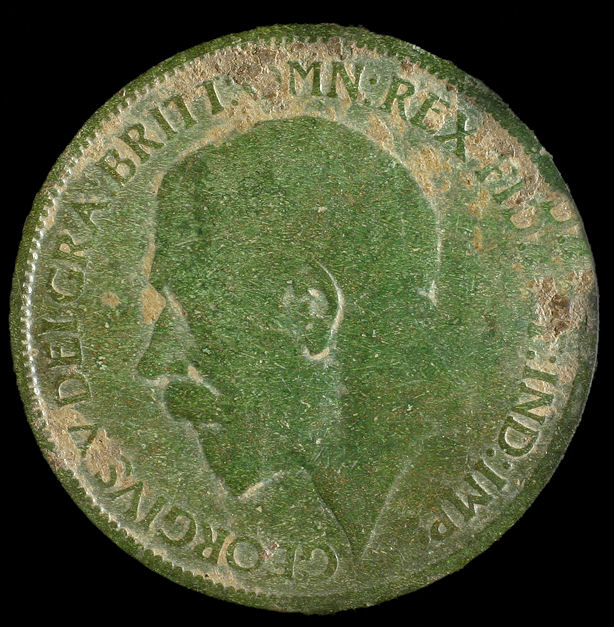
Abb.: म्लेच्छमुखम् । Halfpenny, Georg V., 1918
Aufschrift: Georgius V. Dei Gratiae Brittanicae omnis rex, fidei defensor,
Indiae imperator (Georg V., von Gottes Gnaden König ganz Britanniens,
Verteidiger des Glaubens, Kaiser von Indien)
[Bildquelle: Wessex Archaeology. --
http://www.flickr.com/photos/wessexarchaeology/415422433/. -- Zugriff am
2011-09-27. --
Creative
Commons Lizenz (Namensnennung, keine kommerzielle Nutzung, share alike)]
द्व्यष्ट - dvy-aṣṭa n.: "zweimal acht", Kupfer
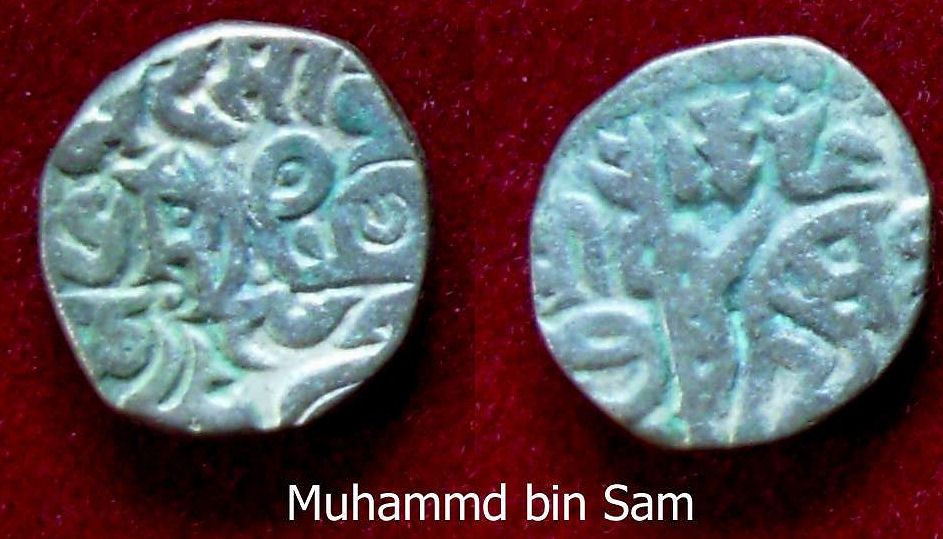
Abb.: द्व्यष्टम् । Kupfermünze, Muhammad von Ghor (1150 - 1206) (سلطان
شہاب الدین محمد غوری)
[Bildquelle: Drnsreedhar1959 / Wikimedia. -- GNU FDLicense]
उदुम्बर - udumbara n.: Ficus racemosa L. 1753 - Cluster Fig, Kupfer (nach der Farbe der reifen Frucht der Ficus)
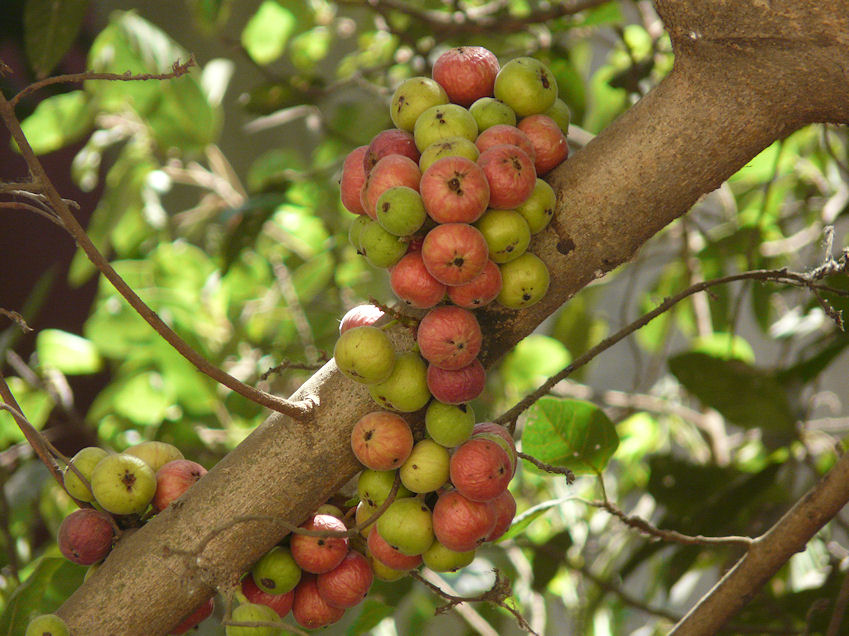
Abb.: उदुम्बरम् । Ficus racemosa L. 1753 - Cluster Fig
[Bildquelle: dinesh_valke. --
http://www.flickr.com/photos/dinesh_valke/2520246287/. -- Zugriff am
2011-09-27. --
Creative
Commons Lizenz (Namensnennung, keine kommerzielle Nutzung, share alike)]
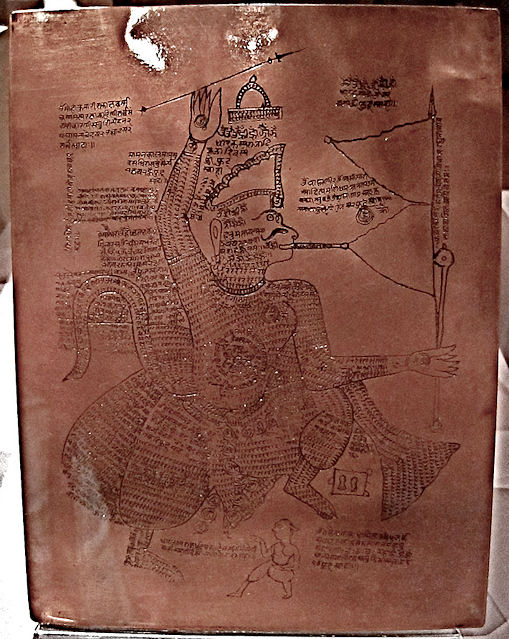
Abb.: उदुम्बरम् । Hanumān, Rajasthan, 18./19. Jhdt.
[Bildquelle: ellenm1. --
http://www.flickr.com/photos/ellenm1/3733253597/. -- Zugriff am
2011-09-27. --
Creative Commons Lizenz (Namensnennung)]
वरिष्ट - variṣṭa n.: das Beste, Kupfer
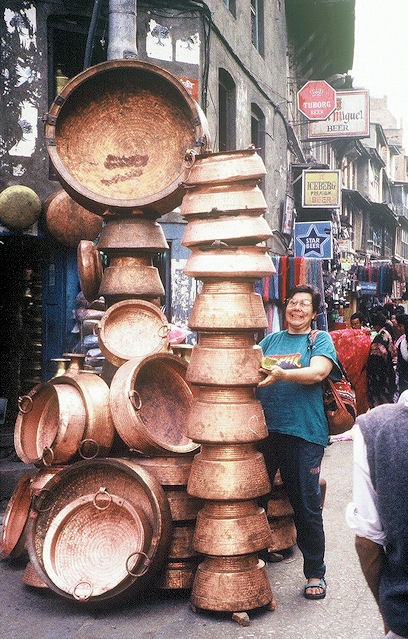
Abb.: वरिष्टम् । Kathmandu - काठमांडौ,
Nepal
[Bildquelle: Barbara Backyard. --
http://www.flickr.com/photos/ladouseur/55225147/. -- Zugriff am
2011-09-27. --
Creative
Commons Lizenz (Namensnennung, keine kommerzielle Nutzung, share alike)]
"Copperore is abundantly diffused in nature, being found native as an oxide, a sulphuret, a sulphate, carbonate, arseniate, and phosphate, in Persia, Baluchistan, Nepal, Kashmir, Tibet, India, Sumatra, Borneo, China, and Japan. Copper ore in the form of sulphuret is abundant in Ramgurh in Shekawatti. Near Ajmir, carbonate of copper is found in small veins, and in connection with ores of iron (Genl. Med. Top. p. 169). A silicate of copper occurs in Nellore and Ongole, but not in workable lodes. Copper ores are found in the Jeypore dominions, and in the vicinity of Nejeebabad, Nagpor, and Dhunpur. Copper has been pointed out near Beila, in the province of Luz, on the western frontier of Lower Sind, by Captain Del Hoate and Captain Harris ; in Kamaon, by Lieutenant Gasfurd and Captain Durand ; at Porkee and Dhanpur, by Captain Richards ; at Almorah and in Afghanistan, by Captain Drummond. It is said to have been worked in Cutch.
From Gurgaon there was sent to the Panjab Exhibition a piece of copper pyrites, also specimens of good copper ore from the Hissar district, and of the metal got from it ; from Pelang in Kulu, and from Manikani near Kulu, in the Kangra district, some copper pyrites, and with blue carbonate of copper from Spiti. Copper is found in Kashmir, but is not an article of trade. Iron and copper mines occur at Marma, S.E. of Byans, and the people bring copper pots to barter with the Chaudansi and Byansi races. Copper mines in Kamaon, Garhwal, Nepal, and Sikkim, are worked by the natives on a small scale. Copper has been discovered in Singhana ; in mines in Kamaon and Garhwal. Copper mines occur at Papulee, Pringlapanni, Murbuggettee, and old mines at Kerraye, Belar, Raie, Seera, Toma Cottee, Doberee, and Dhunpore. The Beng. As. Soc. Jonrn., No. 1 of 1851, p. 1, mentions the copper of Deoghur or Byjnath, a small town in zillah Birbhum. The surface veins run east and west, and present the ore in irregular masses of 5/8ths of an inch broad, so much corroded by atmospherical influence as to appear in a soft, friable, red, yellow, and liver-coloured or garnet-coloured earth ; but, upon digging a couple of feet below the surface of the ground, the veins become a compact liver-coloured mass, spangled with shining particles of copper ; the whole enclosed in a soft, friable apple-green, yellow, or white felspathic rock. Traversing the copper from north to south, small veins of lead appear, which occasionally form the containing walls to the copper. Mr. Vincent traced the vein of copper for about 100 feet east and west, and dug to the depth of 2 feet only. With the aid of coal dug from Banslee Kullah in the Rajmahal hills, he smelted some of the ore, which gave a return of 30 per cent, of good copper; inferior specimens, mostly water-worn pieces picked up on the surface, gave 25 per cent.
The mountainous parts of Nepal are rich in mines of iron and copper. The produce of the former is smelted. The copper is of a very superior kind, and was at one time preferred for consumption in the territories of the king of Oudh to that exported from Britain.
In Singbhum, copper ore is found extending over 80 miles to the westward of Midnapur. Three slabs, weighing about 139 lbs., were subjected to lamination, and proved to be well suited in all respects for purposes of coinage. The quality of this metal is decidedly superior to imported copper.
The copper ore of the Nellore collectorate of the Madras Presidency, was called by Dr. Thomson an anhydrous carbonate of copper, containing 60'73 per cent, of black oxide of copper. It occurs in hornblende schist at Bungeral Mettah, and the carbonate, passing into malachite and mountain blue there, and at Gurumany Pentah, Saligherri, and Yerrapully.
The existence of copper ore in the Callastri, Venkatagiri, and Nellore districts, was ascertained by Dr. Heynes about the year 1797, and he described that of Wangapadu.
Copper ore is found about 20 miles east of Kurnool, about 2 miles from the village of Gunny, in the centre of a low range of hills ; also at Sidhout and Badwail."
[Quelle: Balfour, Edward <1813-1889>: Cyclopædia of India and of eastern and southern Asia, commercial, industrial and scientific: products of the mineral, vegetable and animal kingdoms, useful arts and manufactures / ed. by Edward Balfour. -- 3rd ed. -- London: Quaritch. -- Vol. 1. -- 1885. -- S. 805f.]
"COPPER. Sans. ताम्र, Tāmra. Vern. Tāmā.
THIN plates of copper such as can be pierced by thorns are used in medicine. They are purified by being boiled in cow's urine for three hours. Copper is reduced to powder by smearing its thin leaves with a paste of sulphur and lemon juice, beating them into a mass, and exposing to heat in a covered crucible within a sand-bath for twelve hours. The powder thus produced is rubbed with kāñjika and made into a ball, which is introduced into a tuber of Amorpliophallus campanulatus (ola), as in a crucible and roasted. This last process is said to render the copper innocuous and prevent it from causing purging and vomiting when taken internally.
Copper thus prepared is a dark coloured powder, somewhat gritty to the feel. On chemical analysis it is found to consist of sulphide of copper. It is described as an alterative, emetic and purgative, and is used in poisoning, dyspepsia, fever, enlarged liver and spleen, anaemia, skin diseases, diarrhoea etc. Dose, as an alterative, grains two to four. In poisoning prepared copper is given in doses of about twenty-four grains with sugar or honey to cause vomiting.
Copper enters into the composition of several medicines for ague, remittent fever, enlarged spleen etc."
[Quelle: Dutt, Uday Chand: The materia medica of the Hindus / Uday Chand Dutt. With a glossary of Indian plants by George King. -- 2. ed. with additions and alterations / by Binod Lall Sen & Ashutosh Sen. -- Calcutta, 1900. - XVIII, 356 S. -- S. 62f.]
| 98c./d. loho 'strī śastrakaṃ tīkṣṇaṃ pinḍaṃ kālāyasāyasī 99a./b. aśmasāro 'tha maṇḍūraṃ śiṃhāṇam api tan-male
लोहो
ऽव्स्त्री शस्त्रकं तीक्ष्णं
पिण्डं कालायसायसी ।९८ ख। [Bezeichnungen für Eisen:]
|
Colebrooke (1807): "Iron."
लोह - loha m., n.: Kupfer, (später:) Eisen
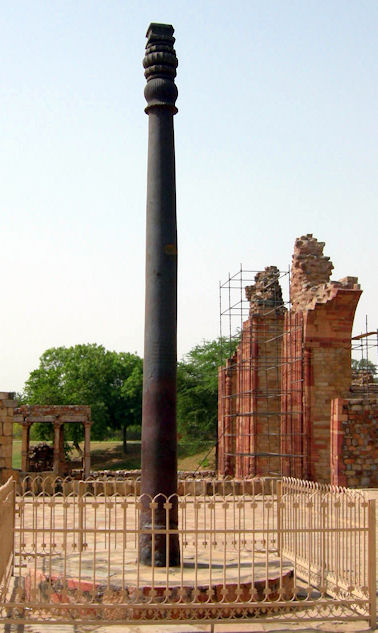
Abb.: लोहः । 7 m hohe, nichtrostende Eisensäule, Delhi, 4. Jhdt. n. Chr.
[Bildquelle: Mark A. Wilson / Wikipedia. -- Public domain]
शस्त्रक - śastraka n.: Schneidendes, Schwert-Metall
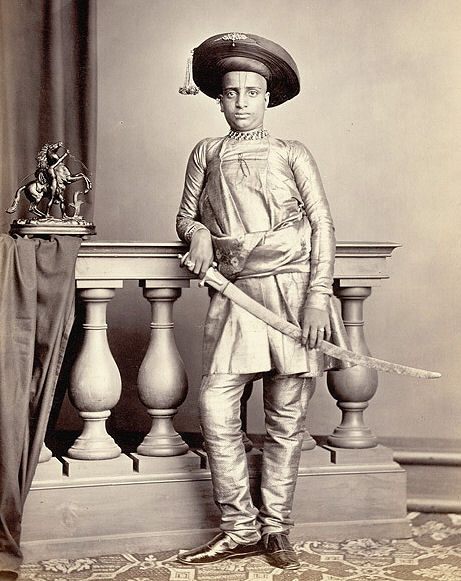
Abb.: शस्त्रकम् । Sohn von S. H. Chunnasee Rajoonath Pant. 186x
[Bildquelle: Bourne and Shepherd]
तीक्ष्ण - tīkṣṇa n.: Scharfes, Eisen, Stahl
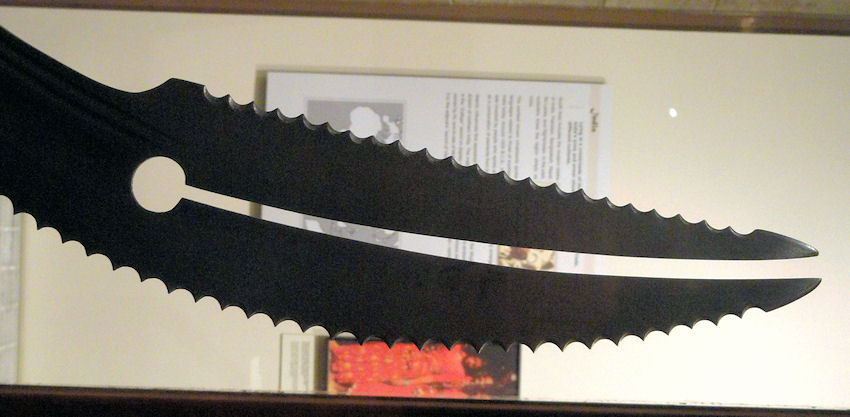
Abb.: तीक्ष्णम् । Schwert (Zulfiqar -
ذو الفقار), Indien, ca. 1800
[Bildquelle: Daderot / Wikimedia. -- Public domain]
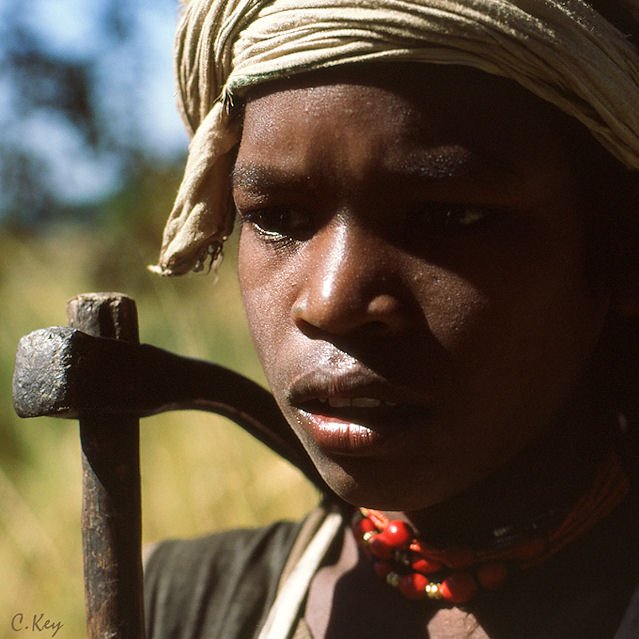
Abb.: तीक्ष्णम् । Muria-Knabe, Bastar - बस्तर, Chhattisgarh
[Bildquelle: Collin Key. --
http://www.flickr.com/photos/collin_key/4556725071/. -- Zugriff am
2011-09-28. --
Creative Commons Lizenz (Namensnennung, keine kommerzielle Nutzung,
keine Bearbeitung)]
"His axe was the pride of this boy. He always carried it
around with himself. He was one of the younger chelik in the ghotul of
Remawand. The tool had been forged by the smith of his village - and even
the iron had been made by him. The Muria blacksmiths master the technique of
melting the metal from the ore of local earth in clay blast furnaces of
about half a man's height. Besides the smith there was also a potter's
family living in Remawand. Elwin says in his study that as a rule the kids
of such craftsmen will not attend the local ghotul. "
पिण्ड - piṇḍa n.: Klumpen, Eisen
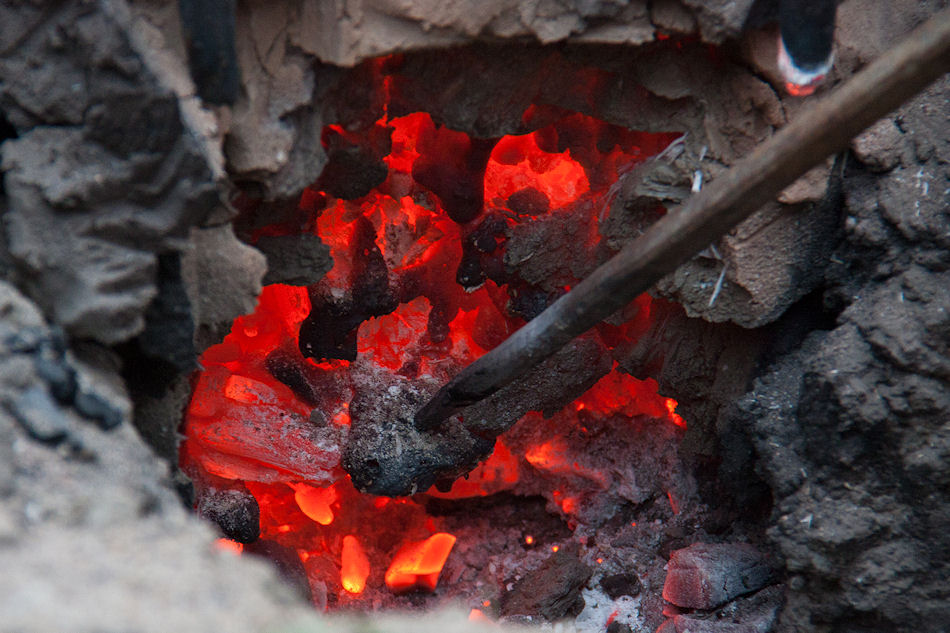
Abb.: पिण्डम् । Eisenschmelzen, Niederlande
[Bildquelle: Hans Splinter. --
http://www.flickr.com/photos/archeon/5079901751/. -- Zugriff am
2011-09-28. --
Creative Commons Lizenz (Namensnennung, keine Bearbeitung)]
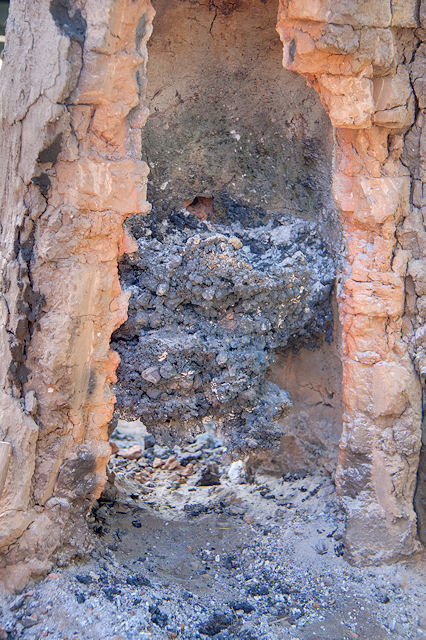
Abb.: पिण्डानि । Geschmolzenes Eisen nach Aufbrechen des Ofens, Niederlande
[Bildquelle: Hans Splinter. --http://www.flickr.com/photos/archeon/5090198337/in/photostream/.
-- Zugriff am 2011-09-28. --
Creative Commons
Lizenz (Namensnennung, keine Bearbeitung)]
"in this opened oven you can see that the iron (still present) stays at one place in the oven while the sand melts and drops to the bottom (is removed here)"
कालायस - kālāyasa n. schwarzes Erz
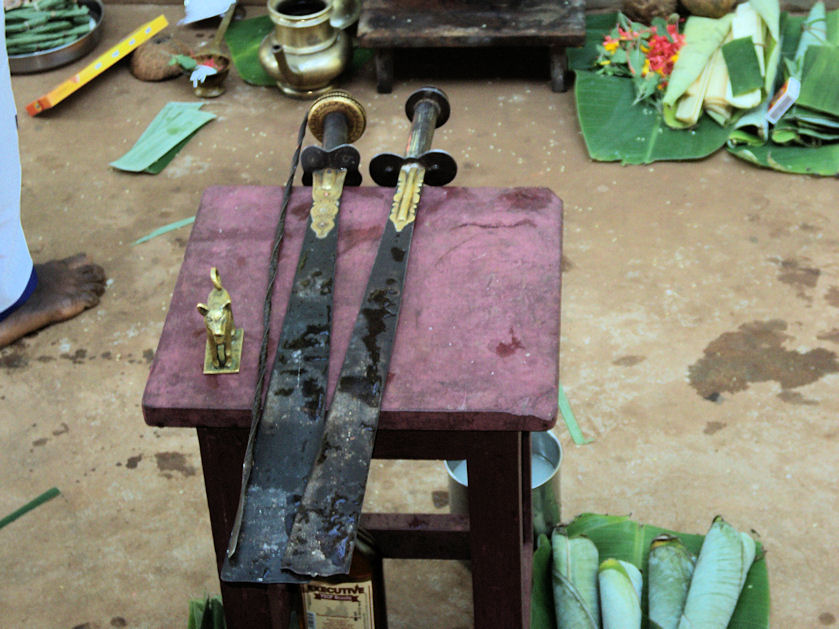
Abb.: कालायसम् । Muthappan Theyyam (മുത്തപ്പന്
തെയ്യം), Kerala
[Bildquelle: Rajeshodayanchal / Wikimedia. -- GNU FDLicense]
अयस् - ayas n.: Erz, Eisen
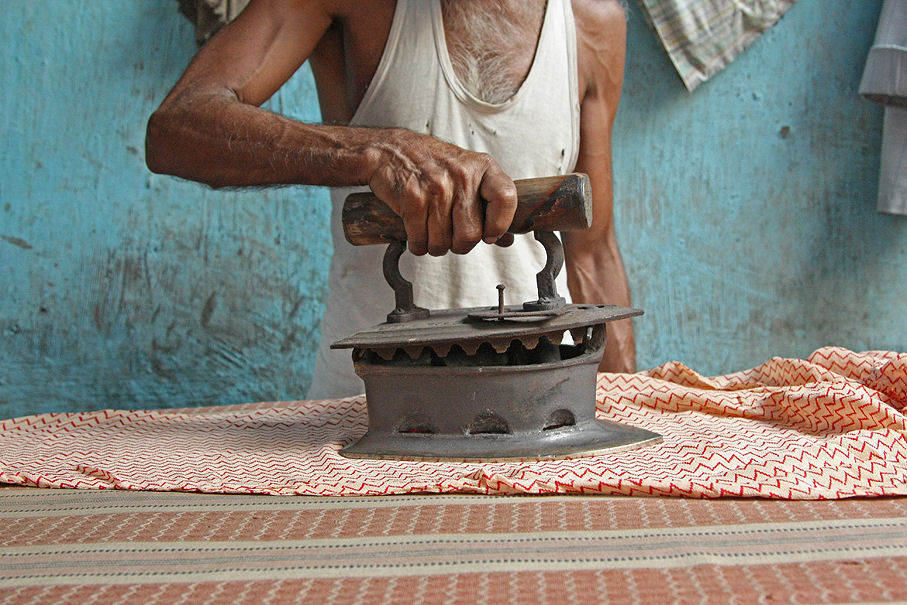
Abb.: अयः । Bügler, Dhobi Ghats - धोबी घाट,
Mumbai - मुंबई, Maharashtra
[Bildquelle: Meena Kadri. --
http://www.flickr.com/photos/meanestindian/4164645211/. -- Zugriff am
2011-09-28. --
Creative Commons Lizenz (Namensnennung, keine kommerzielle Nutzung,
keine Bearbeitung)]
अश्मसार - aśmasāra m.: "Essenz des Steins", Eisen
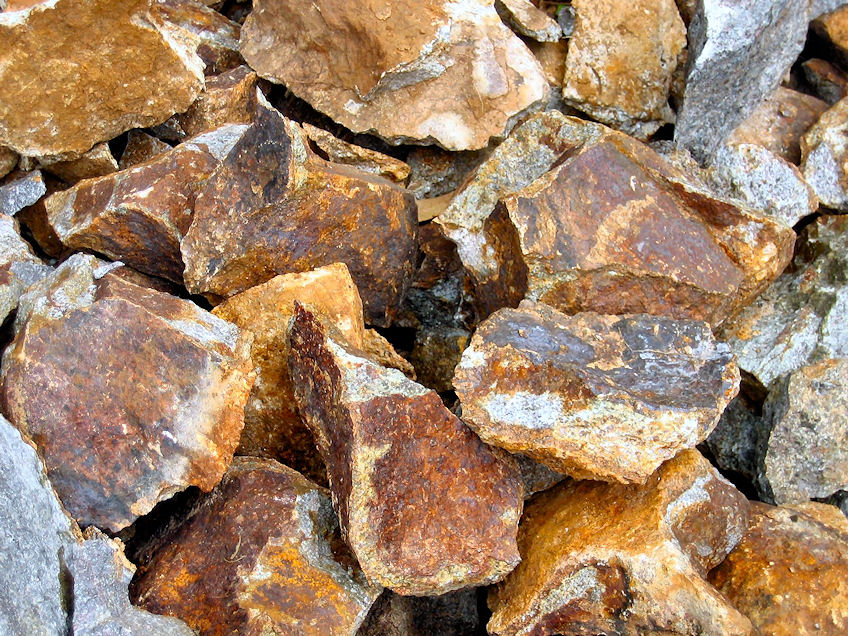
Abb.: अश्मसारः । Nilgiri, Tamil Nadu
[Bildquelle: Jo. --
http://www.flickr.com/photos/joella/363933003/. -- Zugriff am
2011-09-28. --
Creative Commons Lizenz (Namensnennung, keine kommerzielle Nutzung)]
"Iron when found native is supposed to be generally of meteoric origin, but extensively in combination with oxygen or sulphur, as a salt of various acids, as carbonate, sulphate, etc., mixed with earths or other metals.
The iron of commerce is extracted from iron ores. Some of the oxides, as magnetic and specular iron-ore, are heated only with charcoal, as in Sweden, Russia, and the E. Indies, when the carbon combining with the oxygen the iron is set free and melted. The carbonate, iron pyrites, clay iron-ore, red and brown haematites, and spathose iron, are first roasted, and then exposed to a fierce heat in contact with charcoal, coke, or small coal, and a flux, either lime or clay, according as the ore is argillaceous or calcareous. These earthy matters become vitrified, and form a slag at the surface, while the heavy particles of iron, falling down, run out by a hole at the bottom Into moulds, and form pig or cast iron. This is still impure, from the presence of charcoal, sulphur, and portions of silicon and aluminum. It is again twice fused in the refining and puddling furnaces, and exposed to the influence of a current of air at a high temperature, when the whole of the charcoal and sulphur are burnt out, and the other impurities form a slag at the surface. The metal is taken out, beaten or pressed, and then drawn into bars, which form the malleable or wrought iron of commerce.
Iron has long been known in India. From a passage in Kalidasa's drama of the Hero and the Nymph (p. 218), it is clear that the art of welding it was known to the early Hindus.
' You tell me, gentle Nymph, your fair friend pines
With amorous passion. But you do not see
The ardour that consumes this heart for her.
Alike our glowing flame. Then quickly aid
Our union to cement, as close combines
Iron with iron, when each fiery bar
With equal radiance glows.'The iron-smelters of India are low caste, and humble, poor people. They have small clay furnaces, with charcoal for fuel, and the blast is caused by foot or hand bellows of sheep or goat skins, or even of leaves. The smelting process lasts from 6 to 10 hours, but at 3 or 4 separate charges, at the end of which time from 10 to 20 lbs. weight of iron is produced.
Iron-ores abound in almost every district of India, and the prevailing ore is the oxydulous iron, often magnetic, and with polarity ; but specular iron-ore, haematite, clay iron-ore, and sulphuret of iron also occur abundantly. Many of the ores are noted for their singular purity, especially the magnetic oxides. Some are distinctly titaniferous, being in this respect similar to the Taranaki ironsand of New Zealand. But the bulk of the ores of Beypur, Salem, Palamcottah, Penatur, Puducottah, are rich magnetic oxides, and when freed from earthy matter, and ready for the blast furnace, contain about 72 per cent, of iron. They are found in mountain masses, and are obtained by quarrying with a crowbar. They are quite free from sulphur arsenic, and phosphorus, and upon a large average have been found to yield 68 per cent, of metal in the blast furnace. The Punpara and Honore ores were used for the production of steel by the Bessemer process.
[...]
The iron-ore of the Salem districts of the Madras Presidency is a rich magnetic oxide, very heavy and massive. The yield averages 60 per cent, of metallic iron. Much of the ore being a pure black magnetic oxide, would doubtless yield 73 per cent. The ore is, however, often mixed with quartz, which is a very refractory material in the blast furnace. Limestone, and in some places shell-lime, is employed as a flux; and the charcoal of some kind of acacia is the fuel. It occurs there in immense beds 50 to 100 feet thick, and its outcrop can be traced for miles. On one hill six miles from Salem are five bands of magnetic iron-ore from 20 to 50 feet thick.
Magnetic iron-ore of fine quality occurs in Coimbatore, Cuddapah, and Vellore ; magnetic haematites and magnetic iron-sand also in Cuddapah, in the North Arcot district, in the Vellore taluk, at the villages of Pankam, Pulleputt, Anchenamput, Vannanthangal, Vennembutt, Catharercoopum, Vaniembaddy, Satghar, and Strevelliputur ; and magnetic iron-ores occur in the Bellary, Masulipatam, and Mysore districts. Manganese was detected in the iron-ores of Hyderabad, Kurnool, Bellary, the Baba-Booden hills, Mysore, and Vizianagram. Ores of Hyderabad are magnetic.
In the Salem district two varieties of iron are obtained, one remarkable for its softness and malleability, the other for its steel-like hardness, which adapts it for the formation of edge-tools, cold chisels, etc. The following names are given to this metal in process of adaptation to its finished manufacture :—Culties or blooms of iron, Palms or bars of iron, Vuttoms or pieces of cast-steel as it comes from the clay crucibles, Oollies or bars drawn out from the clay crucibles, iron beads which ooze out from the blooms in the blast furnace. Bloom iron from Palghat is readily malleable, and furnishes a hard steel-like iron. It is necessary to subject the bloom to a second fusion and much hammering before they can bring it to the state of the soft malleable iron in which it is met with as an article of commerce. The iron-ores of Coimbatore are of very fine quality, particularly rich in the metal, and highly magnetic.
Dr. Heyne, describing the manufacture of iron in the Karnatic to the south of the Pennar river, says, when first smelted, it is extremely brittle, requiring several operations to bring it into a malleable state. There are two varieties of ore used in the district in which he observed the processes. The one, an iron-sand, collected in the beds of rivers, consists of the protoxide, mixed with much of the peroxide ; the other, a red schist, is almost entirely composed of red oxide, but in the centre of the mass it affects the magnet.
The woods used in Southern India for making charcoal for the iron works at Beypur were the vella-marda, karra-marda, Indian-gooseberry, Poohum, nux vomica, and cassia.
Iron-glance of the hills of Cupputral, in the Ceded Districts, furnishes an excellent malleable iron. Specular iron-ore occurs in the Sandur hills, about 30 miles W. from Bellary. The Bellary district yields a variety of ironores, some of them very rich in the metal, and several of them are associated with manganese. The prevailing ores of iron of this district are the black and grey ores alternating with sandstone, liver-coloured ore (which has been repeatedly sent to Madras as copper-ore), and red jaspery clay iron-stones. They are also associated in the same district, and in the vicinity of Kurnool and Ghooty, with magnesian limestone, grits, conglomerates, aluminous shale, fireclay, and black dolomite.
The principal ores of the Cuddapah district are red, brown, and purple in colour, which yield iron of excellent quality and very malleable. Some of the magnetic iron-ores of the same district are particularly rich in iron, and a few of them contain traces of manganese. Of those from Chemur and Pulevendalah, the latter is magnetic, although earthy and dull red in the fracture, and bright red in the streak. The steel-grey and granular iron-ores of Chitwail, Camalapur, and Gurumcondah are all rich in the metal, and more or less magnetic. The yellow ochre and rusty ores of the Muddenpully taluk are said to yield good malleable iron. The steel-grey iron-sand of Comarole and Yandapully in the Doopaud taluk are highly magnetic, and contain a little manganese. The micaceous iron-ore and iron-glance of the Doopaud taluk are also rich in the metal.
Gunnygull hill ridge, south of Kurnool, is seamed with great veins of very pure specular iron-ore. A great cone-like mass of almost pure specular iron-ore rises out of the base of the northern slopes. Then S.E. of Ramulkota there is a ridge a 'perfect mine of iron ;' but the great local drawback is the scarcity of fuel, of which only a small supply is obtainable from the low and thin jungle in the hilly regions to the southwards. Smelting is carried on at Ramulkota. The ore which is brought from an adjacent hill is massive, roughly granular, coarsely crystallized, and very brilliant. Usually the iron-ore is smelted once in a month, during 24 hours. The furnace is charged seven times during this day and night ; when seven lumps of smelted metal are obtained. The furnace is charged first (a fire being at the bottom) with powdered charcoal. Two large baskets (six or seven large Madras measures) of charcoal are thrown on the fire : then a small basket of pounded ore (74 seers) and six small baskets of charcoal, that is, about a handful of iron and a handful of charcoal alternately, at about an interval of a minute. Nothing else is put in the furnace. The bellows are kept at work for about two or three hours. Then the soft mass of metal is raked out, beaten for a short time with heavy hammers until it assumes the rounded wedge-shaped form usually given to the lump of iron at native furnaces, a deep cut being made in the mass. This lump of metal is about three-quarters of the weight of pounded ore placed in the furnace, and it is worth three rupees. Afterwards it is reduced to bars of workable iron, by being heated four times in the forge, and beaten between each heating. The furnace is a small dome-shaped edifice, almost exactly like the furnaces of the Salem district, both in shape and size.
Numerous iron villages and hamlets are found along the western flanks of the Nullamallays, and several of these furnaces are always at work, the metal being in demand for ploughshares and other agricultural implements, though not for tires of wheels, for which it is found unsuitable. Besides Nerjee stone, the district abounds in serpentine.
Iron-ore, hard and compact, of a light bluish colour, and of excellent quality, occurs in great abundance at Tinnnericottah; brown iron-ore near the Guticondah ; iron-ore in crystals and parallolipods on the surface of rising ground about three miles from Gurjal.
From the neighbourhood of Bomalapur, six or eight miles north of Dorenal in the Guntur district, and all the way to Gompedala near Doopaud for seven or eight miles, the ground is nearly all iron-sand. It is washed and smelted at Ramapotiaro near Dorenal.
The most prevalent iron-ores of the Hyderabad territories seem to be the rusty brown, red, and yellow ochres ; iron or steel sands with manganese, and specular or glance ores,—none of the latter, however, are magnetic. The black, brown, and red cellular iron-ores are abundant. Red haematite is found in the iron clay near Kondapur, and is used in the manufacture of the Wootz steel.
The magnetic iron-ore employed for ages in the manufacture of the damask steel used by the Persians for sword-blades, is obtained from schist near Kona-Samudram around Deemdoortee, where the ore is extensively distributed. The minute scales of iron are diffused in a sandstone-looking gneiss or micaceous schist, passing by insensible degrees into hornblende slate, and sometimes containing amorphous masses of quartz. The strata are much broken up and elevated, so that the dip and direction are in no two places the same, and bear no relation to the mountains in the north. The iron has the remarkable property of being obtained at once in a perfectly tough and malleable state, requiring none of the complicated processes to which British iron must be subjected previous to its being brought into that state. Mr. Wilkinson found it to be extremely good and tough, and considered it superior to any English iron, and even to the best descriptions of Swedish. The Persian merchants, who frequented the iron furnaces of Kona-Samudram, are aware of the superiority of this iron, and informed Dr. Voysey that in Persia they had in vain endeavoured to imitate the steel formed from it.
Ores, powerfully affecting the magnet, exist in great quantity at Taygur, a village of the Konkan. The iron-ore of Rewa Kanta was in former times abundantly worked in the Zillahs of Narukot, Palanpur, Simudra, and Bhilod. The Azuria mines in Jubbulpur are situated on a hill consisting of iron-ore found at 1½ feet from the surface, and extending over an area of about 60,000 yards square and 80 feet deep. The ore exists in thin flakes of a grey-iron colour and metallic lustre. The ore and charcoal are thrown in small quantities every half-hour into an earthen furnace 5 feet high and 3 feet diameter. A part of the bottom of the furnace is filled with fuel only; this being kindled, a pair of bellows is applied to raise the heat, and a passage made at the side of the furnace for the melted metal to run out. Four maunds (320 lbs.) of ore and 2½ maunds of charcoal are daily used in a furnace ; the fuel is used in the proportion of 5-8ths or 62 per cent, of the ore for smelting, and 1-5th more for refining the metal. A furnace furnishes daily 2 maunds (160 lbs.) or 60 per cent of the crude iron from 4 maunds of the ore ; this, when forged, yields 30 seers, or nearly 19 per cent, of wrought iron. The entire cost of the pure metal obtained amounts to Rs. 1.13 per maund, including labour and materials.
Iron-ore, in the form of silicious peroxide, occurs at Tendukhera, Narsingpur. The ore actually worked is a large vein or lode in the limestone of the great schist formation, and the only rock in its immediate vicinity is hard grey and blue crystalline limestone. It occurs to the north of the Nerbadda, in the open flat country between the river and the Vindhya Hills, and at one or two other places in the neighbourhood, also at Mohpani, not far from Tendukhera. The iron is smelted in small clay furnaces, blown by goat-skin bellows, worked by the hand. It is obtained in small lumps or blooms called cutcha or raw iron, and is afterwards reheated and hammered, and then sold as pucka or finished iron. Intermixed with the raw iron as it comes from the furnace, is a sort of crude steel, which is carefully selected and used for the manufacture of tools and agricultural implements. The ore is largely smelted at Tendukhera, about two miles from the mines, where, during the eight dry months of the year, about sixty furnaces are worked. About 5 tons 8 cwt. of iron-ore and 5 tons 12 cwt. of charcoal are used for the manufacture of two tons of pucka or finished iron. The ore contains, upon an average, about 40 per cent, of iron ; it is very fusible. The ore is obtained by means of pits sunk from 30 to 40 feet, through the alluvium of the valley, to the ore. They are washed in during the rains, and require to be resunk yearly. The pucka iron sells at from 5 to 6 rupees (10 shillings) per goan or bullock-load of 3 maunds, equal to 24 bundles, or from £4, 10s. to £5, 8s. per ton. From the iron of these mines, about 1840, a very good suspension bridge was built near Saugor.
At Lohara (Loha, Hind., iron), in the Chanda district of the Central Provinces, there are two localities, five miles apart, where haematite abounds. At the eastern one there is a mass of dense red haematite, forming an isolated hill 120 feet above the level of the surrounding country, which would probably yield 300,000 to 500,000 tons of iron without going below the surface. The other mass is smaller in extent.
Iron-ore, in the form of magnetite or granulated, is found lying on the surface of almost all the high grounds in Chutia Nagpur.
In Bundelkhand and in the Nerbadda valley are large quantities of haematite. An iron-ore called Dbaoo is produced in the land lying between Mouzah Sathu Nurwari of the Gwalior district and Punehar, also in the hills adjoining. The ore is taken to Dhoa and Bugrowlee and other places, where it is smelted. The iron-ores of Gwalior are remarkable for their purity and richness. They are chiefly red iron-ores and magnetite, containing sometimes manganese, but there are also brown iron-ores and silicious haematite. The magnetites contain 70 per cent, of metallic iron, the red iron-ore from 60 to 71 per cent, of iron, the brown iron-ores from 42 to 54 per cent., and the silicious haematites from 45 to 48 per cent, of metallic iron. Of sulphur there are but few traces, and of phosphorus none. The red iron-ores near Suntoro, Maesora, and Dharoli occur, in enormous quantities on the surface of the ground. These ores, it is stated, are especially serviceable for the production of Bessemer cast-steel for rails. There is a large forest in the immediate N.W., which may be calculated to yield 56,000,000 tons of wood, and which, it is estimated, would feed an iron work producing daily twelve tons of finished iron during 900 years.
Abundance of iron-ore is found in the district of Suvibulpore, and it is plentiful in the Cuttack tributary states of Talcher, Dhenkanal, Pal-Lohara, and Ungool, and, indeed, throughout the hilly country bordering the settled districts of this province on the N.W. In Sumbulpore the broken iron-ore is mixed with charcoal, and put into the furnace, about 4 feet high, and made of clay. The fire is maintained by a blast, introduced through a fireclay pipe, which is sealed up with clay after the insertion of the nozzle of the bellows. The slag is raked out, through an aperture made in the ground, and which runs up into the centre of the furnace base. Three men—one to serve the fire, and two to work the bellows—are required to tend each furnace. Talcher and Dhenkanal ores are said to produce very excellent metal, without the aid of a flux. The charcoal used is made from the sal or Vatica robusta. The price of the crude iron in Ungool is a trifle less than one anna per seer.
In S. Mirzapore, Palamow, Singrowlee, and Kewa the ores yield 70 to 75 per cent, of pig-iron. Each furnace is kept in full play all day. Each day, if the smelters have wives and children to break up the ore into ½ or ¼-inch cubes, and bring charcoal, they will charge the furnace four times, and the day's work will be 4 or 5 small malleable pigs of 2 or 2½ seers each, or in all 12 annas to a rupee's worth of iron. They employ no flux. The furnace is emptied at each charge. The metal never runs liquid from the furnace, but falls to the bottom, below the blast tube, from whence it is taken in a flaming mass by a pair of iron tongs, and while incandescent it is hammered on a hard stone or rough iron anvil into a double wedge-shaped pig, the labour being divided between the smelter and his family.
The fuel employed in the Ulwar district in smelting the ore, is charcoal obtained from the dhak tree (Butea frondosa), and costs about 1 rupee for 6 maunds. To smelt 16 maunds of ore, 24 maunds of charcoal are required, and this will yield 4 maunds of iron, valued at 3 rupees per maund.
The part of the Vindhya Hills forming the southern portions of Shahabad, and of Mirzapore, N. and N.W. of the Sone river, together with Mirzapore, south of the Sone, Rewa, Palamow, and, in fact, the whole chain and spurs of the Vindhya range in this neighbourhood, is full of mineral wealth of various kinds. Quarries of the peroxide and proto-peroxide of iron, as also of iron pyrites, abound in the most accessible portions of the Kymore range. The Kymore range is the north-easterly spur of the Vindhya range, and fills all Southern Mirzapore and Shahabad. Some of the ores yield 70 to 75 per cent, of pig-iron.
Some of the best iron in India is produced in Palamow, Rewa, Bidjugghur, and Singrowlee. The iron from the latter place in particular bears a high character in the market, being tough, flexible, and easily worked.
In Bengal, about 6 miles N.E. of the town on the road to Bugodhur, a place on the Grand Trunk Road, is the Silwar Hill, which almost deserves to be called an iron mountain. It stands at the bed of a valley, through which runs the Kunbur river, all along the course of which stream good iron-ore is found in large quantities. About 5 or 6 miles north of Hazaribagh, on the Burbi road, is Sedgua, and here, close to the road, is coal of a very good quality. Iron-ore has been traced in the Kunbur valley for a distance of nearly 30 miles, and the ore is said to have yielded 75 per cent, of the finest metal. So plentiful is the ore, that the Kol and Santal, who work it to procure the material for making kodalies, hatchets, etc., for exportation to the neighbouring districts, never do more than dig a hole to the depth of two, or it may be three feet. Coal, although found near the station, can be procured in any quantity from the banks of the Damuda, and wood can be drawn from the forests and jungles of the Ramgurh plateau.
Hazaribagh iron-ore appears to be of the finest quality, and contains not less than 80 per cent, of pure metal. It also contains a slight admixture of manganese, which would be very useful as a flux where the finest steel, such as would be required for guns, is manufactured. There is a surface of 500 square miles of this ore in the Damuda coal-fields, extending from ten miles south of Hazaribagh on to Turi, and underneath this rich deposit is a layer, supposed to be about 20 feet in extent, of the finest coal in India.
The Agaria, Kol, Santal, and other jungle races smelt with charcoal only, and make no use of the enormous deposits of coal ; their out-turn perhaps amounting to about a maund in a couple of days. A very large quantity of iron of a very fine description is found near Chuttra, one of the principal towns in the Hazaribagh district. Coal is often found within 5 or 6 miles of this place, viz. in the Mahanadi river.
The iron-ores of the Punjab are produced along its N.E. mountain frontier, as well as in the lower hills of the Sulimani and Waziri ranges, and those to the S.E. of the Bunnu district, and to some extent in the Salt Range on the other side of the province, in the hilly portion of Gurgaon district, and in the districts of Simla, Kangra, Dehra Ismail Khan, and Hazara in the Dehli district.
The Mahriili Hill, which yields iron-ore, is one of that group of outliers that forms a continuation as it were of the Aravalli range.
Along the Himalaya frontier, the principal places of production are the Hill States of the Simla district, Jubal, Dhami, Bashahr, and Rampur. At Suket, Chamba, and Mandi, iron is largely produced, and the mines at Shil, Kot Khai, Futtehpur, and Bhir Bangal of Kangra are famous. Mines are worked along the whole range, both on the north and south faces, from the Sutlej to the Ravi. Under the Sikh rule, this iron was extensively used for gun-barrels.
At Kanigorum, in the Waziri Hills, it is found also as a haemaatite in several parts of the Salt Range, and in the Chichalli range, on the other side of the river. The cutlery of Nizamabad and Gujerat is, however, exclusively manufactured with imported steel.
Tin Kamaon ores are from an argillaceous band containing large quantities of red haematite, the ore-bed being 10 to 20 feet thick, and extending for a long distance. The surface deposits supply the greater proportion of ores used by the smelters, but much labour is necessary in the collection.
Magnetic iron-ore is found in considerable quantity about 80 miles N.E. of Dharmsala, Kangra district, close to the sanatorium of Dalhousie. Of the ores of the Chamba Hills, and in the divisions up to the Hazara district included in the Kashmir territories, the best is found at Reyasi in Jammu ; the ore found at Sonf and Kutyar, in Kashmir proper, is not so good.
In the hills due north of Peshawur is the source of the fine Bajaur iron which is used in the manufacture of the gun-barrels of Kohat and Jammu, and in the formation of steel for the blades of Bokhara and Peshawur.
At Sikbhar, in the Darjiling district, is a valuable magnetic iron-ore.
Iron is obtained from the ore found in Shoru Cacharri Mehaul, in Gholagat Sub-division, in Assam, about 15 or 18 feet under the surface of the ground.
[...]
Europeans, in private companies, under Government patronage, and also by Government departments, have made several unsuccessful attempts to establish iron works of the form adopted in Great Britain. The chief of these have been the attempts at Beypur and Porto Novo in 1833 and 1859, in 1874 in the Madras Presidency, with a complete loss to the shareholders ; at Dechauri in the N.W. Provinces, and in Bengal. In 1855 the iron works at Dechauri, in the N.W. Provinces, possessed a well-constructed high furnace ; forest for the supply of charcoal was growing all round them ; they had fair, brown iron-ore at hand, and excellent rich haematite and magnetic ores only 25 miles off, but the work was abandoned. In 1882, the Government of India took the Bengal ironworks off the proprietors' hands, paying the shareholders Rs. 4,30,761. Surgeon-General Balfour, in 1855, reported on the iron-ores of the south of India, and showed that in the competition, to be successful, Indian iron must vie with the iron of Sweden and Russia, and that it is the convenient forms of hoop, and bar, and pig—forms in which wrought-iron is imported—which give British the preference.
[...]
Sulphate of iron is the sulphate of the protoxide of iron, and occurs in the form of green crystals, soluble in water. The salt is formed abundantly by natural oxidation of the sulphuret of iron, a mineral especially common in coal districts. The sulphuret, absorbing oxygen from the atmosphere, is converted into the sulphate of the protoxide of iron ; this is apt to be changed into the red-coloured sulphate of the sesquioxide. It is made artificially on a large scale, for use in the arts, by exposing moistened pyrites to the air. It occurs in the Indian bazars in large masses of green crystals, and in a state of considerable purity. It was known to the ancients, is mentioned in the Amara Kosha of the Hindus, and it is used by them, as by the Romans in the time of Pliny, in making ink. A very cheap green copperas in China is largely used in the mission hospitals as a disinfectant, also in dyeing black, and as an emetic in cases of poisoning. The natives of India have long known the use of acetate of iron, which they prepare by macerating iron in sour palm-wine, orin water in which rice has been boiled."
[Quelle: Balfour, Edward <1813-1889>: Cyclopædia of India and of eastern and southern Asia, commercial, industrial and scientific: products of the mineral, vegetable and animal kingdoms, useful arts and manufactures / ed. by Edward Balfour. -- 3rd ed. -- London: Quaritch. -- Vol. 2. -- 1885. -- S. 371ff.]
"IRON. Sans. लौह Lauha.
THREE varieties of iron are used in Hindu Medicine, namely,
- Kānta lauha or cast-iron,
- Maṇḍūra or iron rust, and
- Lauhasāra or salts of iron produced by iron being kept in contact with vegetable acids.
The form of cast iron used in the manufacture of pans for boiling milk is considered superior to all others for medicinal use.
The small particles of iron which are scattered around when hot iron is beaten on the anvil, are called maṇḍūra. They are allowed to remain in contact with the earth till they become very rusty and brittle, when they are considered fit for use. The properties of maṇḍūra are said to be analogous to those of cast iron.
Lauhasāra or the granules produced on iron plates, smeared with vegetable acids, are also used in medicine. This variety of iron is said to be especially useful in diarrhoea, chronic bowel-complaints, dyspepsia and nervous diseases.
Cast iron is purified by beating it into thin plates, heating the plates in fire and sprinkling them with cow's urine, sour conjee, oil, and a decoction of the pulse of Dolichos uniflorus (kulattha), seven times in succession. The plates are reduced to powder by pounding them in an iron mortar, rubbing them with cow's urine, and roasting the powder in a covered crucible repeatedly till it is reduced to a fine impalpable powder, that will float on water and will not irritate the eyes when applied to them. It is usual to rub the iron with cow's urine and roast it about a hundred times in succession. In some cases it is recommended that iron should be thus roasted repeatedly for a thousand times.
Maṇḍūra is purified and prepared for use like cast iron.
Prepared iron is a fine impalpable powder of a reddish grey or brick-dust colour. On chemical analysis it is found to be a mixture of the proto and peroxide of iron. Dose grains six to twelve.
Iron, it is said, increases strength, vigour and longevity, cures all sorts of diseases and is the best of tonics. When gold and silver are not available, iron is substituted for them. It is used in painful dyspepsia, chronic fever, phthisis, anasarca, piles, enlarged spleen and liver, anaemia, jaundice, obesity, urinary diseases, diseases of the nervous system, skin diseases etc. When iron is administered, the following articles of diet should be avoided, namely, kuṣmānda (fruit of Benincasa cerifera], sesamum oil, kulattha (pulse of Doliclios uniflorus), mustard, wines and acids.
In chronic fever with anaemia, debility, emaciation, enlarged spleen or other complications, several preparations of iron are used, such as the Vṛhat sarvajvara hara lauka, Chandanādya lauha, etc.
[...]
Iron forms an ingredient of hair dyes. The following is an illustration. Take of powdered iron two tolas, mangoe stones five tolas, chebulic and emblic myrobalans two tolas each, belleric myrobalan one tola, rub them together with water in an iron vessel and steep for one night. This paste is applied to grey hairs for turning them into black."
[Quelle: Dutt, Uday Chand: The materia medica of the Hindus / Uday Chand Dutt. With a glossary of Indian plants by George King. -- 2. ed. with additions and alterations / by Binod Lall Sen & Ashutosh Sen. -- Calcutta, 1900. - XVIII, 356 S. -- S. 46ff.]
| 99a./b. aśmasāro 'tha maṇḍūraṃ
śiṃhāṇam api tan-male अश्मसारो ऽथ मण्डूरं शिंहाणम् अपि तन्-मले ।९९ क। Der Schmutz (mala m., n.) an Eisen heißt
|
Colebrooke (1807): "Rust of iron."
"Als Rost bezeichnet man das Korrosionsprodukt, das aus Eisen oder Stahl durch Oxidation mit Sauerstoff in Gegenwart von Wasser entsteht." [Quelle: http://de.wikipedia.org/wiki/Rost. -- Zugriff am 2011-09-28]
"The small particles of iron which are scattered around when hot iron is beaten on the anvil, are called maṇḍūra. They are allowed to remain in contact with the earth till they become very rusty and brittle, when they are considered fit for use. The properties of maṇḍūra are said to be analogous to those of cast iron. " [Quelle: Dutt, Uday Chand: The materia medica of the Hindus / Uday Chand Dutt. With a glossary of Indian plants by George King. -- 2. ed. with additions and alterations / by Binod Lall Sen & Ashutosh Sen. -- Calcutta, 1900. - XVIII, 356 S. -- S. 46.]
मण्डूर - maṇḍūra n.: Eisenschlacke, Rost
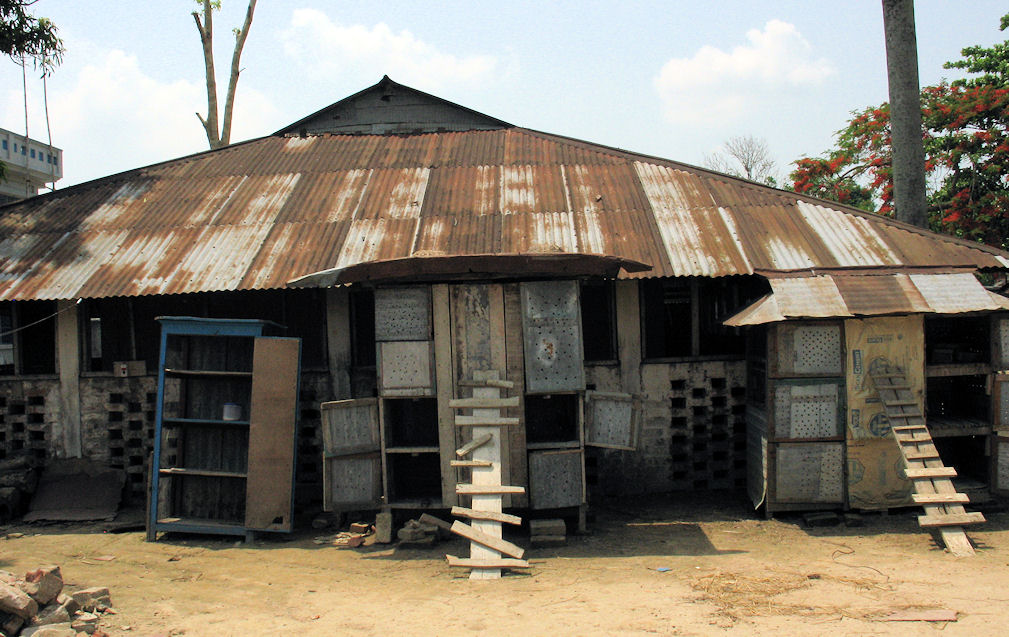
Abb.: मण्डूरम् । Mymensingh - ময়মনসিংহ,
Bangladesh
[Bildquelle: colin. --
http://www.flickr.com/photos/mc_masterchef/141424886/. -- Zugriff am
2011-09-28. --
Creative
Commons Lizenz (Namensnennung, keine kommerzielle Nutzung, share alike)]
शिंहाण - śiṃhāṇa n.: Rotz, Rost
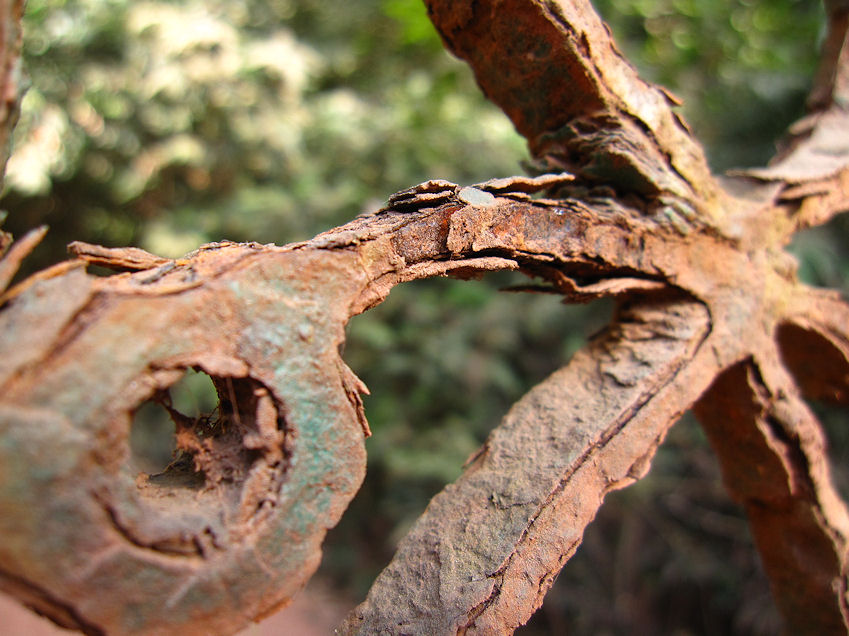
Abb.: शिंहाणम् । Matheran - माथेरान,
Maharashtra
[Bildquelle: Shaun. --
http://www.flickr.com/photos/mulchthief/4540584501/. -- Zugriff am
2011-09-28. --
Creative
Commons Lizenz (Namensnennung, keine kommerzielle Nutzung, share alike)]
| 99c./d. sarvaṃ syāt taijasaṃ lauhaṃ vikāras tv ayasaḥ kuśī सर्वं स्यात् तैजसं लौहं विकारस् त्व् अयसः कुशी ।९९ ख। All das ist
|
Colebrooke (1807): "Any thing metallic."
तैजस - taijasa 3: aus glänzendem Stoff bestehend, metallisch
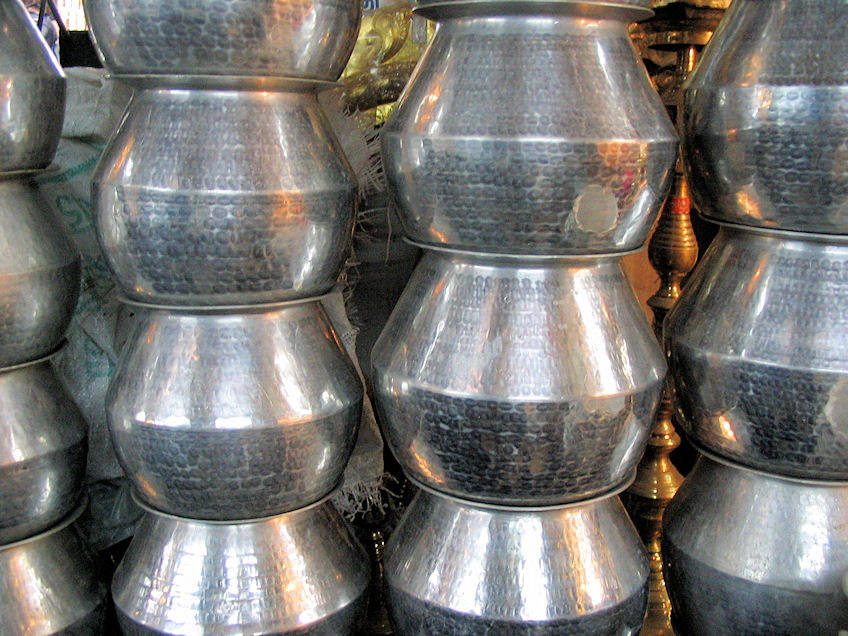
Abb.: तैजसानि । Madurai - மதுரை, Tamil
Nadu
[Bildquelle: abrinsky. --
http://www.flickr.com/photos/abrinsky/101220224/. -- Zugriff am
2011-09-28. --
Creative
Commons Lizenz (Namensnennung, keine kommerzielle Nutzung, share alike)]
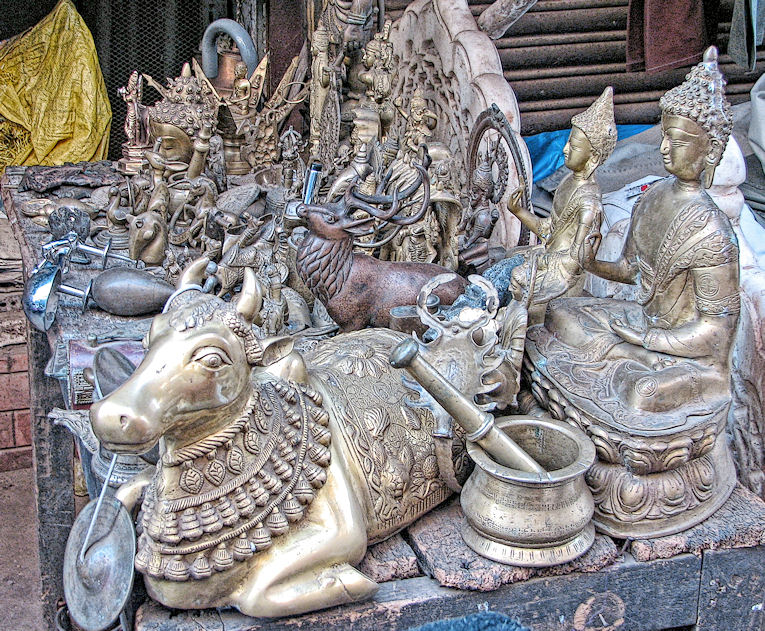
Abb.: तैजसानि । Chor Bazaar (चोर बाज़ार), Mumbai - मुंबई, Maharashtra
[Bildquelle: Eric Parker. --
http://www.flickr.com/photos/ericparker/2108887036/. -- Zugriff am
2011-09-28. --
Creative Commons Lizenz (Namensnennung, keine kommerzielle Nutzung)]
लौह - lauha 3: kupfern, metallen
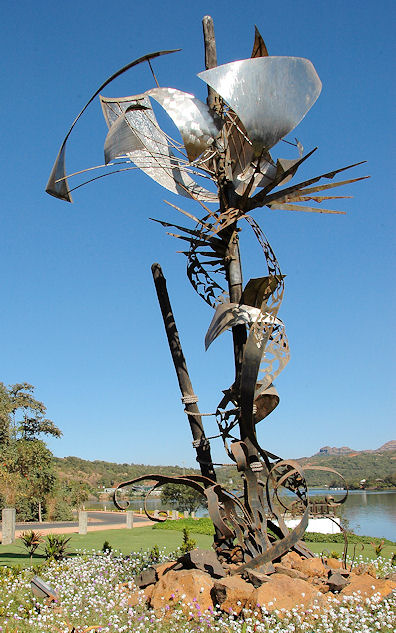
Abb.: लौहम् । Aamby Valley City, Maharashtra
[Bildquelle: Ryan Oriecuia. --
http://www.flickr.com/photos/oreocookies/423142911/. -- Zugriff am
2011-09-28. --
Creative Commons Lizenz (Namensnennung, keine kommerzielle Nutzung)]
| 99c./d. sarvaṃ syāt taijasaṃ lauhaṃ vikāras tv ayasaḥ kuśī सर्वं स्यात् तैजसं लौहं विकारस् त्व् अयसः कुशी ।९९ ख। Bearbeitetes Eisen heißt कुशी - kuśī f.: bearbeitetes Eisen (vermutlich: Schmiedeeisen), Pflugschar |
Colebrooke (1807): "Wrought iron ; bar iron."
कुशी - kuśī f.: bearbeitetes Eisen (vermutlich: Schmiedeeisen), Pflugschar
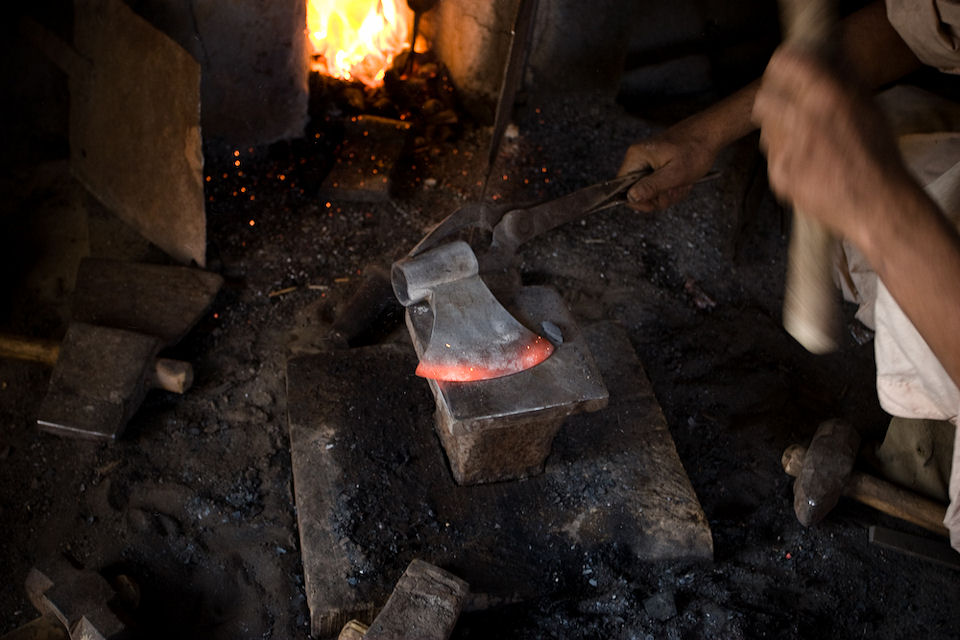
Abb.: कुशी । Bhuj -
ભુજ, Gujarat
[Bildquelle: owenstache. --
http://www.flickr.com/photos/owen-pics/2332617914/. -- Zugriff am
2011-09-28. --
Creative Commons Lizenz (Namensnennung, keine kommerzielle Nutzung,
keine Bearbeitung)]
Zu vaiśyavarga. -- Vers 100 - 106b (Handelsgüter II: Farben, Nichtedelmetalle etc.)